Culture of the United Kingdom
This articlemay betoo longto read and navigate comfortably.(September 2024) |

| Part ofa serieson the |
| Culture of the United Kingdom |
|---|
 |
Theculture of the United Kingdomis influenced by itscombined nations' history;its historicallyChristianreligious life,its interaction with the cultures ofEurope,the individual cultures ofEngland,WalesandScotlandand the impact of theBritish Empire.The culture of theUnited Kingdommay also colloquially be referred to as British culture. AlthoughBritish cultureis a distinct entity, the individualcultures of England,Scotland,WalesandNorthern Irelandare diverse. There have been varying degrees of overlap and distinctiveness between these four cultures.[1]
British literatureis particularly esteemed. Themodern novelwas developed in Britain, and playwrights, poets, and authors are among its most prominent cultural figures.[2]Britain has also made notable contributions tomusic,cinema,art,architectureandtelevision.The UK is also the home of theChurch of England,thestate churchandmother churchof theAnglican Communion,the third-largest Christian denomination. Britain contains some of the world's oldest universities, has made many contributions tophilosophy,science,technologyandmedicine,and is the birthplace of many prominentscientistsandinventions.TheIndustrial Revolutionbegan in the UK and had a profound effect onsocio-economicand cultural conditions around the world.
British culture has been influenced by historical and modern migration, the historical invasions of Great Britain, and the British Empire. As a result of the British Empire, significant British influence can be observed in the language, law, culture and institutions of its former colonies, most of which are members of theCommonwealth of Nations.A subset of these states form theAnglosphere,and are among Britain's closest allies.[3][4]British colonies and dominions influenced British culture in turn, particularlyBritish cuisine.[5]
Sport is an important part of British culture, and numerous sports originated in their organised, modern form in the country includingcricket,football,boxing,tennisandrugby.[6]The UK has been described as a "cultural superpower",[7][8]andLondonhas been described as a world cultural capital.[9][10]A global opinion poll for the BBC saw the UK ranked the third most positively viewed nation in the world (behind Germany and Canada) in 2013 and 2014.[11][12]
History
[edit]Throughout its history, the culture of Great Britain has primarily consisted of the separate native traditions of England, Scotland and Wales. With regard to cultural influences, prior to theexpansion of the British Empire,the island had been most notably influenced byFrench culture(via theNormans),Scandinavian culture(via theVikings) andItalian culture(via theRomans).
The arrival ofCelticandGermanictribes influenced Britain's early development.[13][14]The Celtic peoples introduced unique languages, traditions, and social structures. Subsequently, the migrations of Germanic tribes, such as theAnglo-Saxons,further influenced Britain's cultural landscape. The ancientRoman occupation of Britain,lasting almost 400 years, also impacted the linguistic and cultural identity of Great Britain.[15]
Following the expansion of the British Empire, England, Scotland and Wales absorbed different peoples from around the world, and, post-World War II, Britain developed a more diverse cultural landscape through higher levels of immigration. Furthermore, following theFall of the Berlin Wallin 1989 and EU enlargement in 2004 and 2007, the UK experienced a significant rise in immigration fromEastern Europe.Today, the UK has a sizable immigrant population, and encompasses the cultures of British people from various backgrounds, withSouth Asian,Continental European,AfricanandCaribbeandescent being most prevalent.[16]
Language
[edit]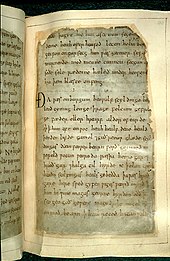
First spoken inearly medieval England,theEnglish languageis thede factoofficial languageof the UK, and is spoken monolingually by an estimated 95% of theBritish population.[17][a]Seven other languages are recognised by the British Government under theEuropean Charter for Regional or Minority Languages–Welsh,Scottish Gaelic,Scots,Cornish,Irish,Ulster Scots,andBritish Sign Language.
In Wales, all pupils at state schools must either be taught through the medium of Welsh or study it as an additional language until age 16, and theWelsh Language Act 1993and theGovernment of Wales Act 1998provide that the Welsh and English languages should be treated equally in the public sector, so far as is reasonable and practicable. Irish and Ulster Scots enjoy limited use alongside English in Northern Ireland, mainly in publicly commissioned translations. TheGaelic Language (Scotland) Act,passed by theScottish Parliamentin 2005, recognised Gaelic as an official language of Scotland and required the creation of a national plan for Gaelic to provide strategic direction for the development of the Gaelic language.[b]The Cornish language is arevived languagethat became extinct as a first language inCornwallin the late 18th century.
Regional accents
[edit]Dialects and regional accents vary heavily amongst the fourcountries of the United Kingdom,as well as within the countries themselves. This is partially the result of the long history of immigration to the UK, for exampleNorthern Englishdialects contain many words with Old Norse roots.[18]Scottish English,Welsh English,andHiberno-Irishare varieties of English distinct from bothEnglish Englishand the native languages of those countries.Received Pronunciationis theStandard Englishaccent in England and Wales, while in ScotlandScottish Standard Englishis a distinct dialect. Although these accents have ahigh social prestige,since the 1960s a greater permissiveness toward regional English varieties has taken hold in education.[19]
The great variety of British accents is often noted, with nearby regions often having highly distinct dialects and accents, for example there are large differences betweenScouseandMancuniandespite Liverpool and Manchester being only 35 miles (56 km) apart.[20][21]Dialectal English is often found in literature, for exampleEmily Brontë's novelWuthering Heightscontains Yorkshire dialect.[22]
Arts
[edit]Literature
[edit]The United Kingdom inherited the literary traditions of England, Scotland and Wales. These includeArthurian literatureand its Welsh origins, Norse-influencedOld English literature,the works of English authorsGeoffrey ChaucerandWilliam Shakespeare,and Scots works such asJohn Barbour'sThe Brus.[23]
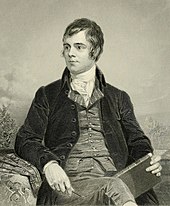
Augustan Age
[edit]The early 18th century period of British literature is known as theAugustan Ageand included the development of the novel.Daniel Defoe'sRobinson Crusoe[25](1719) andMoll Flanders(1722)[26][27]are often seen as the first English novels. Alongside these works,poetryalso flourished, with notable examples such asThe Rape of the Lock(1712) byAlexander Pope,a mock-heroic poem that satirized the social mores of the time.[28]However, the development of the novel took place in a wider literary context that included the rise of prose satires – which reached a high point withGulliver's Travels(1729) byAnglo-IrishwriterJonathan Swift,[29]and earlier foreign works like theSpanishDon Quixote.[30]Other novels by Jonathan Swift includeA Tale of a Tub(1704),An Argument Against Abolishing Christianity(1712), andA Modest Proposal(1729).[29]With the publishing of these books, he gained literary fame and formed lifelong friendships with Alexander Pope,John Gay,andJohn Arbuthnot,who, with Swift, created theMartinus Scriblerus Clubin 1713. Other novels made at this time are:Tom Jones(1749), byHenry Fielding;Pamela, or Virtue Rewarded(1740), bySamuel Richardson;Laurence Sterne–The Life and Opinions of Tristram Shandy, Gentleman(1759–1767). Pamela or Virtue Rewarded, is hailed as one of the first true novels in English literature. The Life and Opinions of Tristram Shandy, Gentleman is an experimental novel.
Also linked to the Augustan period isSamuel Johnson'sA Dictionary of the English Language.Published in 1755, it was viewed as the pre-eminentBritish Dictionaryuntil the completion of theOxford English Dictionary150 years later. Each word defined in detail, with descriptions of their various uses and numerous literary quotes as illustrations. This was the first dictionary of its kind, containing 40,000 words and nearly 114,000 quotes packed together with Johnson's personal touch.[31][32]It is among the most influentialdictionaries,or among most authoritative, in the history of theEnglish languageand considered to be a monumental achievement inlexicography.A group of London booksellers contracted Johnson to write a dictionary for the sum of 1,500guineas(£1,575), equivalent to about £310,000 in 2024.[33]Johnson took seven years to complete the work, although he had claimed he could finish it in three. A warm reception greeted Johnson's Dictionary as it was the first dictionary that could be read with pleasure. The definitions full of wit and depth of thought supported by passages from beloved poets and philosophers, meant a reader could be content spending an evening poring over its pages. Johnson's choice of structure and format has certainly shaped future English dictionaries and lexicons and the role they play in language development.
Richard Steele,another famous author known forcomediesandpamphletsduring the Augustan Period, began his literary career with The Christian Hero (1701), a moral pamphlet that was criticized due to his personal lifestyle, followed by the successful comedy The Funeral later that year. In 1703, he wroteThe Lying Lover,an early sentimental comedy that failed on stage. In 1705, he collaborated withJoseph AddisononThe Tender Husbandand contributed the prologue toJohn Vanbrugh’s The Mistake. Steele’s major breakthrough came in 1709 with the creation ofThe Tatler,a tri-weeklyperiodicalin which he wrote the majority of the essays under the pseudonymIsaac Bickerstaff,aiming to expose societal vices and promote simplicity. Despite its success, The Tatler was shut down in 1711 due to political pressure, prompting Steele and Addison to co-foundThe Spectatorin 1711 andThe Guardianin 1713, solidifying Steele’s role as a leading figure in early British journalism.[34]
Romantic Period
[edit]TheRomantic Periodwas marked by a revival ofpoetryand a focus on emotion, nature, and individualism, responding to the growing rationalism of the Enlightenment. This era gave rise to many literary works that explored the tension between reason and imagination.William WordsworthandSamuel Taylor Coleridge’sLyrical Ballads(1798)[35]is considered a landmark collection, emphasizing the beauty of nature and the primacy of emotion, and marking the official start of theRomantic Movement.Mary Shelley’sFrankenstein(1818), one of the earliest science fiction novels, delves into themes of creation, responsibility, and the consequences of unchecked scientific ambition, framed within Gothic conventions.Jane Austen’sPride and Prejudice(1813) offered a brilliant social satire, critiquing class structures and the courtship rituals ofRegency England,and remains one of the most beloved novels inBritish Literature.Lord Byron’sDon Juan(1819–1824) is a satirical epic poem that details the adventures of the legendary lover, displaying Byron’s wit, irony, and irreverence toward societal norms.
Sir Walter Scott’sWaverley(1814), widely considered the first historical novel, vividly recreates theJacobite Rebellionof 1745, cementing Scott’s place as a major figure in British literature.William Blake’s Songs of Innocence and of Experience(1794) blends art and poetry to explore themes of innocence, experience, and societal corruption, providing a unique vision of the Romantic spirit.Percy Bysshe Shelley’s Prometheus Unbound(1820), a lyrical drama, explores themes of rebellion, tyranny, and human freedom, standing as one of his most radical and imaginative works.Robert Burns,the famed Scottish poet, revived interest in Scots literature with works such asAuld Lang Syne,which celebrated the vernacular tradition. Lastly,Mary Wollstonecraft’sA Vindication of the Rights of Woman(1792) stands as one of the earliest and most influential works of feminist philosophy, advocating for women’s education and equal rights in a male-dominated society.
Although primarily associated with theVictorian Era,Lewis Carroll’sAlice’s Adventures in Wonderland(1865) emerged from the later part of this broader Romantic tradition, blending imaginative fantasy with playful wordplay. This whimsical novel follows young Alice’s journey through a dreamlike world populated by peculiar characters, exploring themes of logic, absurdity, and identity. Alice’s Adventures in Wonderland remains a pioneering work of literary nonsense, captivating readers with its inventive narrative and surreal exploration of the boundaries between reality and imagination.
Victorian Era
[edit]The lateGeorgian EraandVictorian erasaw a renewed focus on the novel. A key theme of these novels was social commentary. Early in the periodJane Austensatirised the lifestyle of the gentry and nobility, while the later novels ofCharles Dickensoften used humour and keen observations to criticise poverty and social stratification. One of his novels,Oliver TwistdescribesVictorian Timesand the sordid lives of criminals and exposes the cruel treatment of the many orphans inLondon.Another novel by Charles Dickens,Great Expectations(1861), is abildungsromanthat follows the life ofPip,an orphan navigating ambition, love, and personal growth while critiquing social mobility and class divisions.Charlotte Brontë’sJane Eyre(1847) blendsGothicromance with social commentary, focusing on a young woman’s quest for independence against the rigid structures ofVictorian society.The threeBrontë sistersandGeorge Eliotcommented onNorthern Englandand theMidlandsrespectively, though all four women wrote under male pen names during their lifetimes, partly to deflect anti-feminist criticism. Nevertheless, openly female authors achieved considerable success in the period, such as the predominantly religious poems ofElizabeth Barrett BrowningandChristina Rossetti.George Eliot’sMiddlemarch(1871–1872), often regarded as one of the greatest English novels, explores themes of politics, marriage, and ambition in the setting of a provincial English town.
Elizabeth Gaskell’sNorth and South(1854–1855) contrasts the industrial north with the agricultural south, addressing issues such as class conflict, industrialization, and gender roles.Thomas Hardy’sTess of the d’Urbervilles(1891) offers a tragic critique of Victorian society’s treatment of women, sexuality, and class, whileOscar Wilde’sThe Picture of Dorian Gray(1890) examines themes of aestheticism, morality, and vanity in a Gothic narrative where the protagonist’s portrait ages as his soul corrupts. InRobert Louis Stevenson’sThe Strange Case of Dr. Jekyll and Mr. Hyde(1886), the novella delves into themes of duality, identity, and morality through the split personality of its protagonist.Arthur Conan Doyle’sThe Adventures of Sherlock Holmes(1892), a group of short stories, which popularised the detective genre and introduced one of literature’s most iconic characters: Sherlock Holmes.
Rudyard Kipling's literature exemplifies theBritish Empire’s influence onBritish literaturethrough his works that often reflect the ethos ofimperialismandcolonialism.His novelsThe Jungle Book,which is considered to be classic piece of literature, andThe Man Who Would Be Kingare both set inBritish India,showcasing the cultural and political impact of British rule in the region. His poem If— famously captures the concept of the “stiff upper lip,” a British ideal of stoicism and self-discipline. Additionally,The White Man’s Burdenconveys a white supremacist and imperialist perspective, encouraging the colonial domination of non-European peoples under the guise of a civilizing mission. Kipling’s works, while celebrated for their literary qualities, remain controversial for their imperialist themes.

World War and Modern Literature
[edit]World War Igave rise to Britishwar poetsand writers such asWilfred Owen,Siegfried Sassoon,andRupert Brooke,who wrote (oftenparadoxically) of their expectations of war, and their experiences in thetrenches.Initially idealistic and patriotic in tone, as the war progressed the tone of the movement became increasingly sombre and pacifistic.[37]The beginning of the twentieth century also saw theCeltic Revivalstimulate a new appreciation of traditionalIrish literature,while theScottish Renaissancebrought modernism toScottish literatureas well as an interest in new forms in the literatures of Scottish Gaelic and Scots. The English novel developed in the 20th century into much greater variety and it remains today the dominant English literary form.
The contemporary British literary scene is marked by awards such as theBooker Prize,created in 1969, and festivals including the WelshHay Festival,held since 1988. The prominent status of children's literature in the UK was demonstrated in theopening ceremonyof theLondon 2012 Olympic Games,which contained sequence dedicated to prominent children's literary characters.[38]In 2003 the BBC carried out a British survey entitledThe Big Readin order to find the "nation's best-loved novel", with works by English novelistsJ. R. R. Tolkien,Jane Austen,Philip Pullman,Douglas AdamsandJ. K. Rowlingmaking up the top five on the list.[39]More than 75% of the British public read at least one book annually.[40]The UK is also among the largest publishers of books. As of 2017[update],six firms in the United Kingdom rank among the world's biggest publishers of books in terms of revenue:Bloomsbury,Cambridge University Press,Informa,Oxford University Press,Pearson,andRELX Group.[41]
Theatre
[edit]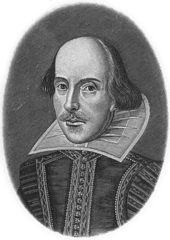
From its formation in 1707 the United Kingdom has had a vibrant tradition of theatre, much of it inherited from England, Scotland and Wales. TheUnion of the Crownscoincided with the decline of highbrow and provocativeRestoration comedyin favour ofsentimentalcomedy, domestictragedysuch as George Lillo'sThe London Merchant(1731), and by an overwhelming interest in Italian opera. Popular entertainment became more important in this period than ever before, with fair-booth burlesque and mixed forms that are the ancestors of the Englishmusic hall.These forms flourished at the expense of other forms of English drama, which went into a long period of decline. In Scotland the opposite occurred, with the emergence of specifically Scottish plays includingJohn Home'sDouglasand the works ofWalter Scott,which included original plays as well as adaptations of hisWaverleynovels. The late 19th century saw revival of English theatre with arrival of IrishmenGeorge Bernard ShawandOscar Wilde,who influenced domestic English drama and revitalised it. Their contemporariesGilbert and Sullivanhad a similar impact on musical theatre with theircomic operas.TheShakespeare Memorial Theatrewas opened in Shakespeare's birthplaceStratford upon Avonin 1879 andHerbert Beerbohm Treefounded anAcademy of Dramatic ArtatHer Majesty's Theatrein 1904.[42]
The early twentieth century was dominated bydrawing-room playsproduced by the likes ofNoël Coward,which were then challenged by thekitchen sink realismand absurdist drama influenced by IrishmanSamuel Beckettin the 1950s and 60s. Conversely 1952 saw the first performance ofAgatha Christie'sThe Mousetrap,a drawing-room murder mystery that has seen over 25,000 performances and is thelongest-running West End show.[43]At the same time the performing arts theatreSadler's Wells,underLilian Baylis,nurtured talent that led to the development of an opera company, which became theEnglish National Opera(ENO); a theatre company, which evolved into the National Theatre; and a ballet company, which eventually became the EnglishRoyal Ballet.Elsewhere theRoyal Shakespeare Companywas founded in 1959 atStratford-upon-Avon,and continues to mainly stage Shakespeare's plays.
Contemporary British theatre is focused on theWest End,London's major theatre district. TheTheatre Royal, Drury Lanein theCity of Westminsterdates back to 1663, making it the oldest London theatre, however the Theatre Royal at theBristol Old Vicis the oldest continually-operating theatre in the English speaking world, opening in 1768.[44]The musicals ofAndrew Lloyd Webberhave dominated the West End since the late 20th century, leading him to be dubbed "the most commercially successful composer in history".[45]ANational Theatre of Scotlandwas set up in 2006.
Music
[edit]Classical music
[edit]
British Baroque music was heavily influenced by continental fashions. This is exemplified byGeorge Frideric Handel,a German-born naturalised British citizen whose choral music set British taste for the next two centuries. His operas also helped Britain challenge Italy as a centre of operatic production. Classical music attracted much attention from 1784 with the formation of theBirmingham Triennial Music Festival,which was the longest running classical music festival of its kind until the final concerts in 1912. Beyond this, the establishment of theLondon Philharmonic Societyin 1813,Royal Academy of Musicin 1822, andIrish Academy of Musicin 1848 aided the professionalisation of British classical music and patronage of composers.
The Philharmonic Society was a strong supporter of the GermanFelix Mendelssohn,an early Romantic composer who also strongly influenced British music. In Ireland,John Fieldinvented the nocturne and may have been an influence on Chopin and Liszt. A notable development of the mid- to late-nineteenth century was the resurgence ofEnglish-language operaand the establishment of several prominent orchestras, including theRoyal Liverpool Philharmonicin 1840, Manchester-basedHalléin 1858, theScottish Orchestrain 1891 and theCity of Birmingham Symphony Orchestrain 1920. The most notable trend in classical music at the turn of the century was the nationalistic trend that developed. This was initially seen in works likeThe Masque at Kenilworth,which reconstructed an Elizabethan masque, but later took a pastoral turn under the influence of theBritish folk revival.Examplars of this period areRalph Vaughan Williams'English Folk Song Suite,andSir Alexander Mackenzie'sScottish Rhapsodies.
Modern and contemporary classical music takes a variety of forms. Composers such asBenjamin Brittendeveloped idiosyncratic and avant-garde styles, while the likes ofWilliam Waltonproduced more conventional ceremonial and patriotic music. The UK now has several major orchestras, including theBBC Symphony Orchestra,and thePhilharmonia,while the establishment of theOpera Northin 1977 sought to redress the balance of operatic institutions away from London. There are several classical festivals, such asAldeburghandGlydebourne,while theBBC Promsare an important annual fixture in the classical calendar.
Popular music
[edit]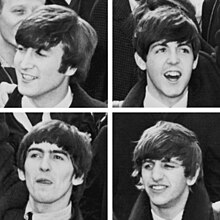
Popular commercial music in Britain can be traced back at least as far as the seventeenth-centurybroadside ballad,and also encompassesbrass band musicandmusic hall.Popular music in the modern sense began to emerge in the 1950s, as the American styles ofjazzandrock and rollbecame popular. Theskifflerevival was an early attempt to create a British form of American music, but it was the emergence ofBritish rock and rollby the early 1960s that established a viable British popular music industry. Genres such asbeatandBritish blueswere re-exported to America by bands such as theBeatlesandRolling Stones,in a move that came to be called theBritish Invasion.The 1960s saw the development ofheavy metalinBirminghamand the wider area. The development ofblues rockhelped differentiate rock and pop music, leading to the emergence of several sub-genres of rock in the 1970s.Glam rockwas a particularly British genre that emphasised outrageous costumes, while the end of the decade saw the rise ofpunk,new wave,andpost-punkbands. The influence of immigration could also be seen in the increased prominence ofWorld music,particularlyJamaican music.
The 1980s were a successful decade in British pop, as a secondBritish Invasionwas witnessed and new technology enabled genres such assynthpopto form. Jazz saw a resurgence as black British musicians created new fusions such asAcid Jazz.Indie rockwas a reaction to the perceived saturation of the music industry by pop, exemplified byStock Aitken Waterman's domination of the charts. This continued in the 1990s, asboy bands,all-femaleandmixed groupsdominated the singles chart, while theMadchesterscene helped drivealternative rockandBritpopto the mainstream. British soul saw a rise that continued into the 2000s, including the global success ofAdele.Dance music also saw innovation, with genres such asdubstepandnew raveemerging.
Folk and sub-national music
[edit]In contrast to the comparatively homogeneous classical and pop genres, each nation of the UK has retained a distinct tradition of folk music. The traditionalfolk music of Englandhas contributed to several genres, such assea shanties,jigs,hornpipesanddance music.It has its own distinct variations and regional peculiarities, while musicalMorris dancingis an English folk dance known to have existed at least as early as the mid-15th century.[47]
Thebagpipeshave long been a national symbol of Scotland, and theGreat Highland Bagpipeis widely recognised. TheEnglish and Scottish Popular Ballads,areballadsof the British Isles from the later medieval period until the 19th century, demonstrating great regional variety, particularly local traditions such as theBorder ballads,which include the particularly influentialBallad of Chevy Chase.British folk groups, such asFairport Convention,have drawn heavily from these ballads.
Similarly, while thenational anthem"God Save the King"and other patriotic songs such as"Rule, Britannia!"represent the United Kingdom, each of the four individual countries of the UK has its own patriotic hymns. For example,Jerusalem,Flower of Scotland,Land of My Fathers,andDanny Boypertain exclusively to England, Scotland, Wales, and Northern Ireland respectively. These songs are often used at sporting events where each nation competes individually.
Cinema
[edit]
Britain has had a significant film industry for over a century. While many films focus on British culture, British cinema is also marked by its interaction and competition withAmericanand continentalEuropean cinema.
The UK was the location of the oldest surviving moving picture,Roundhay Garden Scene(1888), which was shot inRoundhay,Leedsby French inventorLouis Le Prince,while the first British film,Incident at Clovelly Cottagewas shot in 1895.[48]The world's firstcolour motion picturewas shot byEdward Raymond Turnerin 1902.[49]British film production suffered in the 1920s in face of competition from American imports and a legal requirement for cinemas to show a set quota of British films, which encouraged poor-quality, low-cost productions to meet this demand. This had changed by the 1940s, when the government encouraged fewer, higher-quality films to be made.This era also saw the rise ofAlfred Hitchcock,who soon moved to the US and become one of the twentieth century's most influential directors. DuringWorld War IItheCrown Film Unitestablished a reputation for documentaries, whilePowell and Pressburgerbegan their influential and innovative collaboration.
The post-war period was a particular high point for British filmmaking, producingThe Third ManandBrief Encounter,which theBritish Film Instituteconsider the best and second-best British films respectively.Laurence Olivier's 1948Hamletwas the first British film to win theAcademy Award for Best Picture.The 1950s saw a focus on popular domestic topics such as comedies, including the enduringCarry Onseries, and World War II epics such asTheDam Busters.At the end of the decadeHammer Filmstook advantage of relaxed censorship laws to begin their series of successful horror films. The beginning of the 1960s saw theBritish New Wavestyle develop, influenced by its French counterpart, that sought to depict a wider strata of society in a realistic manner. The 1960s also saw renewed American financial interest in British film, which particularly manifested itself in the development ofhistorical epics,such as Best Picture winnersLawrence of ArabiaandA Man for All Seasons;spy thrillers,including the first films in theJames Bondfranchise; and films based on 'swinging London' scene.
The 1970s saw a withdrawal of American support and a retrenchment in British cinema, though the decade did see culturally important productions such as the horrorThe Wicker ManandMonty Python's comedic films. The decade also saw theCommonwealthinfluence British film, asPressureandA Private Enterpriseare considered the firstBlack BritishandBritish Asianfilms respectively. 1981'sChariots of Fireand 1982'sGandhiboth won the Best Picture Oscar, the latter winning eight awards, prompting a resurgence in period films. 1982 also saw the creation ofChannel 4,which had a remit to promote films for minority audiences. Films with racial and LGBT themes were produced, while Channel 4's involvement saw television stars move into feature films.
American investment again increased in the 1990s, and the success ofFour Weddings and a Funeralsawromantic comediesrise in popularity.Merchant Ivory Productions,boosted by the Oscars success of the previous decade's period pieces, continued to produce films in the same vein. American studios also began to base the production of Hollywood films in the UK, encouraged by tax incentives. 1996'sTrainspottingled to increased interest in regional, particularly Scottish, cinema. While American-funded films continued their influence in the 2010s, domestic European co-productions also received acclaim.The Queenwas British-French production for whichHelen Mirrenwon Best Actress, while theUK Film CouncilfundedThe King's Speech,which won Best Picture in 2011. Asian British cinema has risen in prominence since 1999, whenEast is Eastwas a mainstream success on a low budget.
Broadcasting
[edit]The UK has been at the forefront of developments in film, radio and television. Broadcasting in the UK has historically been dominated by the taxpayer-funded but independently runBritish Broadcasting Corporation(commonly known as theBBC), although other independent radio and television (ITV,Channel 4,Five) and satellite broadcasters (especiallyBSkyBwhich has over 10 million subscribers) have become more important in recent years. BBC television, and the other three main television channels arepublic service broadcasterswho, as part of their licence allowing them to operate, broadcast a variety of minority interest programming. The BBC and Channel 4 are state-owned, though they operate independently.

Launched in 1955, ITV is the oldest commercial television network in the UK.[50]DirectorRidley Scott's evocative 1973Hovisbread television commercial captured the public imagination. Filmed onGold Hill, Shaftesburyin Dorset, Scott's advert was voted the UK's favourite television advertisement of all time in 2006.[51]Other notable British commercials include the 1989British Airways face advertisement,the 2005noitulovEadvert forGuinness,the 2007Gorillaadvertisement byCadburychocolate featuring a gorilla playing drums with Phil Collins' track "In the Air Tonight"playing in the background, and a 2013 advert forGalaxychocolate bar featuring a computer-generated image ofAudrey Hepburn.Christmas commercials are screened from early November in the UK, with campaigns including theJohn Lewis Christmas advertfor the department store chain.
International football tournaments, such as theWorld Cup,are historically the most viewed sports events among the public, whileMatch of the Dayis the most popular weekly football show. The1966 FIFA World Cup Finaland theFuneral of Princess Dianaare the twomost watched television events everin the UK.[52]Satirehas been a prominent feature inBritish comedyfor centuries. The Britishsatire boomof the 1960s, which consisted of writers and performers such asPeter Cook,Dudley Moore,Alan Bennett,David FrostandJonathan Miller,has heavily influenced British television, including the sketch comedy seriesMonty Python's Flying Circuscreated in 1969 byMonty Python.Regarded as the leading figure of the satire boom, Peter Cook was ranked number one in theComedians' Comedianpoll.[53]The puppet showSpitting Imagewas a satire of theroyal family,politics, entertainment, sport and British culture of the 1980s up to the mid-1990s.

Have I Got News for YouandMock the Weekare the two longest running satirical panel shows. Satire also features heavily in theGrand Theft Autovideo game series which has been ranked among Britain's most successful exports.[54]Theslapstickand double entendre ofBenny Hillalso achieved very high ratings on British television, as did the physical humour ofMr. Bean.Popular comedy duos in television includeThe Two RonniesandMorecambe and Wise,with both shows featuring memorable sketches.Jeeves and WoosterstarredHugh LaurieasBertie Wooster,an airy, nonchalant, gormless, idle young gentleman andStephen FryasJeeves,his calm, well-informed, and talentedvalet.Created by and starringRik Mayallas Richie andAdrian Edmondsonas Eddie,Bottomfeatures two crude, perverted flatmates with no jobs and little money, which is noted for its chaotic, nihilistic humour and violent comedy slapstick.[55]Steve Coogancreated the characterAlan Partridge,a tactless and inept television presenter who often insults his guests and whose inflated sense of celebrity drives him to shameless self-promotion.Da Ali G ShowstarredSacha Baron Cohenas a faux-streetwise poseurAli Gfrom west London, who would conduct real interviews with unsuspecting people, many of whom are celebrities, during which they are asked absurd and ridiculous questions.
AnimatorNick Parkcreated theWallace and Gromitcharacters atAardman Animationsstudio in Bristol. They feature inA Grand Day Out(1989),The Wrong Trousers(1993) andA Close Shave(1995), which all have100% positive ratingson the aggregation site Rotten Tomatoes, whileA Matter of Loaf and Deathwas the most watched television programme in the UK in 2008. Aardman also produce the kid's showShaun the Sheep.One of the most popular children's shows originating in the UK isThomas & Friends(based onThe Railway Seriesbooks byWilbert Awdry), which has become the number one licensed preschool property in the world.[56]Other popular children's shows includePostman Pat,Fireman Sam,Teletubbies,Bob the BuilderandPeppa Pig
First airing in 1958,Blue Peteris famous for itsarts and crafts"makes". The show has been a staple for generations of British children. Popular live action TV shows includeThe Borrowers(based onMary Nortonbooks on little people),The Adventures of Black Beauty,The Famous Five(based onEnid Blytonbooks),The Lion, the Witch and the Wardrobe(based on theC. S. Lewisnovel), andPride and Prejudice(starringColin FirthasMr. Darcy). The actorDavid Jasonhas voiced a number of popular characters in children's animation, includingThe Wind in the Willows(based on the children's book byKenneth Grahame),Danger MouseandCount Duckula.Other children's shows includeWhere's Wally?(a series based on books by authorMartin Handfordwhere readers are challenged to find Wally who is hidden in the group),Dennis the Menace and Gnasher,whileThunderbirdsandTerrahawksbyGerryandSylvia Andersonhave been praised for creatingSupermarionation.[57]
Debuting in 1982,The Snowman(featuring the festive song "Walking in the Air") is annually screened at Christmas. Shown on the BBC, the UK holds two high-profile charity telethon events,Children in Need,held annually in November, andComic Relief,which alternates withSports Relief,every March. The 2011 edition of Comic Relief saw the first appearance ofJames Corden's Carpool Karaoke sketch when he drove around London singing songs withGeorge Michael.British programmes dominate the list of TV's most watched shows in the UK, with thekitchen sink dramas,ITV'sCoronation Streetand BBC'sEastEnders,both often ranking high on the ratings list compiled byBARB.[52] The majorsoap operaseach feature apub,and these pubs have become household names throughout the UK. TheRovers Returnis the pub inCoronation Street,theQueen Vic(short for theQueen Victoria) is the pub inEastEnders,and theWoolpackin ITV'sEmmerdale.The pub being a prominent setting in the three major television soap operas reflects the role pubs have as the focal point of the community in many towns and villages across the UK. Espionage and detective shows have long been a staple of British television, such as the 1960s seriesThe Avengersfeaturing lady spy adventurer and cultural (and feminist) iconEmma Peel.
The United Kingdom has a large number of national and local radio stations which cover a great variety of programming. The most listened to stations are the five main nationalBBC radiostations.BBC Radio 1,a new music station aimed at the 16–24 age group.BBC Radio 2,a variedpopular musicand chat station aimed at adults is consistently highest in the ratings.BBC Radio 4,a varied talk station, is noted for its news,current affairs,dramaandcomedyoutput as well asThe Archers,its long running soap opera, and other unique programmes, includingDesert Island Discs(1942–present), an interview programme in which a famous guest (called a "castaway") chooses eight pieces of music, a book and a luxury item that they would take with them to a desert island. Currently presented byLauren Laverne,it is the longest running music radio programme in British history.
The idea for aChristmas messagewas conceived by one of the founders of the BBC. Delivered annually by the monarch, it was first broadcast on BBC Radio in 1932. Analternative Christmas messagewas first broadcast on Channel 4 in 1993. Broadcast from 1951 to 1960, radio comedyThe Goon Show,starringPeter Sellers,Spike MilliganandHarry Secombe,mixed ludicrous plots with surreal humour, puns, catchphrases and an array of bizarre sound effects. The show has exerted considerable influence on British comedy and culture. As a film star Sellers in particular became influential to film actors by using different accents and guises and assuming multiple roles in the same film. ComedianMarty Feldmanco-created the acclaimed BBC Radio comedy programmeRound the Hornein 1965. The long running radio comedyJust a Minutefirst aired on BBC Radio 4 in 1967. Panellists must talk for sixty seconds on a given subject, "without hesitation, repetition or deviation". Guests over the years have includedStephen Fry,Eddie IzzardandSue Perkins.First broadcast on BBC Radio 4 in 1978, the science fiction comedy radio seriesThe Hitchhiker's Guide to the Galaxywas innovative in its use of music and sound effects. The BBC, as apublic service broadcaster,also runs minority stations such asBBC Asian Network,BBC Radio 1XtraandBBC Radio 6 Music,and local stations throughout the country. Rock music stationAbsolute Radio,and sports stationTalksport,are among the biggest commercial radio stations in the UK.[58]

Freedom of the presswas established in Great Britain in 1695.[59]Popular national newspapers includeThe Times,Financial Times,The Guardian,The Daily TelegraphandThe Independent.
Founded by publisherJohn Walterin 1785,The Timesis the first newspaper to have borne that name, lending it to numerous other papers around the world, and is the originator of the widely usedTimes Romantypeface, created byVictor Lardentand commissioned byStanley Morisonin 1931.[60]Newspaper and publishing magnateAlfred Harmsworthplayed a major role in "shaping the modern press" – Harmsworth introduced or harnessed "broad contents, exploitation of advertising revenue to subsidize prices, aggressive marketing, subordinate regional markets, independence from party control" – and was called "the greatest figure who ever strode downFleet Street."[61]The Economistwas founded byJames Wilsonin 1843, and the dailyFinancial Timeswas founded in 1888. FoundingThe Gentleman's Magazinein 1731,Edward Cavecoined the term "magazine"for a periodical, and was the first publisher to successfully fashion a wide-ranging publication.[62]Founded byThomas Gibson Bowles,Vanity Fairfeaturedcaricaturesof famous people for which it is best known today.[63]
A pioneer of children's publishing,John Newberymade children's literature a sustainable and profitable part of the literary market.[64]The History of Little Goody Two-Shoeswas published by Newbery in 1765.[64]Founded by SirAllen Lanein 1935,Penguin Booksrevolutionised publishing in the 1930s through its inexpensivepaperbacks,bringing high-quality paperback fiction and non-fiction to the mass market.[65]Formed in 1940,Puffin Booksis the children's imprint of Penguin Books.Barbara Euphan Todd's scarecrow story,Worzel Gummidge,was the first Puffin story book in 1941.[66]
TheGuinness Book of Recordswas the brainchild of SirHugh Beaver.On 10 November 1951 he became involved in an argument over which was the fastestgame birdin Europe, and realised that it was impossible to confirm in reference books. Beaver knew that there must be numerous other questions debated throughout the world, but there was no book with which to settle arguments about records. He realised that a book supplying the answers to this sort of question might prove successful. His idea became reality when an acquaintance of his recommended University friendsNorrisandRoss McWhirterwho were then commissioned to compile what becameThe Guinness Book of Recordsin August 1954.[67]E. L. James' erotic romancetrilogyFifty Shades of Grey,Fifty Shades Darker,andFifty Shades Freed,have sold over 125 million copies globally, and set the record in the United Kingdom as the fastest selling paperback.[68]
Copyrightlaws originated in Britain with theStatute of Anne(also known as the Copyright Act 1709), which outlined the individual rights of the artist. A right to benefit financially from the work is articulated, and court rulings and legislation have recognised a right to control the work, such as ensuring that the integrity of it is preserved.[69]The Statute of Anne gave the publishers rights for a fixed period, after which the copyright expired.[70]
Visual arts
[edit]
From the creation of the United Kingdom, theEnglish school of paintingis mainly notable for portraits and landscapes, and indeed portraits in landscapes. Among the artists of this period areJoshua Reynolds(1723–1792),George Stubbs(1724–1806), andThomas Gainsborough(1727–1788).
Pictorial satiristWilliam Hogarthpioneered Western sequential art, and political illustrations in this style are often referred to as "Hogarthian". Following the work of Hogarth,political cartoonsdeveloped in England in the latter part of the 18th century under the direction ofJames Gillray.Regarded as being one of the two most influentialcartoonists(the other being Hogarth), Gillray has been referred to as the father of the political cartoon, with his satirical work calling the king (George III), prime ministers and generals to account.[72]
The late 18th century and the early 19th century was perhaps the most radical period in British art, producingWilliam Blake(1757–1827),John Constable(1776–1837) andJ. M. W. Turner(1775–1851), three of the most influential British artists, each of whom have dedicated spaces allocated for their work at theTate Britain.[73]Named after Turner, theTurner Prize(created in 1984) is an annual award presented to a British visual artist under the age of 50.
ThePre-Raphaelite Brotherhood(PRB) achieved considerable influence after its foundation in 1848 with paintings that concentrated on religious, literary, andgenresubjects executed in a colourful and minutely detailed style. PRB artists includedJohn Everett Millais,Dante Gabriel Rossettiand subsequentlyEdward Burne-Jones.Also associated with it was the designerWilliam Morris,whose efforts to make beautiful objects affordable (or even free) for everyone led to his wallpaper and tile designs to some extent defining theVictorianaesthetic and instigating theArts and Crafts movement.
Visual artists from the UK in the 20th century includeLucian Freud,Francis Bacon,David Hockney,Bridget Riley,and thepop artistsRichard HamiltonandPeter Blake.Also prominent amongst 20th-century artists wasHenry Moore,regarded as the voice of British sculpture, and of British modernism in general.Sir Jacob Epsteinwas a pioneer of modern sculpture. In 1958 artistGerald Holtomdesigned the protest logo for the BritishCampaign for Nuclear Disarmament(CND), the peace movement in the UK, which became a universalpeace symbol.[74]As a reaction toabstract expressionism,pop artemerged in England at the end of the 1950s. The 1990s saw theYoung British Artists,Damien HirstandTracey Emin.
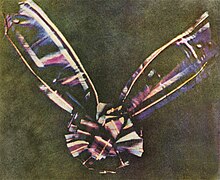
The auction was revived in 17th- and 18th-century England whenauctions by candlebegan to be used for the sale of goods and leaseholds, some of which were recorded inSamuel Pepys'sdiaryin 1660.[76]Headquartered in King Street, London,Christie's,the world's largest auction house, was founded in 1766 by auctioneerJames Christiein London. Known for his thickly impasted portrait and figure paintings, Lucian Freud was widely considered the pre-eminent British artist of his time. Freud was depicted in Francis Bacon's 1969 oil painting,Three Studies of Lucian Freud,which was sold for $142.4 million in November 2013, thehighest price attained at auctionto that point.[77]
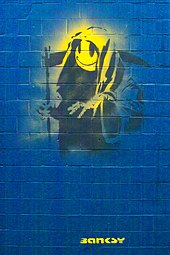
Randolph Caldecott,Walter Crane,Kate Greenaway,John Tenniel,Aubrey Beardsley,Roger Hargreaves,Arthur Rackham,John Leech,George CruikshankandBeatrix Potterwere notable book illustrators. Posters have played a significant role in British culture. Designed byAlfred Leetein 1914 as a recruitment poster for the British Army, "Lord Kitchener Wants You"is the most famous British recruitment poster ever produced and an iconic and enduring image of World War I.[78]Produced by the British government in 1939 for World War II, theKeep Calm and Carry Onmotivational poster is now seen as "not only as a distillation of a crucial moment in Britishness, but also as an inspiring message from the past to the present in a time of crisis".[79]
In the late 1960s, Britishgraphic designerStorm Thorgersonco-founded the graphic art groupHipgnosis,who have designed many iconic single and album covers for rock bands. His works were notable for theirsurrealelements, with perhaps the most famous being the cover for Pink Floyd'sThe Dark Side of the Moon.[80]Designed and photographed byBrian Duffy,theAladdin Sanealbum cover features a lightning bolt across his face which is regarded as one of the most iconic images of David Bowie. The subversive political artwork ofBanksy(pseudonym of Englishgraffiti artistwhose identity is concealed) can be found on streets, walls and buildings in the UK and the rest of the world.[81]Arts institutions include theRoyal College of Art,Royal Society of Arts,New English Art Club,Slade School of Art,Royal Academy,and theTate Gallery(founded as the National Gallery of British Art).
- Design
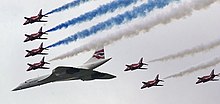
In 2006, 37 years after its first test flight,Concordewas named the winner of the Great British Design Quest organised by the BBC and theDesign Museum.A total of 212,000 votes were cast with Concorde beating other British design icons such as theMini,mini skirt,Jaguar E-Type,Tube mapand theSupermarine Spitfire.[82]The Spitfire featured inChristopher Nolan's 2017 action-thriller filmDunkirk.
SirMorien Morganled research intosupersonic transportin 1948 that culminated in the Concorde passenger aircraft.[83]In November 1956 he became chairman of the newly formed Supersonic Transport Aircraft Committee which funded research into supersonic transport at several British aviation firms though the 1950s. By the late 1950s, the committee had started the process of selecting specific designs for development, and after the forced merger of most aviation firms in 1960, selected theBristol Type 223,designed byArchibald Russell,as the basis for a transatlantic design.[83]
TheBrit Awardsstatuette for theBPI's annual music awards, which depictsBritannia,the female personification of Britain, is regularly redesigned by some of the best known British designers, stylists and artists, including DameVivienne Westwood,Damien Hirst,Tracey Emin,SirPeter Blake,Zaha Hadidand SirAnish Kapoor.[84]
Performing arts, carnivals, parades
[edit]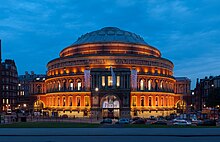
Large outdoormusic festivalsin the summer and autumn are popular, such asGlastonbury(the largest greenfield festival in the world),V Festival,Reading and Leeds Festivals.The UK was at the forefront of the illegal, freeravemovement from the late 1980s, which led to pan-European culture ofteknivalsmirrored on the British free festival movement and associated travelling lifestyle.[85]The most prominentopera housein England is theRoyal Opera HouseatCovent Gardens.[86]The Proms,a season oforchestralclassical music concerts held at theRoyal Albert Hall,is a major cultural event held annually.[86]The Royal Balletis one of the world's foremost classical ballet companies, its reputation built on two prominent figures of 20th-century dance,prima ballerinaMargot Fonteynand choreographerFrederick Ashton.Irish dancingis popular in Northern Ireland and among the Irish diaspora throughout the UK; its costumes feature patterns taken from the medievalBook of Kells.[87]
A staple of British seaside culture, the quarrelsome couplePunch and Judymade their first recorded appearance in Covent Garden, London in 1662.[88]The various episodes of Punch and Judy are performed in the spirit of outrageous comedy – often provoking shocked laughter – and are dominated by the anarchic clowning of Mr. Punch.[89]Regarded as British cultural icons, they appeared at a significant period in British history, with Glyn Edwards stating: "[Pulcinella] went down particularly well with Restoration British audiences, fun-starved after years ofPuritanism.We soon changed Punch's name, transformed him from a marionette to a hand puppet, and he became, really, a spirit of Britain – a subversive maverick who defies authority, a kind of puppet equivalent to our political cartoons. "[88]

Thecircusis a traditional form of entertainment in the UK.Chipperfield's Circusdates back more than 300 years in Britain, making it one of the oldest family circus dynasties.Philip Astleyis regarded as the father of themodern circus.[90]Following his invention of the circus ring in 1768,Astley's Amphitheatreopened in London in 1773.[90]As an equestrian master Astley had a skill for trick horse-riding, and when he added tumblers,tightrope-walkers,jugglers,performing dogs, and aclownto fill time between his own demonstrations – the modern circus was born.[90]The Hughes Royal Circus was popular in London in the 1780s.Pablo Fanque's Circus Royal, among the most popular circuses of Victorian England, showcasedWilliam Kite,which inspiredJohn Lennonto write "Being for the Benefit of Mr. Kite!"onThe Beatles' albumSgt. Pepper's Lonely Hearts Club Band.Joseph Grimaldi,originator ofwhitefaceclownmake-up, is considered the father of modern clowning.[91]
TheEdinburgh Festival Fringeis the world's largestarts festival.Established in 1947, it takes place in Scotland's capital during three weeks every August alongside several other arts and cultural festivals. The Fringe mostly attracts events from theperforming arts,particularly theatre and comedy, although dance and music also feature. TheNotting Hill Carnivalis an annual event that has taken place on the streets ofNotting Hill,London since 1966.[92]Led by theBritish African-Caribbeancommunity, the carnival has attracted around one million people, making it Britain's biggest street festival and one of the largest in the world.[92] Also of note is the extensive impact of Irish culture for St. Patrick's Day. The largest St Patrick's Day Parade takes place inDigbeth,Birmingham,where there is a strong Irish community.
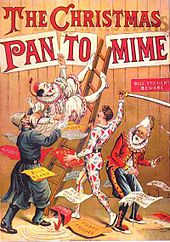

Pantomime(often referred to as "panto" ) is a Britishmusical comedystage production, designed for family entertainment. It is performed in theatres throughout the UK during the Christmas and New Year season. The art originated in the 18th century withJohn Weaver,a dance master and choreographer at theTheatre Royal, Drury Lanein London.[93]In 19th-century England it acquired its present form, which includes songs, slapstick comedy and dancing, employing gender-crossing actors, combiningtopical humourwith a story loosely based on a well-known fairy tale.[93]It is a participatory form of theatre, in which the audience sing along with parts of the music and shout out phrases to the performers, such as "It's behind you".[94]
Pantomime story lines and scripts are almost always based on traditional children's stories: some of the popular British stories featured includeJack and the Beanstalk,Peter Pan,Babes in the Wood,Goldilocks and the Three BearsandDick Whittington and His Cat.Plot lines are almost always adapted for comic or satirical effect, and characters and situations from other stories are often interpolated into the plot. For example,Jack and the Beanstalkmight include references to English nursery rhymes involving characters called "Jack", such asJack and Jill.Famous people regularly appear in Pantos, such asIan McKellen.[95]McKellen has also appeared at gay pride marches, withManchester Prideone of 15 annual gay pride parades in the UK; the largest inBrightonattracts over 300,000.[96]

Music hallis a British theatrical entertainment popular from the early Victorian era to the mid-20th century. The precursor tovariety showsof today, music hall involved a mixture of popular songs, comedy, speciality acts and variety entertainment. Music hall songs include "I'm Henery the Eighth, I Am","Hokey cokey","I Do Like To be Beside the Seaside"and"The Laughing Policeman".British performers who honed their skills at pantomime and music hall sketches includeCharlie Chaplin,Stan Laurel,George Formby,Gracie Fields,Dan Leno,Gertrude Lawrence,Marie LloydandHarry Champion.[98]British music hall comedian and theatre impresarioFred Karnodeveloped a form of sketch comedy without dialogue in the 1890s, and Chaplin and Laurel were notable music hall comedians who worked for him.[98]Laurel stated, "Fred Karno didn't teach Charlie [Chaplin] and me all we know about comedy. He just taught us most of it".[99]Film producerHal Roachstated; "Fred Karno is not only a genius, he is the man who originatedslapstickcomedy. We in Hollywood owe much to him. "[100]Examples of variety shows that evolved from the music hall include theRoyal Variety Performance(first performed in 1912), which was broadcast on BBC radio from the 1920s, and then on television since the 1950s. Annually held in December (often at theLondon Palladium) and performed in front of members of theBritish Royal Family,manyfamous acts have performedat theRoyal Varietyshow over the century, and since 2007 one act of the show has been selected by the British public through theITVtelevision talent showBritain's Got Talent.
Architecture
[edit]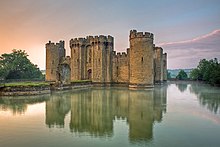
Thearchitecture of the United Kingdomincludes many features that precede the creation of the United Kingdom in 1707, from as early asSkara BraeandStonehengeto theGiant's Ring,AveburyandRomanruins.In most towns and villages the parish church is an indication of the age of the settlement. Manycastlesremain from themedievalperiod, such asWindsor Castle(longest-occupied castle in Europe),[102]Stirling Castle(one of the largest and most important in Scotland),Bodiam Castle(amoatedcastle), andWarwick Castle.Over the two centuries following theNorman conquest of Englandof 1066, and the building of theTower of London,castles such asCaernarfon Castlein Wales andCarrickfergus Castlein Ireland were built.

English Gothic architectureflourished from the 12th to the early 16th century, and famous examples includeWestminster Abbey,the traditional place ofcoronationfor theBritish monarch,which also has a long tradition as a venue forroyal weddings;and was the location of thefuneral of Princess Diana,[104]Canterbury Cathedral,one of the oldest and most famous Christian structures in England;Salisbury Cathedral,which has the tallest churchspirein the UK; andWinchester Cathedral,which has the longestnaveand greatest overall length of any Gothic cathedral in Europe.[105]Tudor architectureis the final development of Medieval architecture in England, during theTudor period(1485–1603). In the United Kingdom, alisted buildingis a building or other structure officially designated as being of special architectural, historical or cultural significance. About half a million buildings in the UK have "listed" status.
In the 1680s,Downing Streetwas built bySir George Downing,and its most famous address10 Downing Street,became the residence of thePrime Ministerin 1730.[106]One of the best-known English architects working at the time of the foundation of the United Kingdom was SirChristopher Wren.He was employed to design and rebuild many of the ruined ancient churches of London following theGreat Fire of London.His masterpiece,St Paul's Cathedral,was completed in the early years of the United Kingdom.[107]Buckingham Palace,the London residence of the British monarch, was built in 1705. Both St Paul's Cathedral and Buckingham Palace usePortland stone,a limestone from theJurassicperiodquarriedin theJurassic CoastinPortland,Dorset, which is famous for its use in British and world architecture.[108]
In the early 18th centuryBaroquearchitecture – popular in Europe – was introduced, andBlenheim Palacewas built in this era. However, Baroque was quickly replaced by a return of the Palladian form. TheGeorgian architectureof the 18th century was an evolved form of Palladianism. Many existing buildings such asWoburn AbbeyandKedleston Hallare in this style. Among the many architects of this form of architecture and its successors,neoclassicalandromantic,wereRobert Adam,SirWilliam Chambers,andJames Wyatt.

The aristocraticstately homecontinued the tradition of the first large gracious unfortified mansions such as theElizabethanMontacute HouseandHatfield House.Many of these houses are the setting for British period dramas, such asDownton Abbey.During the 18th and 19th centuries in the highest echelons of British society, theEnglish country housewas a place for relaxing, hunting in the countryside. Many stately homes have become open to the public:Knebworth House,now a major venue foropen air rock and pop concerts–Freddie Mercury's final live performance withQueentook place at Knebworth on 9 August 1986,[109]Alton Towers,the most populartheme parkin the UK, andLongleat,the world's firstsafari parkoutside Africa.

In the early 19th century the romanticGothic revivalbegan in England as a reaction to thesymmetryof Palladianism. Notable examples of Gothic revival architecture are theHouses of ParliamentandFonthill Abbey.By the middle of the 19th century, as a result of new technology, one could incorporate steel as a building component: one of the greatest exponents of this wasJoseph Paxton,architect ofthe Crystal Palace.Paxton also built such houses asMentmore Towers,in the still popular retrospectiveRenaissancestyles. In this era of prosperity and development British architecture embraced many new methods of construction, but such architects asAugust Puginensured that traditional styles were retained.
Following the building of the world's firstseaside pierin July 1814 inRyde,Isle of Wightoff the south coast of England, the pier became fashionable atseaside resortsin the UK during the Victorian era, peaking in the 1860s with 22 being built.[110]Providing a walkway out to sea, the seaside pier is regarded as among the finest Victorian architecture, and is an iconic symbol of the British seaside holiday.[110]By 1914, there were over 100 piers around the UK's coasts.[110]Today there are 55seaside piers in the UK.[110]Tower Bridge(half a mile fromLondon Bridge) opened in 1895.
At the beginning of the 20th century a new form of design,arts and crafts,became popular; the architectural form of this style, which had evolved from the 19th-century designs of such architects asGeorge Devey,was championed byEdwin Lutyens.Arts and crafts in architecture is characterised by an informal, non-symmetrical form, often withmullionedorlatticewindows, multiplegablesand tall chimneys. This style continued to evolve until World War II. After that war, reconstruction went through a variety of phases, but was heavily influenced byModernism,especially from the late 1950s to the early 1970s. Many bleak town centre redevelopments—criticised for featuring hostile, concrete-lined "windswept plazas" —were the fruit of this interest, as were many equally bleak public buildings, such as theHayward Gallery.

Many Modernist-inspired town centres are today being redeveloped:Bracknelltown centre is an example. However, in the immediate post-War years many thousands (perhaps hundreds of thousands) ofcouncil housesin vernacular style were built, giving working-class people their first experience of private gardens and indoorsanitation.Many towns also feature statues or sculptures dedicated to famous natives. Modernism remains a significant force in British architecture, although its influence is felt predominantly in commercial buildings. The two most prominent proponents areLord Rogers of RiversideandNorman Foster.Rogers' best known London buildings are probablyLloyd's Buildingand theMillennium Dome,while Foster created the 'Gherkin' and theCity Hall.TheTurner Prizewinning artist SirAnish Kapooris an acclaimed contemporary British sculptors. A notable design is hisArcelorMittal Orbitsculpture at theOlympic Parkin London.
Described byThe Guardianas the 'Queen of the curve',Zaha Hadidliberated architectural geometry with the creation of highly expressive, sweeping fluid forms ofmultiple perspectivepoints andfragmented geometrythat evoke the chaos and flux of modern life.[112]A pioneer ofparametricism,and an icon ofneo-futurism,with a formidable personality, her acclaimed work and ground-breaking forms includethe aquatic centrefor the London 2012 Olympics.[112]In 2010 and 2011 she received theStirling Prize,the UK's most prestigious architectural award, and in 2015 she became the first woman to be awarded theRoyal Gold Medalfrom theRoyal Institute of British Architects.Completed in 2012, theShard London Bridgeis the tallest building in the UK. Other major skyscrapers under construction in London include22 Bishopsgate,andHeron Tower.Modernist architectNicholas Grimshawdesigned theEden Projectin Cornwall, which is the world's largest greenhouse.[113]
Comics
[edit]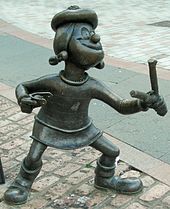
British comics in the early 20th century typically evolved from illustratedpenny dreadfulsof the Victorian era (featuringSweeney Todd,Dick TurpinandVarney the Vampire). A growing consumer culture and an increased capacity for travel throughout the UK via the invention ofrailway(in 1825) created both a market for cheap popular literature, and the ability for it to be circulated on a large scale. Created in the 1830s,The Guardiandescribed penny dreadfuls as "Britain's first taste of mass-producedpopular culturefor the young ".[114]Introducing familiar features invampire fiction,Varneyis the first story to refer to sharpened teeth for avampire.[115]After adult comics had been published – most notablyAlly Sloper's Half Holiday(1880s) featuringAlly Sloperwho has been called the first regular character in comics,[116]– more juvenile British comics emerged, with the two most popular,The BeanoandThe Dandy,released byDC Thomson(based inDundee,Scotland) in the 1930s. By 1950 the weekly circulation of both reached two million.[117]Explaining the popularity of comics during this period, Anita O'Brien, director curator at London's Cartoon Museum, states: "When comics like theBeanoandDandywere invented back in the 1930s – and through really to the 1950s and 1960s – these comics were almost the only entertainment available to children. "[117]
In 1954Tigercomics introducedRoy of the Rovers,the hugely popular football based strip recounting the life ofRoy Raceand the team he played for,Melchester Rovers.The stock media phrase "real 'Roy of the Rovers' stuff" is often used by football writers, commentators and fans when describing displays of great skill, or surprising results that go against the odds, in reference to the dramatic storylines that were the strip's trademark. Other comic books,graphic novels,and sequential art of various genres also flourished. These included fantasy and science fiction likeEagle,Valiant,Warrior,and2000 AD.Other popular titles were war comics inspired by British military history likeCommando,War Picture Library,andThe Victor.[118][119]
Created byEmma Orczyin 1903,the Scarlet Pimpernelis the alter ego of Sir Percy Blakeney, a wealthy English fop who transforms into a formidable swordsman and a quick-thinking escape artist, establishing the "hero with asecret identity"into popular culture.[120]The Scarlet Pimpernel first appeared on stage (1903) and then in novel (1905), and became very popular with the British public.[121]He exhibits characteristics that became standard superhero conventions in comic books, including the penchant for disguise, use of a signature weapon (sword), ability to out-think and outwit his adversaries, and a calling card (he leaves behind ascarlet pimpernelat his interventions).[121]Drawing attention to his alter ego Blakeney he hides behind his public face as a meek, slow thinking foppish playboy, and he establishes a network of supporters, The League of the Scarlet Pimpernel, that aid his endeavours.[121]
In the 1980s, a resurgence of British writers and artists gained prominence in mainstream comic books, which was dubbed the "British Invasion"in comic book history. These writers and artists brought with them their own mature themes and philosophy such asanarchy,controversyandpoliticscommon in British media, but were never before seen in American comics. These elements would pave the way for mature and "darker and edgier" comic books that would jump start theModern Age of Comics.[122]Writers includedAlan Moore,famous for hisV for Vendetta,From Hell,Watchmen,Marvelman,andThe League of Extraordinary Gentlemen;[123]Watchmenwas described as "paving the way for a current cultural obsession" in comics;[124]Neil Gaimanand his critically acclaimed and best-sellingThe Sandmanmythos andBooks of Magic;Warren Elliscreator ofTransmetropolitanandPlanetary;and others such asAlan Grant,Grant Morrison,Dave Gibbons,Alan Davis,andMark Millarwho createdWantedandKick-Ass.
Prominent comic book artists includeSteve Dillon,Simon Bisley,Dave McKean,Glen Fabry,John RidgwayandSean Phillips.The comic book seriesHellblazer,set in Britain and starring the Liverpudlian magicianJohn Constantine,paved the way for British writers such asJamie Delano,Mike CareyandDenise Mina.[125]
Folklore
[edit]Robin Hood and the ballad tradition
[edit]Much of the folklore of the United Kingdom pre-dates the 18th century. Though some of the characters and stories are present throughout all of the UK, most belong to specific countries or regions. Common folkloric beings includepixies,giants,elves,bogeymen,trolls,goblinsanddwarves.While many legends and folk-customs are thought to be ancient, such as the tales ofOffa of AngelnandWeyland Smith,others date from after the Norman invasion of England, such asRobin Hoodand hisMerry MenofSherwoodand their battles with theSheriff of Nottingham.[126]Richard the Lionheart,Christian leader of theThird Crusade,came to be seen as a contemporary and supporter of Robin Hood. A plaque features Richard marrying Robin andMaid MarianoutsideNottingham Castle.[127]
During theHigh Middle Agestales originated from Brythonic traditions, notably theArthurian legend.[128]Deriving from Welsh source;King Arthur,ExcaliburandMerlin,while theJerseypoetWaceintroduced theKnights of the Round Table.These stories are most centrally brought together withinGeoffrey of Monmouth'sHistoria Regum Britanniae(History of the Kings of Britain). Another early figure fromBritish tradition,King Cole,may have been based on a real figure from Sub-Roman Britain. Many of the tales make up part of the widerMatter of Britain,a collection of shared British folklore.
TheLoch Ness Monsteris acryptidthat is reputed to inhabitLoch Nessin the Scottish Highlands. The legendary monster has been affectionately referred to by the nickname "Nessie" since the 1950s. Theleprechaunfigures large in Irish folklore. A mischievous fairy-type creature in emerald green clothing who when not playing tricks spends all its time busily making shoes, the leprechaun is said to have a pot of gold hidden at the end of therainbow,and if ever captured by a human it has the magical power to grant three wishes in exchange for release. In mythology, English fairy tales such asJack and the BeanstalkandJack the Giant Killerhelped form the modern perception ofgiantsas stupid and violent, while the dwarfTom Thumbis a traditional hero in English folklore.
English fairy taleGoldilocks and the Three Bearsis one of the most popular fairy tales in the English language.[129]Some folk figures are based on semi- or actual historical people whose story has been passed down centuries:Lady Godiva,for instance, was said to have ridden naked on horseback throughCoventry;the heroic English figureHereward the Wakeresisted the Norman invasion;Herne the Hunteris an equestrian ghost associated withWindsorForest andGreat Park,andMother Shiptonis the archetypal witch.[130]The chivalrous bandit, such asDick Turpin,is a recurring character.
Pirates
[edit]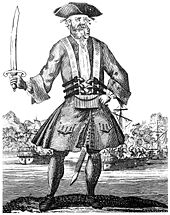
Published in 1724,A General History of the PyratesbyCaptain Charles Johnsonprovided the standard account of the lives of many pirates in the Golden Age.[131]It influenced pirate literature of Scottish novelistsRobert Louis Stevenson(Treasure Island) andJ. M. Barrie.[131]Many famous English pirates from the Golden Age hailed from theWest Countryin south west England—the stereotypicalWest Country"pirate accent"was popularised by West Country nativeRobert Newton's portrayal of Stevenson'sLong John Silverin film.[132]The concept of "walking the plank"was popularised by Barrie'sPeter Pan,whereCaptain Hook's pirates helped define the archetype.[133]Davy Jones' Locker,where sailors or ships' remains are consigned to the bottom of the sea, is first recorded byDaniel Defoein 1726.[134]Johnson's 1724 book gave a mythical status to famous English pirates such asBlackbeardandCalico Jack—Jack'sJolly Rogerflag design features a skull with crossed swords.[135]
Superstitions
[edit]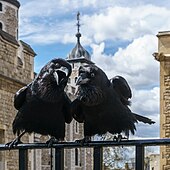
TheGremlinis part ofRoyal Air Forcefolklore dating from the 1920s, with "gremlin" being RAF slang for a mischievous creature that sabotages aircraft, meddling in the plane's equipment.[137]Legendary figures from 19th-century London whose tales have been romanticised includeSweeney Todd,the murderous barber ofFleet Street(accompanied withMrs. Lovettwho sells pies made from Todd's victims), and serial killerJack the Ripper.On 5 November, people in Britain celebrateGuy Fawkes Nightby making bonfires and lighting fireworks incommemorationof the foiling ofGuy Fawkes'Gunpowder Plot,which became an annual event after theObservance of 5th November Act 1605was passed.[138]Guy Fawkes masksare an emblem for anti-establishment protest groups.[139]
Traditional non-religious holidays
[edit]
Halloweenis a traditional and much celebrated holiday in Scotland and Ireland on the night of 31 October.[140]The name "Halloween" is first attested in the 16th century as aScottishshortening of the fullerAll-Hallows-Even,[141]and according to some historians has its roots in theGaelicfestivalSamhain,when the Gaels believed the border between this world and theotherworldbecame thin, and the dead would revisit the mortal world.[142]In 1780,DumfriespoetJohn Maynemakes note of pranks at Halloween;"What fearfu' pranks ensue!",as well as the supernatural associated with the night,"Bogies"(ghosts).[143]Robert Burns' 1785 poem "Halloween"is recited by Scots at Halloween, and Burns was influenced by Mayne's composition.[143]
In Scotland and Ireland, traditional Halloween customs includeguising— children disguised incostumegoing from door to door requesting food or coins – which had become common practice by the late 19th century;[144][145](the Halloween masks, worn by children, are known as "false faces" in Ireland.[146])turnipshollowed out and carved with faces to make lanterns,[147]and holding parties where games such asapple bobbingare played.[148]Agatha Christie's mystery novelHallowe'en Partyis about a girl who is drowned in an apple-bobbing tub. Other practices in Ireland include lightingbonfires,and havingfireworkdisplays.[149]Further contemporary imagery of Halloween is derived fromGothicandhorrorliterature (notablyShelley'sFrankensteinandStoker'sDracula), and classic horror films (such asHammer Horrors). Mass transatlantic Irish and Scottish migration in the 19th century popularised Halloween in North America.[150]

Witchcrafthas featured in the British Isles for millennia. The use of acrystal ballto foretell the future is attributed to thedruids.In medieval folkloreKing Arthur's magician, the wizardMerlin,carried around a crystal ball for the same purpose.John Dee,consultant toElizabeth I,frequently used a crystal ball to communicate with the angels.[151]Probably the most famous depiction of witchcraft in literature is inShakespeare's 1606 playMacbeth,featuring thethree witchesand theircauldron.TheghostofAnne Boleynis a frequently reported ghost sighting in the UK. Differing accounts include seeing her ghost ride up toBlickling Hallin a coach drawn by a headless horseman, with her own head on her lap.[152]
Neopagan witchcraftbegan in England in the early 20th century with notable figures such asAleister Crowleyand the father of WiccaGerald Gardner,before expanding westward in the 1960s.[153]Settling down near theNew Forestin Hampshire, Gardner joined an occult group through which he claimed to have encountered theNew Forest coveninto which he was initiated in 1939.[153]Believing the coven to be a survival of the pre-ChristianWitch-Cult,he decided to revive the faith, supplementing the coven's rituals with ideas borrowed from ceremonial magic and the writings of Crowley to form the Gardnerian tradition ofWicca.[153]Moving to London in 1945, following the repeal of theWitchcraft Act of 1736Gardner became intent on propagating Wicca, attracting media attention and writingWitchcraft Today(1954) andThe Meaning of Witchcraft(1959). Crowley (the founder ofThelema) was described as "the most notorious occultist magician of the 20th century", and he remains an influential figure over Western esotericism and the counter-culture.[154]His motto of "Do What Thou Wilt" is inscribed on the vinyl ofLed Zeppelin's albumLed Zeppelin III,and he is the subject ofOzzy Osbourne's single "Mr Crowley".[155]
National parks, museums, libraries, and galleries
[edit]Heritage administration
[edit]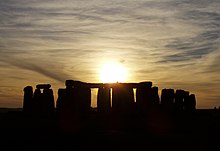
Each country has its own body responsible for heritage matters.
English Heritageis the government body with a broad remit of managing the historic sites, artefacts and environments of England. It is currently sponsored by theDepartment for Culture, Media and Sport.The charityNational Trust for Places of Historic Interest or Natural Beautyhas a contrasting role. Seventeen of theUNESCO World Heritage Sitesare in England. Some of the best known of these includeHadrian's Wall,Stonehenge, Avebury and Associated Sites,Tower of London,Jurassic Coast,Westminster,Saltaire,Ironbridge Gorge,andStudley Royal Park.The northernmost point of the Roman Empire,Hadrian's Wall,is the largest Roman artefact anywhere: it runs a total of 73 miles in northern England.[156]
Historic Environment Scotlandis the executive agency of theScottish Government,responsible for historic monuments in Scotland, such asStirling Castle.TheOldandNew Town of Edinburghis a notable Scottish World Heritage site.Balmoral Castleis the main Scottish residence of the British monarch. TheWallace Monumentin Stirling contains artifacts believed to have belonged to SirWilliam Wallace,including theWallace Sword.TheRob Roy Way,named after Scottish folk hero and outlawRob Roy MacGregor,is a long-distance footpath that runs for 92 miles. A statue ofRobert the Bruceand a large monument and visitor centre (operated by the National Trust for Scotland) is located in Bannockburn near the site of theBattle of Bannockburn.[157]
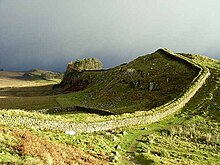
Many of Wales' great castles, such as theCastles and Town Walls of King Edward in Gwyneddand other monuments, are under the care ofCadw,the historic environment service of theWelsh Government.Welsh actor SirAnthony Hopkinsdonated millions to the preservation ofSnowdonia National Park.The five most frequently visited Welsh castles areCaernarfon Castle,Conwy Castle,Caerphilly Castle,Harlech CastleandBeaumaris Castle.TheNorthern Ireland Environment Agencypromotes and conserves the natural and built environment in Northern Ireland, and theGiant's Causewayon the north-east coast is one of the natural World Heritage sites.Tintagel Castleis a popular tourist destination in Cornwall, with the castle associated with the legend ofKing Arthursince the 12th century. There are 15National Parks,including theLake Districtin England,Snowdoniain Wales, andLoch Lomond and The Trossachs National Parkin Scotland
Museums and galleries
[edit]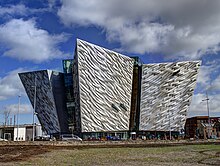
TheBritish Museumin London with its collection of more than seven million objects,[158]is one of the largest and most comprehensive in the world, and sourced from every continent, illustrating and documenting the story of human culture from its beginning to the present. On display since 1802, theRosetta Stoneis the most viewed attraction. TheNatural History Museum, Londonwas established byRichard Owen(who coined the term "dinosaur") to display the national collection of dinosaur fossils and other biological and geological exhibits.[159]TheNational Museums of Scotlandbring together national collections in Scotland.Amgueddfa Cymru – National Museum Walescomprises eight museums in Wales.National Museums Northern Irelandhas four museums in Northern Ireland including theUlster Museum.
TheTitanic Belfastmuseum, a visitor attraction in theTitanic Quarter,east Belfast, Northern Ireland on the regenerated site of the shipyard whereTitanicwas built, was opened to the public in 2012.[160]The architecture is a tribute toTitanicitself, with the external facades a nod to the enormous hull of the ocean liner.
The firstMadame Tussaudswax museum opened in London in 1835, and today displays waxworks of famous people from various fields, including royalty (Princess Diana), historical figures (Henry VIII), sport (David Beckham), music (Freddie Mercury), literature (Charles Dickens), politics (Winston Churchill), television (Gordon Ramsay), and cinema (Michael Caine) among others.[161]
The most senior art gallery is theNational GalleryinTrafalgar Square,which houses a collection of over 2,300 paintings dating from the mid-13th century to 1900. TheTategalleries house the national collections of British and international modern art; they also host the famously controversialTurner Prize.[162]TheNational Galleries of Scotlandare the five national galleries of Scotland and two partner galleries. The National Museum of Art, Wales, opened in 2011.[163]
Libraries
[edit]TheBritish Libraryin London is thenational libraryand is one of the world's largestresearch libraries,holding over 150 million items in all known languages and formats; including around 25 million books.[164]The library has two of the four remaining copies of the originalMagna Carta(the other two copies are held inLincoln CastleandSalisbury Cathedral) and has a room devoted solely to them. TheBritish Library Sound Archivehas over six million recordings (many from theBBC Sound Archive,including Winston Churchill's wartime speeches.)
TheNational Library of Scotlandin Edinburgh holds 7 million books, 14 million printed items (such as the last letter written byMary, Queen of Scots) and over 2 million maps.[165]TheNational Library of Walesis the national legal deposit library of Wales, and holds over 6.5 million books, portraits, maps and photographic images in Wales.[166]
Historical markers
[edit]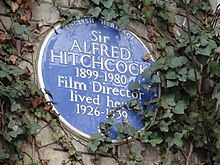
Blue plaquesare the oldesthistorical markerscheme in the world.[167]The scheme was proposed by politicianWilliam Ewartin 1863 and was initiated in 1866 by theSociety of Arts.Since 1986 it has been run by English Heritage.[167]
The first plaque was unveiled in 1867 to commemorateLord Byronat his birthplace, 24 Holles Street,Cavendish Square,London. Events commemorated by plaques includeJohn Logie Baird's first demonstration of television at 22Frith Street,Westminster, W1, London, the firstsub 4-minute milerun byRoger Bannisteron 6 May 1954 at Oxford University'sIffley Road Track,and a sweet shop inLlandaff,Cardiff that commemorates the mischief by a youngRoald Dahlwho put a mouse in thegobstoppersjar.[168]
Science and technology
[edit]From the time of theScientific Revolution,England and Scotland, and thereafter the United Kingdom, have been prominent in worldscientificandtechnologicaldevelopment. TheRoyal Societyserves as thenational academyfor sciences, with members drawn from different institutions and disciplines. Formed in 1660, it is one of the oldestlearned societiesstill in existence.[169]
Sir Isaac Newton's publication of thePrincipia Mathematicaushered in what is recognisable as modernphysics.The first edition of 1687 and the second edition of 1713 framed the scientific context of the foundation of the United Kingdom. He realised that the same force is responsible for movements of celestial and terrestrial bodies, namelygravity.He is the father ofclassical mechanics,formulated as histhree lawsand as the co-inventor (withGottfried Leibniz) ofdifferential calculus.He also created thebinomial theorem,worked extensively onoptics,and created alaw of cooling.

Figures from the UK have contributed to the development of most major branches of science.John Napierintroducedlogarithmsin the early 17th century as a means to simplify calculations.Michael FaradayandJames Clerk Maxwellunified the electric andmagneticforcesin what are now known asMaxwell's equations.Following his publication ofA Dynamical Theory of the Electromagnetic Fieldin 1865, Maxwell predicted the existence ofradio wavesin 1867.[171]James Jouleworked onthermodynamicsand is often credited with the discovery of theprinciple of conservation of energy.
NaturalistCharles DarwinwroteOn the Origin of Speciesand discovered the principle ofevolutionbynatural selection.James Hutton,founder of modern geology, worked on the age of the Earth (deep time) which forms a key element of Darwin's theory. Other important geologists includeCharles Lyell,author ofPrinciples of Geology,who also coined the termPleistocene,andAdam Sedgwick,who proposed (and coined) the name of theCambrianPeriod.[172]William Thomson (Baron Kelvin)drew important conclusions in the field of thermodynamics and invented theKelvinscale ofabsolute zero.Paul Diracwas one of the pioneers ofquantum mechanics.BotanistRobert Browndiscovered the random movement of particles suspended in a fluid (Brownian motion).John Stewart BellcreatedBell's Theorem.Harold Krotodiscoveredbuckminsterfullerene.
Other 19th- and early 20th-century British pioneers in their field includeJoseph Lister(antiseptic surgery),Edward Jenner(vaccination),Richard Owen(palaeontology,coined the termDinosaur),Florence Nightingale(nursing),Sir George Cayley(aerodynamics),William Fox Talbot(photography), andHoward Carter(modern archaeology,discoveredTutankhamun).
Scholarly descriptions of dinosaur bones first appeared in the late 17th-century England. Between 1815 and 1824,William Bucklanddiscovered fossils ofMegalosaurusand became the first person to describe a dinosaur in a scientific journal. The second dinosaur genus to be identified,Iguanodon,was discovered in 1822 byMary Ann Mantell.In 1832,Gideon Mantelldiscovered fossils of a third dinosaur,Hylaeosaurus.Owen recognised that the remains of the three new species that had been found so far shared a number of distinctive features. He decided to present them as a distinct taxonomic group, dinosaurs.[173]
John Harrisoninvented themarine chronometer,a key piece in solving the problem of accurately establishinglongitudeat sea, thus revolutionising and extending the possibility of safe long-distance sea travel.[174]The most celebrated British explorers includeJames Cook,Walter Raleigh,Sir Francis Drake,Henry Hudson,George Vancouver,Sir John Franklin,David Livingstone,Captain John Smith,Robert Falcon Scott,Lawrence OatesandErnest Shackleton.Theaquariumcraze began in Victorian England whenPhilip Henry Gossecreated and stocked the first public aquarium atLondon Zooin 1853, and coined the term "aquarium" when he publishedThe Aquarium: An Unveiling of the Wonders of the Deep Seain 1854.[175]Robert FitzRoypioneeredweather forecasting:the first daily weather forecasts were published inThe Timesin 1861.[176]
A crucial advance in the development of theflush toiletwas theS-trapinvented byAlexander Cummingin 1775 – it uses the standing water to seal the outlet of the bowl, preventing the escape of foul air from the sewer.[177]In 1824Charles Macintoshinvented the waterproofraincoat;theMackintosh(mac) is named after him.[177]William Sturgeoninvented theelectromagnetin 1824.[178]The first commercialelectrical telegraphwas co-invented by SirWilliam Fothergill CookeandCharles Wheatstone.They patented it in May 1837 as an alarm system, and it was first successfully demonstrated on 25 July 1837 betweenEustonandCamden Townin London.[179]
Postal reformerSir Rowland Hillis regarded as the creator of the modernpostal serviceand the inventor of the postage stamp (Penny Black) — with his solution of pre-payment facilitating the safe, speedy and cheap transfer of letters.[180]Hill's colleagueSir Henry Coleintroduced the world's first commercialChristmas cardin 1843.[181]In 1851Sir George Airyestablished theRoyal Observatory, Greenwich,London, as the location of theprime meridianwhere longitude is defined to be 0° (one of the two lines that divide the Earth into the Eastern andWestern Hemispheres).George BooleauthoredThe Laws of Thoughtwhich containsBoolean algebra.Forming the mathematical foundations ofcomputing,Boolean logic laid the foundations for theinformation age.

Historically, many of the UK's greatest scientists have been based at eitherOxfordorCambridge University,with laboratories such as theCavendish Laboratoryin Cambridge and theClarendon Laboratoryin Oxford becoming famous in their own right. In modern times, other institutions such as theRed BrickandNew Universitiesare catching up withOxbridge.For instance,Lancaster Universityhas a global reputation for work inlow temperature physics.
Technologically, the UK is also amongst the world's leaders. Historically, it was at the forefront of theIndustrial Revolution,with innovations especially in textiles, thesteam engine,railroads, machine tools andcivil engineering.Famous British engineers and inventors from this period includeJames Watt,Robert Stephenson,Richard Arkwright,Henry Maudslayand the 'father of Railways'George Stephenson.Maudslay's most influential invention was thescrew-cutting lathe,a machine which created uniformity inscrewsand allowed for the application ofinterchangeable parts(a prerequisite formass production): it was a revolutionary development necessary for the Industrial Revolution. The UK has the oldestrailwaynetworks in the world, with theStockton and Darlington Railway,opened in 1825, the first public railway to use steam locomotives. Opened in 1863,London Undergroundis the world's first underground railway.[183]Running along theEast Coast Main Linebetween Edinburgh and London, theFlying Scotsmanhas been ranked the world's most famous steam locomotive.[184]
EngineerIsambard Kingdom Brunel,another major figure of the Industrial Revolution, was placed second in a 2002BBCnationwide poll to determine the "100 Greatest Britons".[185]He created theGreat Western Railway,as well as famous steamships including theSS Great Britain,the first propeller-driven ocean-going iron ship, andSSGreat Easternwhich laid the first lastingtransatlantic telegraph cable.Josiah Wedgwoodpioneered the industrialisation ofpotterymanufacture.[186]In 1820, Scottish road builderJohn McAdaminvented "macadamisation"for building roads with a smooth hard surface. In 1901,Edgar Purnell Hooleyadded tar to the mix and named itTarmac(short for tarmacadam).[187]

Probably the greatest driver behind the modern use ofconcretewasSmeaton's Towerbuilt byJohn Smeatonin the 1750s. The thirdEddystone Lighthouse(the world's first open ocean lighthouse), Smeaton pioneered the use ofhydraulic limein concrete. ScotsmanRobert Stevensonconstructed theBell Rock Lighthousein the early 1800s. Situated 11 miles off east Scotland, it is the world's oldest surviving sea-washed lighthouse.Portland cement,the most common type ofcementin general use around the world as a basic ingredient of concrete, was developed in England in the 19th century. It was coined byJoseph Aspdinin 1824 (he named it afterPortland stone), and further developed by his sonWilliam Aspdinin the 1840s.
The UK has produced some of the most famous ships in the world:Harland and Wolffin Belfast built theRMSTitanicas well as her sister shipsRMSOlympicandRMSBritannic;in ClydebankJohn Brown and Companybuilt theRMSQueen Mary,RMSQueen ElizabethandSSQueen Elizabeth 2;ships built in England include theMary Rose(KingHenry VIII's warship), theGolden Hind(SirFrancis Drake's ship for thecircumnavigation of the globe between 1577 and 1580),HMSVictory(Lord Nelson's flagship at theBattle of Trafalgarin 1805), andHMSBeagle(ship used inCharles Darwin'sfive-year voyage). Other important British ships includeHMSEndeavour(James Cook's ship in hisfirst voyage of discovery),HMSChallenger(first global marine research expedition: theChallengerexpedition), andDiscovery(carriedRobert Falcon ScottandErnest Shackletonin theDiscovery Expedition,their first successful journey to the Antarctic). The Royal Navy troopshipHMSBirkenheadis known for the first appearance of the "women and children first"protocol.[188]
Since then, the UK has continued this tradition of technical creativity.Alan Turing(leading role in the creation of the modern computer), Scottish inventorAlexander Graham Bell(the first practical telephone),John Logie Baird(world's first working television system, first electroniccolour television),Frank Whittle(co-invented thejet engine) — powered by Whittle'sturbojetengines, theGloster Meteorwas the first Britishjetfighterand theAllies'onlyjet aircraftto achieve combat operations during World War II,Charles Babbage(devised the idea of the computer),Alexander Fleming(discoveredpenicillin). The UK remains one of the leading providers of technological innovations, providing inventions as diverse as theWorld Wide WebbySir Tim Berners-Lee,andViagraby British scientists at Pfizer'sSandwich,Kent.Sir Alec JeffreyspioneeredDNA fingerprinting.Pioneers offertilitytreatmentPatrick SteptoeandRobert Edwards,achieved conception throughIVF(world's first "test tube baby" ) in 1978.[189]

The prototypetankwas constructed atWilliam Foster & Co.inLincolnin 1915, with leading roles played by MajorWalter Gordon Wilsonwho designed the gearbox and developed practical tracks and byWilliam Trittonwhose company built it.[191]This was a prototype of theMark I tank,the first tank used in combat in September 1916 during WWI.[191]TheFirst Lord of the Admiralty,Winston Churchill,was credited by Prime MinisterDavid Lloyd Georgeas being the driving force behind their production.Allan Beckettdesigned the 'Whale' floating roadway, crucial to the success of theMulberry harbourused in theinvasion of Normandyin WWII. In 1918,HMSArgusbecame the world's firstaircraft carriercapable of launching and recovering naval aircraft, and in WWII,HMSArk Royalwas involved in the first aerial and U-boat kills of the war, as well as the crippling of the German battleship theBismarckin May 1941. In 1932, Cambridge engineerFrancis Thomas Baconinvented thealkaline fuel cellwhich is used to generate power forspace capsulesandsatellites.[192]
Introduced in 1952, thede HavillandCometwas the world's first commercialjet airliner.[193]Operated byBritish Overseas Airways Corporation(which merged with other British operators to form today'sBritish Airways), on 2 May 1952 the flight registered G-ALYS took off with fare-paying passengers and inaugurated scheduled service from London to Johannesburg.[193]
In 1952,OXO(orNoughts and Crosses), created by computer scientistAlexander S. Douglas,is regarded as a contender for the firstvideo game.[194]InOXO,the computer player could play perfect games ofnoughts and crossesagainst a human opponent.[194]In the 1960s,John Shepherd-Barroninvented thecash machine(ATM) andJames GoodfellowinventedPersonal identification number(PIN) technology, and on 27 June 1967, the first cash machine was established outside a branch ofBarclays BankinEnfield,north London.Dolly the sheep,the first mammal successfullyclonedfrom an adult somatic cell (by scientists at Roslin Institute in Edinburgh), became a celebrity in the 1990s.
Industrial Revolution
[edit]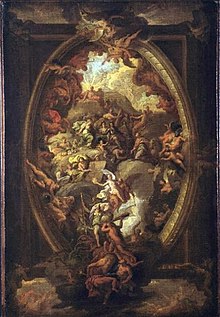
TheIndustrial Revolutionbegan in Britain due to the social, economic and political changes in the country during the previous centuries. The stable political situation in Britain from around 1688 following theGlorious Revolution,in contrast to other European countries whereabsolute monarchyremained the typical form of government, can be said to be a factor in favouring Britain as the birthplace of the Industrial Revolution.[196]Aided by these legal and cultural foundations, anentrepreneurialspirit and consumer revolution drove industrialisation in Britain.[197]Geographical and natural resource advantages of Great Britain also contributed, with the country's extensive coast lines and many navigable rivers in an age where water was the easiest means of transportation. Britain also had high quality coal.
HistorianJeremy Blackstates, "an unprecedented explosion of new ideas, and new technological inventions, transformed our use of energy, creating an increasingly industrial and urbanised country. Roads, railways and canals were built. Great cities appeared. Scores of factories and mills sprang up. Our landscape would never be the same again. It was a revolution that transformed not only the country, but the world itself."[196]

Pottery manufacturerJosiah Wedgwoodwas one of the most successful entrepreneurs of the Industrial Revolution. Meeting the demands of the consumer revolution and growth in wealth of the middle classes that helped drive the Industrial Revolution in Britain, Wedgwood created goods such assoft-paste porcelaintableware(bone china), which was starting to become a common feature on dining tables.[196]Credited as a pioneer of modernmarketing,Wedgwood pioneereddirect mail,money back guarantees,travelling salesmen,carrying pattern boxes for display,self-service,free delivery,buy one get one free,and illustrated catalogues.[198]Other important figures in marketing and advertising in the 18th and 19th centuries wereThomas Chippendale,the Londoncabinet-makerwho in 1754 produced the "first comprehensivetrade catalogueof its kind ",[199]andThomas J. Barratt,who became the first brand manager of a company (Pears soap) in 1865. In 1882, English actress and socialiteLillie Langtrywas recruited by Barratt to become the poster-girl for Pears (which included putting her "signature" on the advertisements), as she became the first celebrity to endorse a commercial product.[200]
Described as "natural capitalists" by theBBC,dynasties ofQuakerswere successful in business matters, and they contributed the Industrial Revolution in Britain. This included ironmaking byAbraham Darby Iand his family; banking, includingLloyds Bank(founded bySampson Lloyd),Barclays Bank,Backhouse's BankandGurney's Bank;life assurance (Friends Provident); pharmaceuticals (Allen & Hanburys); the big three British chocolate companies (Cadbury,Fry'sandRowntree); biscuit manufacturing (Huntley & Palmers); match manufacture (Bryant and May) and shoe manufacturing (Clarks). With his role in the marketing and manufacturing ofJames Watt's steam engine, and invention of moderncoinage,Matthew Boultonis regarded as one of the most influential entrepreneurs in history.[201]In 1861, Welsh entrepreneurPryce Pryce-Jonesformed the firstmail orderbusiness, an idea which would change the nature ofretail.Selling Welshflannel,he created mail order catalogues, with customers able order bymailfor the first time, and the goods were delivered byrailway.[202]
Cars
[edit]The UK has had a long history of car making. Some of the best known British brands areRolls-Royce,Bentley,Aston Martin,McLaren,Jaguar,Land Rover,MG,and theMini.Rolls-Royce was founded byCharles Stewart Rollsand SirFrederick Henry Roycein 1906. In addition to the company's reputation for superior engineering quality in its cars, Rolls-Royce Limited was known for manufacturing the high-powered "R" engines, including the iconicRolls-Royce Merlinaero engine which was used for many World War II aircraft.[203]Bentley Motors Limited was founded byW. O. Bentleyin 1919 inCricklewood,North London, and, like Rolls-Royce, is regarded as a British luxury automobile icon. Aston Martin was founded in 1913 by Lionel Martin andRobert Bamford,and became associated with luxury grand touring cars in the 1950s and 1960s, and with the fictional British spyJames Bond.Jaguar was founded in 1922. TheJaguar E-Typesports car was released in 1961;Enzo Ferraricalled it "the most beautiful car ever made".[204]Jaguar has, in recent years, manufactured cars for theBritish Prime Minister.The company also holdsroyal warrantsfrom QueenElizabeth IIandPrince Charles.The Land Rover launched in 1948 and specialises infour-wheel-drive.Many models have been developed for theMinistry of Defence(MoD). The Mini was released by theBritish Motor Corporationin 1959 and became a 1960s cultural icon. The performance versions, the Mini Cooper, was a successful rally car. The distinctive two-door Mini was designed for BMC bySir Alec Issigonis.It has been named Britain's favourite car in a poll.[205]
Religion
[edit]Forms ofChristianityhave dominated religious life in what is now the United Kingdom for more than 1,400 years.[206]Anglicanchurches remain the largest faith group in each country of the UK except Scotland, where Anglicanism is a small minority. The Presbyterian Church of Scotland is the national church in Scotland.[207]Following this isRoman Catholicismand religions includingIslam,Hinduism,Sikhism,Judaism,andBuddhism.TodayBritish Jewsnumber around 300,000; the UK has thefifth largest Jewish community worldwide.[208]

William Tyndale's 1520s translation of the Bible was the first to be printed in English, and was a model for subsequent English translations, notably theKing James Versionin 1611. TheBook of Common Prayerof 1549 was the first prayer book to include the complete forms of service for daily and Sunday worship in English, and the marriage and burial rites have found their way into those of other denominations and into the English language.
In 17th-century England, thePuritanscondemned the celebration ofChristmas.[209]In contrast, the Anglican Church "pressed for a more elaborate observance of feasts, penitential seasons, and saints' days. The calendar reform became a major point of tension between the Anglicans and Puritans."[210]TheCatholic Churchalso responded, promoting the festival in a more religiously orientated form. KingCharles I of Englanddirected his noblemen and gentry to return to their landed estates in midwinter to keep up their old-style Christmas generosity. Following theParliamentarianvictory over Charles I in theEnglish Civil War,Puritan rulers banned Christmas in 1647.[211]
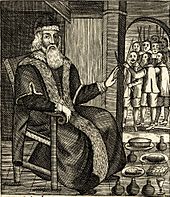
Protests followed as pro-Christmas rioting broke out in several cities; and for weeksCanterburywas controlled by the rioters, who decorated doorways withhollyand shoutedroyalistslogans.[209]The book,The Vindication of Christmas(London, 1652), argued against the Puritans, and notes old English Christmas traditions: dinner, roast apples on the fire, card playing, dances with "plow-boys" and "maidservants", old Father Christmas and carol singing.[212]TheRestorationofKing Charles IIin 1660 ended the ban.
Following the Restoration,Poor Robins Almanackcontained the lines:
- Now thanks to God for Charles return
- Whose absence made old Christmas mourn
- For then we scarcely did it know
- Whether it Christmas were or no.[213]
The diary of James Woodforde, from the latter half of the 18th century, details Christmas observance and celebrations associated with the season over a number of years.[214]
In the early 19th century, writers imaginedTudorChristmas as a time of heartfelt celebration. In 1843,Charles Dickenswrote the novelA Christmas Carolthat helped revive the "spirit" of Christmas and seasonal merriment.[215][216]Dickens sought to construct Christmas as a family-centred festival of generosity, linking "worship and feasting, within a context of social reconciliation."[217]Superimposing his humanitarian vision of the holiday, termed "Carol Philosophy",[218]Dickens influenced many aspects of Christmas celebrated today in Western culture, such as family gatherings, seasonal food and drink, dancing, games, and a festive generosity of spirit.[219]A prominent phrase from the tale,"Merry Christmas",was popularised following its publication.[220]The termScroogebecame a synonym formiser,with"Bah! Humbug!"dismissive of the festive spirit.[216]Tiny Timsays "God bless us, every one!" which he offers as ablessingatChristmas dinner.Dickens repeats the phrase at the end of the story; symbolic of Scrooge's change of heart.

The revival of theChristmas Carolbegan withWilliam Sandys'sChristmas Carols Ancient and Modern(1833), with the first appearance in print of "The First Noel","I Saw Three Ships","Hark the Herald Angels Sing"and"God Rest Ye Merry, Gentlemen".In 1843 the first commercialChristmas cardwas produced byHenry Cole,leading to the exchange of festive greeting cards among the public. The movement coincided with the appearance of theOxford Movementand the growth ofAnglo-Catholicism,which led a revival in traditional rituals and religious observances.[221]
In the UK, theChristmas treewas introduced in the early 19th century, following thepersonal unionwith theKingdom of Hanover,byCharlotte of Mecklenburg-Strelitz,wife ofKing George III.In 1832, the futureQueen Victoriawrote about her delight at having a Christmas tree, hung withlights,ornaments,andpresentsplaced round it.[222]After her marriage to her German cousinPrince Albert,a hugely influential image of the British royal family with their Christmas tree at Windsor Castle was published in theIllustrated London Newsin 1848, after which the custom became more widespread throughout Britain.[223]
While2001 censusinformation suggests that over 75% of British citizens consider themselves to belong to a religion,Gallupreports that only 10% of British citizens regularly attendreligious services.[224]A 2004 YouGov poll found that 44% of British citizens believe in God, while 35% do not.[225]Christmas and Easter are nationalpublic holidays in the UK.[226]First broadcast over the Easter period in 1977, the two-partJesus of Nazarethtelevision miniseries, starringRobert Powellas Jesus, was watched by over 21 million viewers in the UK. In 1844 SirGeorge WilliamsfoundedYMCA(Young Men's Christian Association) in London. The oldest and largest youth charity in the world, its aim is to support young people to belong, contribute and thrive in their communities.[227]The Salvation Armyis a Christian charity founded byWilliam Boothand his wifeCatherinein London's East End in 1865. It seeks to bring salvation to the poor, destitute and hungry.[228]
Politics and government
[edit]The Crown and parliament
[edit]The UK has aparliamentary governmentbased on theWestminster systemthat has been emulated around the world – a legacy of theBritish Empire.TheParliament of the United Kingdomthat meets in theHouses of Parliamenthas two houses: an electedHouse of Commonsand an appointedHouse of Lords,and any Bill passed requiresRoyal Assentto become law. It is the ultimate legislative authority in the United Kingdom: the devolved parliaments and assemblies inScotland,Northern IrelandandWalesare not sovereign bodies and could be abolished by the UK Parliament, despite each being established following public approval as expressed in areferendum.[229]
The UK's twomajor political partiesare theLabour Partyand theConservative Party,who between them won 568 out of 650 seats in the House of Commons at themost recent general election.Currently, the third biggest party in terms of seats in the Commons is theScottish National Party(SNP). At themost recent election,the SNP won 48 out of the 59 Scottish constituencies. TheLiberal Democrats,or Lib Dems, were the fourth largest, at 11 seats. One seat was won by theGreen Party.The remaining seats were won by regional parties, namelyPlaid Cymru(Wales), theAlliance Party of Northern Ireland,theSocial Democratic and Labour Party,Democratic Unionist Party,andSinn Féin(Northern Ireland).

A prominent part of British political culture,Prime Minister's Questions– often referred to as "PMQs" – is held every Wednesday at noon when the House of Commons is sitting. ThePrime Ministerspends around half an hour responding to questions fromMembers of Parliament(MPs). In questioning the policies of government ministers, MPAmber Ruddstates "PMQs is central to our democracy."[230]Due to the drama of the sessions, PMQs is among the best-known parliamentary business in the country. It is broadcast live onBBC News,Sky NewsandBBC Parliamenttelevision channels, as well as streamed online by many news outlets via numerous services, such asTwitchorYouTube.
The United Kingdom has anuncodified constitution,theConstitution of the United Kingdom,consisting mostly of a collection of disparate written sources, includingstatutes,judge-madecase law,and international treaties. As there is no technical difference between ordinary statutes and constitutional law, theBritish Parliamentcan perform constitutional reform simply by passingActs of Parliamentand thus has the political power to change or abolish almost any written or unwritten element of the constitution. However, no Parliament can pass laws that future Parliaments cannot change.[231]
The law
[edit]British constitutional documents includeMagna Carta(foundation of the "great writ"Habeas corpus— safeguarding individual freedom against arbitrary state action), theBill of Rights 1689(one provision grantingfreedom of speechin Parliament),Petition of Right,Habeas Corpus Act 1679andParliament Acts 1911 and 1949.A separate but similar document, theClaim of Right Act,applies in Scotland. JuristAlbert Venn Diceywrote that the British Habeas Corpus Acts "declare no principle and define no rights, but they are for practical purposes worth a hundred constitutional articles guaranteeing individual liberty".[232]An advocate of the "unwritten constitution", Dicey stated English rights were embedded in the general Englishcommon lawof personal liberty, and "the institutions and manners of the nation".[233]
According to 2016 figures from theMinistry of Justice,there is a 35% chance of people in England and Wales being summoned forjury dutyover the course of their lifetime. In Scotland the percentage is higher due to Scotland having a lower population as well having juries made up of fifteen people as opposed to twelve in England and Wales.[234]

The 17th-century English patriotJohn Hampdenwas a leading parliamentarian involved in challenging the authority ofCharles Iwhen he refused to be taxed forship moneyin 1637, and was one of theFive Memberswhose attempted unconstitutional arrest by the King in theHouse of Commonsin 1642 sparked theEnglish Civil War.The wars established the constitutional rights of parliament, a concept legally established as part of theGlorious Revolutionin 1688 and the subsequentBill of Rights 1689.Since that time, no British monarch has entered the House of Commons when it is sitting.[236]Hampden is annually commemorated at theState Opening of Parliamentby the British monarch when the doors of theHouse of Commonsare slammed in the face of themonarch's messenger,symbolising the rights of Parliament and its independence from the monarch.[236]
Other important British political figures include SirEdward Coke,17th-century jurist; the legal directive that nobody may enter a home, which in the 17th-century would typically have been male owned, unless by the owners invitation or consent, was established as common law in Coke'sInstitutes of the Lawes of England."For a man's house is his castle, et domus sua cuique est tutissimum refugium [and each man's home is his safest refuge]." It is the origin of the famous dictum, "an Englishman's home is his castle".[237]SirWilliam Blackstone,18th-century jurist, judge and politician best known for hisCommentaries on the Laws of England,containing his formulation: "It is better that ten guilty persons escape than that one innocent suffer", a principle that government and the courts must err on the side of innocence,[238]Emmeline Pankhurst,leading suffragette which helped win women theright to vote,William Wilberforce,leading parliamentaryabolitionist.An influential thinker in the history ofliberalism,19th century philosopher, political economist and politicianJohn Stuart Milljustified the freedom of the individual in opposition to unlimited state and social control. A member of theLiberal Party,he was also the first Member of Parliament to call for women's suffrage.[239]
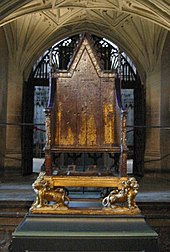
Robert Walpoleis generally regarded as the first British Prime Minister (1721–1742). Twice Prime Minister, SirRobert Peel,founded the Conservative party (which was expanded byBenjamin Disraeli), and created the modern police force.[240]Margaret Thatcherwas the first female British Prime Minister (1979–1990). She became known as the "Iron Lady", a term coined by a Soviet journalist for her uncompromising politics and leadership style. In 1938,Neville Chamberlainbelieved he had secured "Peace for our time"with Germany, a year before WWII broke out.
English poetWilliam Cowperwrote in 1785, "We have no slaves at home – Then why abroad? Slaves cannot breathe in England; if their lungs receive our air, that moment they are free, They touch our country, and their shackles fall. That's noble, and bespeaks a nation proud. And jealous of the blessing. Spread it then, And let it circulate through every vein."[241]Thomas Clarksondescribed fellow British abolitionistJosiah Wedgwood's 1787 anti-slavery medallion, "Am I Not A Man And A Brother?",as" promoting the cause of justice, humanity and freedom ".[242]Following theSlave Trade Act 1807,Britain pressed other nations to end their trade with a series of treaties,[243]and in 1839 the world's oldest international human rights organisation,Anti-Slavery International,was formed in London, which worked to outlaw slavery abroad; Wilberforce's abolitionist colleague Thomas Clarkson was the organisation's first key speaker.[244]The1965 suspension of the death penaltyfor murder had been introduced to Parliament as aprivate member's billbySydney SilvermanMP.[245]The world's largest human rights organisation,Amnesty International,was founded byPeter Benensonin London in 1961.[246]
Honours system
[edit]TheBritish honours systemis a means of rewarding individuals' personal bravery, achievement or service to the United Kingdom. Candidates are identified by public or private bodies or by government departments or are nominated by members of the public. Nominations are reviewed byhonours committees,made up of government officials and private citizens from different fields, who meet twice a year to discuss the candidates and make recommendations for appropriate honours to be awarded by the King.[247]
Historically aknighthoodwas conferred upon mountedwarriors.By theLate Middle Ages,the rank had become associated with the ideals ofchivalry,a code of conduct for the perfectcourtlyChristian warrior. An example of warrior chivalry in medieval literature isSir Gawain(King Arthur's nephew and aKnight of the Round Table) inSir Gawain and the Green Knight(late 14th century). Since theearly modern period,the title of knight is purely honorific, usually bestowed by a monarch, often for non-military service to the country. The modern female equivalent in the UK isdamehood.The ceremony often takes place atBuckingham Palace,and family members are invited to attend.[248]
A few examples of knights areSir Nicholas Winton:for "services to humanity, in saving Jewish children from Nazi occupied Czechoslovakia",[249]Sir Elton John:for "services to music and charitable services",Sir Ridley Scott:for "services to the British film industry",[250]andSir Richard Branson:for "services to entrepreneurship".[251]Examples of dames are: actressDame Julie Andrewsand singerDame Shirley Bassey:both for "services to the performing arts", actressDame Joan Collins:for "services to charity", andDame Agatha Christie:for "contribution to literature".[252]
Counties
[edit]The suffix "shire"is attached to most of the names of English, Scottish and Welsh counties. Shire is a term for a division of land first used in England during the Anglo-Saxon period. Examples in England areCheshire,Hampshire,Nottinghamshire,Oxfordshire,Staffordshire,WorcestershireandYorkshire;in Scotland,Aberdeenshire,Perthshire,Inverness-shireandStirlingshire;and in Wales,Carmarthenshire,FlintshireandPembrokeshire.This suffix tends not to be found in the names of counties that were pre-existing divisions.Essex,Kent,andSussex,for example, have never borne a-shire,as each represents a formerAnglo-Saxon kingdom.SimilarlyCornwallwas aBritishkingdom before it became an English county. The term "shire" is also not used in the names of thesix traditional countiesof Northern Ireland.
Units of measurement
[edit]
Use of the Britishimperial system of measure,particularly among the public, is widespread in the United Kingdom and is in many cases permitted by the law.[253]Human height and weight, long distances and speed are measured in imperial units by the vast majority of Brits.[254]A Brit would normally give their weight as "12 and a half stone" rather than 80 kilograms, though younger people increasingly use kilograms rather than stone.[255][254]Body height is usually given infeetandinches.[253]Younger generations tend to use more metric units of measurement, creating a generational gap, for example in short distances and item weight.[254]Although the majority of Brits now usedegrees Celsiusto measure temperature, the use ofFahrenheitpersists in older generations.[254]Distances shown on road signs must be inmilesandyards,whilemiles per hourappear on speed limit signs and car speedometers.[256]
Britain has been transitioning to metric since 1965, when the UK Government announced financial support formetricationwith a target of 10 years.[257]When the UK joined the European Economic Community in 1973, the UK re-affirmed its commitment to metrication,[257]but in 2007, the European Commission abandoned completely the deadline for full metrication in the UK.[258]
Driving
[edit]By custom and law, traffic in Britaindrives on the left.Research shows that countries driving on the left have a lower collision rate than those that drive on the right, and it has been suggested that this is partly because the predominantly better-performing right eye is used to monitor oncoming traffic and the driver's wing mirror.[259]The name of thezebra crossingis attributed to BritishMPand subsequent Prime Minister,James Callaghan,who in 1948 visited theTransport Research Laboratorywhich was working on a new idea for safe pedestrian crossings. On being shown a design he is said to have remarked that it resembled a zebra.[260]Located inBirmingham,theGravelly Hill Interchange's colloquial name "Spaghetti Junction"was coined by journalists from theBirmingham Evening Mailon 1 June 1965. In 1971, theGreen Cross Codewas introduced to teach children safer road crossing habits. From 1987,Mungo Jerry's song "In the Summertime"featured in drink driving adverts. The building ofroundabouts(circular junctions) grew rapidly in the 1960s; there are now more than 10,000 in the UK[261]TheCat's eyeretroreflective safety device used in road marking was invented byPercy Shawin 1933.
Cuisine
[edit]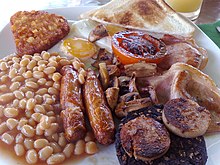
British cuisineis the specific set of cooking traditions and practices associated with the United Kingdom. Historically, British cuisine meant "unfussy dishes made with quality local ingredients, matched with simple sauces to accentuate flavour, rather than disguise it".[262]International recognition of British cuisine was historically limited to thefull breakfastand theChristmas dinner.[263]However,Celtic agricultureand animal breeding produced a wide variety of foodstuffs for indigenousCelts.Anglo-Saxon Englanddeveloped meat and savoury herb stewing techniques before the practice became common in Europe. TheNorman conquestintroduced exotic spices intoGreat Britain in the Middle Ages.[263]TheBritish Empirefacilitated a knowledge ofIndia's food traditionof "strong, penetrating spices and herbs".[263]
Each country within the United Kingdom has its own specialities. Traditional examples ofEnglish cuisineinclude theSunday roast;featuring aroasted joint,usuallyroast beef(a signature English national dish dating back to the 1731 ballad "The Roast Beef of Old England"),lambor chicken, served with assorted boiled vegetables,Yorkshire puddingandgravy.Thefull English breakfastconsists ofbacon,grilled tomatoes, fried bread,baked beans,friedmushrooms,sausages and eggs.Black puddingandhash brownsare often also included. It is usually served with tea or coffee. TheUlsterversion – Ulster fry – includessoda farlandpotato bread,with the BBC's Simon Majumdar calling it the UK's best full breakfast.[264]
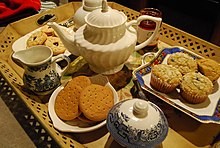
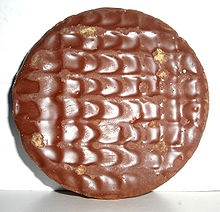
Fish and chipsare also regarded as a national institution:Winston Churchillcalled them "the good companions",John Lennonsmothered them in tomato ketchup, whileGeorge Orwellreferred to them as a "chief comfort" of the working class.[265]The meal was created in 1860 in the East End of London by a Jewish immigrant, Joseph Malin, who came up with the idea of combining fried fish with chips.[265]Ablue plaqueatOldham's Tommyfield Market marks the 1860s origin of thefish and chip shopandfast foodindustries.[266]Variousmeat piesare consumed such assteak and kidney pie,shepherd's pie,cottage pie,Cornish pastyandpork pie.
A quintessential British custom,afternoon tea,is a small meal typically eaten between 4 pm and 6 pm. The most popular drink in Britain, tea became more widely drunk due toCatherine of Braganza.It is traditionally accompanied withbiscuits,sandwiches,scones,cakesor pastries (such asBattenberg cake,fruit cakeorVictoria sponge). In his 1946 essay "A Nice Cup of Tea",authorGeorge Orwellwrote: "Tea is one of the mainstays of civilisation in this country."[267]McVitie'sare the best sellingbiscuitbrand in the UK, and the most popular biscuits to"dunk"in tea, with McVitie'schocolate digestives,rich teaandhobnobsranked the nation's top three favourite biscuits.[268]Other popular British biscuits includebourbons,custard creams,Jammie Dodgers,ginger nutsandshortbread.[268]The first documented figure-shaped biscuits (gingerbread man) was at the court ofElizabeth Iin the 16th century.[269]

The first English recipe forice creamwas published inMrs. Mary Eales's Receiptsin London in 1718, and arguably the earliest reference to an edibleice cream cone,appears inCharles Elmé Francatelli's 1846The Modern Cook.[270] The 18th-century English aristocratJohn Montagu, 4th Earl of Sandwichis best known for his links to the modern concept of thesandwichwhich was named after him. When he ordered his valet to bring him meat tucked between two pieces of bread, others began to order "the same as Sandwich!".[271]In the city of Leeds in 1767,Joseph Priestleymade his "happiest" discovery when he inventedcarbonated water(also known as soda water), the major and defining component of mostsoft drinks.[272]Carbonatedlemonadewas available in British refreshment stalls in 1833, withR. White's Lemonadesold in 1845. By 1887 they sold a wide variety of soft drink flavours.Irn-Bruis the best-selling soft drink in Scotland. Invented by a Newcastle pharmacist in 1927,Lucozadeis the No. 1 sports drink in the UK.
Sausages are commonly eaten asbangers and mash,insausage rollsor astoad in the hole.Lancashire hotpotis a well-known stew. Popular cheeses includeCheddarandWensleydale.Sweet British dishes include scones,apple pie,mince pies,spotted dick,Eccles cakes,pancakes,sponge cake,trifle,jelly,custard,sticky toffee pudding,Tunnock's teacake,andJaffa cakes;the best-selling cake in the UK.Marmaladeis a popular British spread for toast or sandwich: a spread famous for its association withPaddington Bear,a beloved bear in British culture that featured in the critically acclaimed filmsPaddington(2014) andPaddington 2(2017).[273]

Homebakinghas always been a significant part of British home cooking. Influential cookbooks includeThe Experienced English Housekeeper(1769),Modern Cookery for Private Families(1845) by food authorEliza Actonthat introduced the now-universal practice of listing ingredients and giving suggested cooking times for each recipe, andIsabella Beeton'sBook of Household Management(1861). Home-made cakes and jams are part of the traditional English villagefête.Filmed in bunting-draped marquees in scenic gardens, the success of the 2010s television showThe Great British Bake Off(which was inspired by the village fête) is credited with spurring a renewed interest in home baking, with supermarkets and department stores in the UK reporting sharp rises in sales of baking ingredients and accessories. A popular cake to bake,Victoria sponge(named afterQueen Victoriawho enjoyed a slice with her tea), was created following the discovery ofbaking powderby English food manufacturerAlfred Birdin 1843, which enabled the sponge to rise higher in cakes.[274]
Thehot cross bunis a popular British sweet bun traditionally eaten on Good Friday, but are now eaten all year round.[275]Treacle tartwas created after the invention ofgolden syrupby chemists working forAbram Lylein 1885. With its logo and green-and-gold packaging having remained almost unchanged since then,Lyle's Golden Syrupwas listed byGuinness World Recordsas having the world's oldestbrandingand packaging.[276]Scottish cuisineincludesArbroath smokieandhaggis;Northern Irish cuisinefeatures theUlster fryand thepastieandWelsh cuisineis noted forWelsh rarebit(often usingWorcestershire sauce) andcawl.Brown sauceis a traditional British condiment, with its best known varietyHP Sauce(named after and featuring an image of theHouses of Parliamenton the label) a popular spread on chicken andbacon sandwiches.The ScottishAberdeen Angusis a popular nativebeefbreed, accounting for almost 20% of the UK beef industry.[277]Cavendish bananaswere cultivated by SirJoseph Paxtonin the greenhouses ofChatsworth House,Derbyshire in 1836.[278]Named afterWilliam Cavendish,they make up the vast majority ofbananasconsumed in the western world.[278]
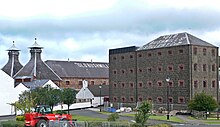
Thepubis an important aspect of British culture, and is often the focal point of local communities. Referred to as their "local" by regulars, pubs are typically chosen for their proximity to home or work, the availability of a particularbeeroraleor a good selection, good food, a social atmosphere, the presence of friends and acquaintances, and the availability ofpub gamessuch asdartsorsnooker.Pubs will often screen sports events, such asEnglish Premier LeagueandScottish Premier Leaguegames (or for international tournaments, theFIFA World Cup). Thepub quizwas established in the UK in the 1970s.
Initially created to draw in pre-literate drinkers,[280]in 1393,Richard IIintroduced a law that pubs had to display a sign outdoors to make them easily visible for passingale tasterswho would assess the quality of ale sold.[281]Most pubs still have decorated signs hanging over their doors. The owner or tenant (licensee) is known as the pub landlord or publican, while barmaids are a common feature in pubs. Alcoholic drinks served in pubs include wines andEnglish beerssuch asbitter,mild,stoutandbrown ale.Whiskyoriginated in Ireland and Scotland in theMiddle Ages:Irish whiskeyandScotch whisky.[282]
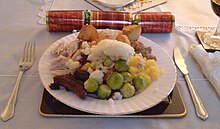
On Christmas Day, goose was previously served atdinner;however since appearing on Christmas tables in England in the late 16th century, theturkeyhas become more popular, withChristmas puddingserved for dessert.[283]The 16th-century English navigatorWilliam Stricklandis credited with introducing the turkey into England, and 16th-century farmerThomas Tussernoted that by 1573 turkeys were common in theEnglish Christmas dinner.[284]This custom gave rise to the humorous English idiom, "liketurkeys voting for Christmas".[285]The turkey is sometimes accompanied withroast beeforham,and is served withstuffing,gravy,roast potatoes,mashed potatoes andvegetables.Invented in London in the 1840s,Christmas crackersare an integral part of Christmas celebrations, often pulled before or after dinner, or at parties.[286]
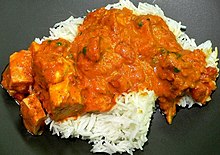
Chinese restaurantsand takeaways (in addition to Indian) are among the most popular ethnic food in the UK.[287]Chinese takeaways are a common sight in towns throughout the UK, and many serve a pseudo-Chinese cuisine based on western tastes (such as chicken fried rice, chips and curry sauce).[288]
The earliest recipe for thecrisp( "potato chip" ) is in English food writerWilliam Kitchiner's 1822 cookbookThe Cook's Oracle.[289]In 1920, Frank Smith ofThe Smiths Potato Crisps CompanyLtd packaged a twist of salt with his crisps in greaseproof paper bags, which were sold around London.[290]Crisps remained otherwise unseasoned until an important scientific development in the 1950s. AfterArcher MartinandRichard Synge(while working in Leeds) received a Nobel Prize for the invention ofpartition chromatographyin 1952, food scientists began to develop flavours via agas chromatograph,a device that allowed scientists to understand chemical compounds behind complex flavours such as cheese.[291]In 1954, Irish crisps companyTaytoproduced the first seasoned crisps: Cheese & Onion.[292]Golden Wonder(Smiths' main competitor in Britain) produced their Cheese & Onion version, and Smith's countered with Salt & Vinegar (tested first by their north-east England subsidiaryTudor) which launched nationally in 1967, starting a two-decade-long flavour war.[293][294]The crisp market in the UK is led byWalkers(who introduced their own flavours in 1954), holding 56% of the market share.

TheQuakers,founded byGeorge Foxin 1650s England and described by the BBC as "natural capitalists", had a virtual monopoly in the British chocolate industry for much of the 19th and 20th centuries, led byCadburyof Birmingham,Fry'sof Bristol andRowntree'sandTerry'sof York.[295]Fry's produced the firstchocolate barin 1847, which was then mass-produced asFry's Chocolate Creamin 1866.[296]The chocolate barsCadbury Dairy Milk,GalaxyandKit Kat,are the three best selling bars in the UK.[297]Cadbury Creme Eggsare the best selling confectionery item between New Year's Day and Easter in the UK, with annual sales in excess of 200 million. Sponsored by Cadbury, the annual children'sEaster egg hunttakes place in over 250 locations in the UK. Created in Doncaster, Yorkshire,Butterscotchboiled sweets is one of the town's best known exports. Created in Lancashire,Jelly Babiesare among the British public's favourite sweets.After Eightsare a popular after dinner mint. Astick of rock(a hard cylindrical stick-shaped boiled sugar) is a traditional British seaside sweet, commonly sold at seaside resorts throughout the UK such asBrighton,PortrushandBlackpool.A "99 Flake"(commonly called a" 99 ") which consists of ice cream in aconewith aCadbury Flakeinserted in it, is a hugely popular British dessert.[298]
Sport
[edit]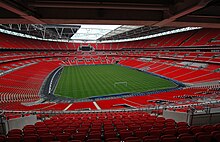
Most of the major sports have separate administrative structures and national teams for each of thecountries of the United Kingdom.Though each country is also represented individually at the Commonwealth Games, there is a single 'Team GB' (for Great Britain) that represents the UK at theOlympic Games.With the rules and codes of many modern sports invented and codified in late 19th-centuryVictorian Britain,in 2012, IOC PresidentJacques Roggestated; "This great, sports-loving country is widely recognized as the birthplace of modern sport. It was here that the concepts of sportsmanship and fair play were first codified into clear rules and regulations. It was here that sport was included as an educational tool in the school curriculum".[300][301]
Football
[edit]Both in participation and viewing, themost popular sport in the UKis association football.[302]The sport's origin can be traced toEnglish public school football games.Theruleswere first drafted in England in 1863 byEbenezer Cobb Morley,and the UK has the oldest football clubs in the world.[303]England is recognised as the birthplace of club football byFIFA,withSheffield F.C.,founded in 1857, the world's oldest football club.[304]Thehome nationsall have separate national teams and domestic competitions, most notably England'sPremier LeagueandFA Cup,and theScottish PremiershipandScottish Cup.The top three Welsh football clubs feature in the English league system. The first international football match was betweenScotlandandEnglandin 1872.[305]Referred to as the "home of football" by FIFA, England hosted the1966 FIFA World Cup,and won the tournament.[306]The British television audience for the 1966 World Cupfinalpeaked at 32.30 million viewers, making it themost watched television event everin the UK.[52]
The four home nations have produced some of the greatest players in the game's history, including, from England,Bobby MooreandGordon Banks;from Northern Ireland,George BestandPat Jennings;from Scotland,Kenny DalglishandJimmy Johnstone;and from Wales,Ian RushandRyan Giggs.The first recipient of theBallon d'Or,Stanley Matthewswas knighted while still a player. The EnglishPremier League(formed in 1992 by member clubs of the oldFootball League First Division) is the most-watched football league in the world,[307]and its biggest clubs includeManchester United,Liverpool,Arsenal,Chelsea,Tottenham HotspurandManchester City.Scotland'sCelticandRangersalso have a global fanbase.Leicester City's 2016 Premier League title win is regarded among the greatest sporting upsets ever.

The best-placed teams in the domestic leagues of England and Scotland qualify for Europe's premier competition, theUEFA Champions League(European Cup). Previous winners from the UK are Liverpool, Manchester United,Nottingham Forest,Celtic, Chelsea andAston Villa.TheUEFA Champions League Anthem,written byTony Brittenand based on Handel'sZadok the Priest,is played before each game.[308]Henry Lyte's Christian hymn "Abide with Me"is sung prior to kick-off at everyFA Cup Final,a tradition since1927.
The practice of "jumpers for goalposts" alludes tostreet/park footballin the UK wherejumperswould be placed on the ground and used asgoalposts.This practice was referenced by singerEd Sheeranin his DVDJumpers for Goalposts: Live at Wembley Stadiumas a nod to playing concerts at Wembley Stadium, the home of English football. Early references todribblingcome from accounts of medieval football games in England.Geoffrey Chauceroffered an allusion to such ball skills in 14th-century England. InThe Knight's Tale(from theCanterbury Tales) he uses the following line: "rolleth under foot as doth a ball".[309]
Football in Britain is renowned for the intense rivalries between clubs and the passion of the supporters, which includes a tradition offootball chants,which are one of the last remaining sources of an oral folk song tradition in the UK.[310]Chants include "You're Not Singing Any More"(or its variant" We Can See You Sneaking Out! "), sung by jubilant fans towards the opposition fans who have gone silent (or left early).[311]Many teams in the UK have their own club anthem or have a song closely associated with them, for example "You'll Never Walk Alone"by Liverpool-based rock bandGerry and the Pacemakers,and "Local Hero"byDire Straitsfrontman andNewcastle UnitedfanMark Knopfler,is played before the start of every Liverpool and Newcastle home game.[312]
Throughout the UK,meat pies(as well as burgers and chips) is a traditional hot food eaten at football games either before kick-off or during half time. The purchase of afootball programme(a pre-match magazine produced by the home team that gives details on that day's game, including player profiles, recent form, interviews etc.) is also part of the 'ritual' of attending a football match in the UK. The Football Association dropped its ban onfloodlightsin 1950, and night games attracted increasingly large crowds of fans–some of them unruly—as well as large television audiences. Architects built bigger stadia, and "their cantilevered constructions dwarfing mean streets, supplanted the cathedral as a symbol of the city's identity and aspirations".[313]
Golf
[edit]The modern game ofgolforiginated in Scotland, with theFifetown ofSt Andrewsknown internationally as the "home of golf".[314]and to many golfers theOld Course,an ancientlinkscourse dating to before 1574, is considered to be a site of pilgrimage.[315]In 1764, the standard 18 hole golf course was created at St Andrews when members modified the course from 22 to 18 holes.[316]Golf is documented as being played onMusselburgh Links,East Lothian, Scotland as early as 2 March 1672, which is certified as the oldest golf course in the world by Guinness World Records.[317]The oldest knownrules of golfwere compiled in March 1744 inLeith.[318]
The oldest golf tournament in the world, and the first major championship in golf,The Open Championship,first took place in Ayrshire, Scotland in 1860, and today it is played on the weekend of the third Friday in July.[319]Golf's first superstarHarry Vardon,a member of the fabledGreat Triumviratewho were pioneers of the modern game, won the Open a record six times. Since the 2010s, three Northern Irish golfers have had major success;Graeme McDowell,Darren Clarkeand four time major winnerRory McIlroy.[320]The biennial golf competition, theRyder Cup,is named after English businessmanSamuel Ryderwho sponsored the event and donated the trophy.[321]SirNick Faldois the most successful British Ryder Cup player.
Rugby
[edit]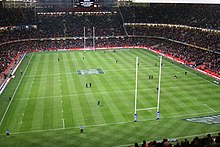
In 1845,rugby unionwas created when the first rules were written by pupils atRugby School,Warwickshire.[322]A former pupil of the schoolWilliam Webb Ellis,is often fabled with the invention of running with the ball in hand in 1823. Thefirst rugby internationaltook place on 27 March 1871, played betweenEnglandandScotland.[323]By 1881 bothIrelandandWaleshad teams, and in 1883 the first international competition the annualHome Nations Championshiptook place. In 1888, the Home Nations combined to form what is today called theBritish and Irish Lions,who now tour every four years to face a Southern Hemisphere team. The Wales team of the 1970s, which included a backline consisting ofGareth Edwards,J. P. R. WilliamsandPhil Bennettwho were known for their feints, sidesteps and attacking running rugby, are regarded as one of the greatest teams in the game – all three players were involved inThe greatest try ever scoredin 1973.Jonny Wilkinsonscored the winningdrop goalfor England in the last minute of extra time in the2003 Rugby World Cup Final.The major domestic club competitions are thePremiershipin England and theCeltic Leaguein Ireland, Scotland, Wales and (since2010) Italy. Of Cornish origin, the chant "Oggy Oggy Oggy, Oi Oi Oi!"is associated with rugby union (and its personalised variant with football); it inspired the"Maggie Maggie Maggie, Out Out Out!"chant by opponents of Prime MinisterMargaret Thatcherin the 1980s. In 1895,rugby leaguewas created inHuddersfield,West Riding of Yorkshire,as the result of a split with the other Rugby code. TheSuper Leagueis the sports top-level club competition in Britain, and the sport is especially popular in towns in the northern English counties of Yorkshire, Lancashire and Cumbria. TheChallenge Cupis the major rugby league cup competition.
Tennis
[edit]
The modern game oftennisoriginated in Birmingham, England in the 1860s, and after its creation, tennis spread throughout the upper-class English-speaking population, before spreading around the world.[325]MajorWalter Clopton Wingfieldis credited as being a pioneer of the game.[326]The world's oldest tennis tournament, theWimbledon championships,first occurred in 1877, and today the event takes place over two weeks in late June and early July.[327]Created in the Tudor period in the court of Henry VIII, the English dessertStrawberries and creamis synonymous with the British summer, and is famously consumed at Wimbledon. The tournament itself has a major place in the British cultural calendar. The eight-time Slam winner and Britain's most successful playerFred Perryis one of only seven men in history to have won all four Grand Slam events, which included three Wimbledons.[328]Virginia Wadewon three Grand Slams, the most famous of which was Wimbledon in 1977, the year of theSilver Jubileeof Queen Elizabeth II (the Queen attended Wimbledon for the first time since 1962 to watch the final). The 2013 and 2016 Wimbledon champion, Scotland'sAndy Murray,is Britain's most recent male Grand Slam winner. In 2021,Emma Raducanubecame the most recent British female Grand Slam winner.
Boxing
[edit]
The'Queensberry rules',the code of general rules inboxing,was named afterJohn Douglas, 9th Marquess of Queensberryin 1867, that formed the basis of modern boxing.[329]Britain's first heavyweight world championBob Fitzsimmonsmade boxing history as the sport's first three-division world champion. The 1980s saw the emergence of heavyweightFrank Brunowho would become hugely popular with the British public. In the 1990s,Chris Eubank,Nigel Benn,Steve CollinsandMichael Watsonhad a series of fights against each other in the super-middleweight division, drawing audiences of up to 20 million in the UK. Eubank's eccentric personality made him one of the most recognisable celebrities in the UK along with the cocky"Prince" Naseem Hamed.TheNigel Benn vs. Gerald McClellanfight in 1995 drew 13 million. Other big draw fighters in the UK includedLennox Lewis,Joe CalzagheandRicky Hatton.
Cricket
[edit]
The modern game ofcricketwas created in England in the 1830s whenround armbowling was legalised, followed by the historical legalisation ofoverarm bowlingin 1864.[330]In 1876–77,Englandtook part in the first-everTest matchagainst Australia. Influential to the development of the sport,W. G. Graceis regarded as one of the greatest cricket players, devising most of the techniques of modern batting.[331]His fame endures;Monty Python and the Holy Grailuses his image as "the face of God" during the sequence in which God sends the knights out on their quest for the grail. The rivalry between England and Australia gave birth toThe Ashesin 1882 that has remained Test cricket's most famous contest, and takes place every two years to high television viewing figures. TheCounty Championshipis the domestic competition in England and Wales. England have hosted theCricket World Cupfive times, and are the reigning champions, having won in2019.
Horse racing
[edit]Originating in 17th and 18th-century England, theThoroughbredis a horse breed best known for its use inhorse racing.Horse racing was popular with the aristocrats and royalty of British society, earning it the title "Sport of Kings".[332]Named afterEdward Smith-Stanley, 12th Earl of Derby,The Derbywas first run in 1780. The race serves as the middle leg of theTriple Crown,preceded by the2000 Guineasand followed by theSt Leger.The name "Derby"has since become synonymous with great races all over the world, and as such has been borrowed many times in races abroad.[333]
TheNational Hunthorse race theGrand National,is held annually atAintree Racecoursein early April. It is the most watched horse race in the UK, attracting casual observers, and three-time winnerRed Rumis the most successful racehorse in the event's history. Red Rum is the best-known racehorse in the UK, named by 45% of Britons, withBlack Beauty(fromAnna Sewell's novel) in second with 33%.[334]
Bolton companyJ.W. Foster and Sons's pioneeringrunning spikesappear in the book,Golden Kicks: The Shoes that changed Sport.[335]They were made famous by 1924 100 m Olympic championHarold Abrahamswho would be immortalised inChariots of Fire,the British Oscar winning film.[335]Foster's grandsons formed the sportswear companyReebokin Bolton.[335]
Motor sports
[edit]The1950 British Grand Prixwas the firstFormula OneWorld Championship race. Britain has produced some of the greatest drivers in Formula One, includingStirling Moss,Jim Clark(twice F1 champion),Graham Hill(only driver to have won theTriple Crown),John Surtees(only world champion in two and four wheels),Jackie Stewart(three-time F1 champion),James Hunt,Nigel Mansell(only man to hold F1 and IndyCar titles at the same time),Jenson ButtonandLewis Hamilton(seven-time champion). TheBritish Grand Prixis held atSilverstoneevery July. Also, the United Kingdom is home to some of the most prestigious teams in Formula One, includingMcLarenandWilliams.It is also home to the headquarters of six of the tencurrent F1 teams,including current championsMercedes,four-time championsRed Bull Racing,AlpineandAston Martin.
National sporting events
[edit]Other major sporting events in the UK include theLondon Marathon,andThe Boat Raceon theRiver Thames.The most successful malerowerin Olympic history,Steve Redgravewon gold medals at five consecutive Olympic Games. Cycling is a popular physical activity in the UK. In 1888, inventorFrank Bowdenfounded theRaleigh Bicycle Company,and by 1913, Raleigh was the biggest bicycle manufacturing company in the world. TheRaleigh Chopperwas named in the list of British design icons. In 1965Tom Simpsonbecame the first British world road race champion, and in 2012Bradley Wigginsbecame the first BritishTour de Francewinner.Chris Froomehas subsequently won the Tour de France four times (2013, 2015, 2016 and 2017). Welsh cyclistGeraint Thomaswon in 2018. Sprint specialistMark Cavendishhas won thirty Tour de France stages, putting him second on theall-time list.
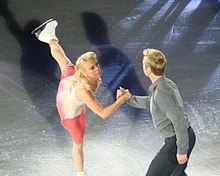
InIce Dance,many of the compulsory moves were developed by dancers from the UK in the 1930s.[337]At the1984 Winter Olympics,Jayne TorvillandChristopher Deanwon ice dancing gold with the highest-ever score for a single programme. The pair received perfect 6.0 scores from every judge for artistic impression, and twelve 6.0s and six 5.9s overall.
At the 1988 Winter Olympics, ski jumperEddie "The Eagle" Edwardsgained fame as an underdog. Eddie was portrayed byTaron Egertonin the 2016 biographical sports comedy-drama filmEddie the Eagle.
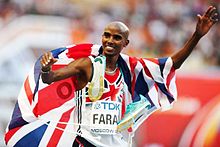
A great number of major sports originated in the United Kingdom, including association football, golf, tennis,boxing,rugby league,rugby union,cricket,field hockey,snooker,darts,billiards,squash,curlingand badminton, all of which are popular in Britain. Another sport invented in the UK was baseball,[338]and its early formroundersis popular among children in Britain.[339]Snooker and darts are popular indoor games:Stephen Hendryis the seven time world snooker champion,Phil Tayloris the 16 time world darts champion. Snooker playerAlex Higgins(nicknamedThe Hurricane) and darts playerEric Bristow(nicknamedThe Crafty Cockney) are credited with popularising each sport.
BodybuilderReg Parkwas Mr Britain in 1946 and becameMr Universein 1951, 1958 and 1965.[340]Gaelic footballis very popular in Northern Ireland, with many teams from the north winning theAll-Ireland Senior Football Championshipsince the early 2000s.William Penny Brookeswas prominent in organising the format for the modernOlympic Games,and in 1994, thenIOCPresidentJuan Antonio Samaranchlaid a wreath on Brooke's grave, and said, "I came to pay homage and tribute to Dr Brookes, who really was the founder of the modern Olympic Games".[341]
Participation in women's team sport (in addition to profile in the media) has seen a rapid increase in recent years. Popular women's team sports includeNetball Superleagueformed in 2005, theFA WSL(women's football) formed in 2010 (Kelly Smithis seen as a leading figure in the game),Women's Six Nations Championshipin rugby union, andWomen's Cricket Super League.
Sub-national sports
[edit]TheHighland gamesare held throughout the year in Scotland as a way of celebrating Scottish andCelticculture and heritage, especially that of theScottish Highlands,with more than 60 games taking place across the country every year. Each December, theBBC Sports Personality of the Yearis announced, an award given to the best British sportsperson of the year, as voted for by the British public. The public also votes for theBBC Overseas Sports Personality of the Year,presented to a non-British sportsperson considered to have made the most substantial contribution to a sport each year which has also captured the imagination of the British public. Recipients have includedPelé(after winning his third World Cup in 1970),Muhammad Ali(after regaining the heavyweight title in 1974),Jonah Lomu(for his performances at the 1995 Rugby World Cup),Ronaldo(for his comeback in winning the 2002 World Cup), andRoger Federer(for his record eighth Wimbledon in 2017).[342]
Healthcare
[edit]
Each of the four countries of the UK has a publicly fundedhealth caresystem referred to as theNational Health Service(NHS). The terms "National Health Service" or "NHS" are also used to refer to the four systems collectively. All of the services were founded in 1948, based on legislation passed by theLabourGovernment that had been elected in 1945 with a manifesto commitment to implement theBeveridge Reportrecommendation to create "comprehensive health and rehabilitation services for prevention and cure of disease".[343]
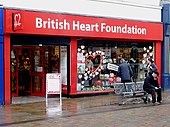
The NHS was born out of a long-held ideal that good healthcare should be available to all, regardless of wealth. At its launch by the then minister of health,Aneurin Bevan,on 5 July 1948, it had at its heart three core principles: That it meet the needs of everyone, that it be free at the point of delivery, and that it be based on clinical need, not ability to pay.[344]The NHS had a prominent slot during the2012 London Summer Olympics opening ceremonydirected byDanny Boyle,being described as "the institution which more than any other unites our nation", according to the programme.[345]Cancer Research UK,Alzheimer's Research UKandTogether for Short Livesare among hundreds of health charities in the UK.
Florence Nightingalelaid the foundation of modernnursingwith the establishment of hernursing schoolatSt Thomas' Hospitalin London. It was thefirst secular nursing school in the world,now part ofKing's College London.Nightingale wroteNotes on Nursingin 1859. The book served as the cornerstone of the curriculum at the Nightingale School and other nursing schools.[346]TheNightingale Pledgeis taken by many new nurses in the US (but not the UK), and the annualInternational Nurses Day(12 May) is celebrated around the world on her birthday. Her social reforms improved healthcare for all sections of society in the UK and around the world.[347]
Pets
[edit]Statistics
[edit]
In the UK, about 40% of the population own a pet. The top pets in the UK for 2018 and 2019 are:[349]
- Dogs: 25%
- Cats: 17%
- Rabbits, indoor birds, guinea pigs, hamsters: ≈1%
- Tortoises and Turtles: 0.7%
- Lizards: 0.6%
However, the population of pets in the UK declined from 71 million in 2013 (a significant peak) to 51 million in 2018.[350]This decline has seen some reversal as a result of theCOVID-19 pandemic;an article published in May 2021 stated that a total of 3.2 million households in the UK had acquired a pet since the start of the pandemic, according to the Pet Food Manufacturers' Association.[351]
History
[edit]Founded in 1824, theRoyal Society for the Prevention of Cruelty to Animals(RSPCA) is the oldest and largest animal welfare organisation in the world.[352]
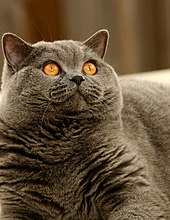
TheBritish Shorthaircat is the most popular pedigreed breed in its native country, as registered by the UK'sGoverning Council of the Cat Fancy(GCCF). The breed's broad cheeks and relatively calm temperament make it a frequent media star. The cat's profile reads: "When gracelessness is observed, the British Shorthair is duly embarrassed, quickly recovering with a 'Cheshire cat smile'".[353]There are almost one million horses and ponies in the UK, with popular native breeds includingClydesdale horse(used as drum horses by the BritishHousehold Cavalry),Thoroughbred(used in horse racing),Cleveland Bay(pull carriages in royal processions),Highland ponyandShetland pony.
The UK's indigenous dog breeds include theBulldog,Jack Russell Terrier,Golden Retriever,Yorkshire Terrier,Cavalier King Charles Spaniel,Airedale Terrier,Beagle,Border Collie,Staffordshire Bull Terrier,English Cocker Spaniel,Scottish Terrier,Welsh Corgi,Bullmastiff,Greyhound,English Springer SpanielandOld English Sheepdog.
The Kennel Club,with its headquarters in London, is the oldest kennel club in the world, and acts as a lobby group on issues involving dogs in the UK. Its main objectives are to promote the general improvement of dogs and responsible dog ownership.[354]Held since 1891,Cruftsis an annual dog show in the UK. The event takes place over four days in early March. In 1928, the very first winner ofBest in Showat Crufts was Primley Sceptre, a greyhound.
National costume and dress
[edit]
As amulti-national state,the UK has no single national costume. However, different countries within the United Kingdom have national costumes or at least are associated with styles of dress. Scotland has thekiltandTam o'shanter,andtartanclothing – its pattern consisting of criss-crossed horizontal and vertical bands in multiple colours – is a notable aspect ofGaelic culture.[355]Atraditional Welsh costumewithWelsh hatis worn by some women duringEisteddfodau.In England, the topic of a national costume has been in debate, since no officially recognized clothing is anointed "national". However, the closest to an English national costume can be the smock orsmock-frockin the Midlands and Southern England and themaudin Northern England.English Country Clothingis also very popular among rural folk,flat capsandbrogue shoesalso forming part of the country clothing.[356]
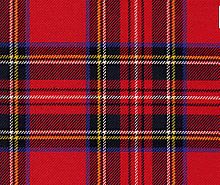
Certain militaryuniformssuch as theBeefeateror theQueen's Guardare considered to be symbolic of Englishness.Morris dancersor the costumes for the traditional EnglishMay danceare sometimes cited as examples of traditional English costume, but are only worn by participants in those events. Designed in 1849 by the London hat-makers Thomas and William Bowler, theBowler hatis arguably the most iconic stereotyped view of an Englishman (complete with Bowler and rolled umbrella), and was commonly associated with City of London businessmen. Traced back to the north of England in the 14th century, theflat capis associated with the working classes in the UK.[356]The flat cap has seen a 21st-century resurgence in popularity, possibly influenced by various British public figures wearing them, includingDavid Beckham,Harry StylesandGuy Ritchie,with clothing sellersMarks & Spencerreporting that flat cap sales significantly increased in the 2010s.[358]In 1856William Henry Perkindiscovered the firstsynthetic dye(Mauveine– a purple colour), which was suitable as a dye of silk and other textiles, helping to revolutionise the world of fashion.[359]
Burberryis most famous for creating thetrench coat:they were worn by British soldiers in the trenches in World War I.[360]Among various British youth subcultures,Dr. Martensboots (often referred to as DMs) have been the choice of footwear: in the 1960sskinheadsstarted to wear them, and they later became popular amongscooterriders,punks,and somenew wavemusicians. Malemodsadopted a sophisticated look that included tailor-made suits, thin ties, button-down collar shirts,Chelsea bootsandClarksdesert boots.[361]
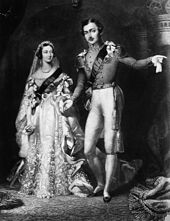
British sensibilities have played an influential role in world clothing since the 18th century. Particularly during theVictorian era,British fashions defined acceptable dress for men of business. Key figures such as the futureEdward VII,Edward VIII,andBeau Brummell,created the modernsuitand cemented its dominance. Brummell is credited with introducing and establishing as fashion the modern man's suit, worn with atie.[362]The use of a coloured and patterned tie (a common feature inBritish school uniforms) indicating the wearer's membership in a club, regiment, school, professional association etc. stems from the 1880oarsmenofExeter College, Oxford,who tied the bands of their straw hats around their necks.[363]TheWellington boot(first worn byArthur Wellesley, 1st Duke of Wellington) became a staple for outdoor wear.
The tradition of awhite weddingis commonly credited toQueen Victoria's choice to wear a white wedding dress at her wedding toPrince Albertin 1840, at a time when white was associated with purity andconspicuous consumption(because it was difficult to keep clean, and thus could not be worn by servants or labourers), and when it was the colour required of girls being presented to the royal court.[364][365]The 1981wedding dress of Lady Diana Spencerbecame one of the most famous dresses in the world, and was considered one of the most closely guarded secrets in fashion history.[366]
Fashion
[edit]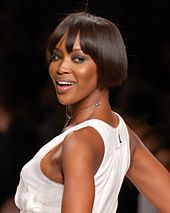
London, as one of the world's four fashion capitals, is host to theLondon Fashion Week– one of the 'Big Four' fashion weeks.[367]Organised by theBritish Fashion Council,the event takes place twice each year, in February and September. The current venue for most of the "on-schedule" events isSomerset Houseincentral London,where a large marquee in the central courtyard hosts a series of catwalk shows by top designers and fashion houses, while an exhibition, housed within Somerset House itself, showcases over 150 designers. However, many "off-schedule" events, such as On|Off and Vauxhall Fashion Scout, are organised independently and take place at other venues in central London.
British designers whose collections have been showcased at the fashion week includeVivienne Westwood,Alexander McQueen,John GallianoandStella McCartney.British models who have featured at the event includeKate Moss,Naomi Campbell,Jade Jagger,David Gandy,Cara DelevingneandRosie Huntington-Whiteley.For almost two decades,Princess Dianawas a fashion icon whose style was emulated by women around the world.[368]
Fashion designerMary Quantwas at the heart of the "Swinging London"scene of the 1960s, and her work culminated in the creation of theminiskirtandhot pants.[369]Quant named the miniskirt after her favourite make of car, theMini.[370]The Swinging London fashion scene has featured in films, and was spoofed in theAustin Powerscomedy series.[371]The English fashion designerCharles Frederick Worthis widely considered the father ofHaute couture.[372]
Symbols, flags, and emblems
[edit]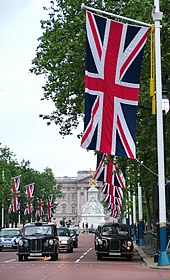
The United Kingdom as a whole has a number of national symbols, as do its constituent nations. TheUnion Flagis thenational flag of the United Kingdom.The first flag combined thecross of St Georgewith thesaltire of Saint Andrewto represent theUnion of the Crownsin 1707.St Patrick's saltirewas added when the Kingdom of Ireland was unified with Great Britain in 1801, and retained to represent Northern Ireland after partition in 1927.[373]Wales has never been represented on the Union Flag, as in 1707 it was part of theKingdom of England.Similarly, theRoyal coat of arms of the United Kingdomonly represents England, Scotland, and Northern Ireland. England occupies the first and fourth quarters of the arms except in Scotland, when its arms take precedence.Britanniais the national personification of the UK, whileJohn Bullis a personification used in satirical contexts, and the national animals are the lion and the bulldog.
The UK does not have a floral emblem, but each nation does. TheTudor roserepresents England, athistleScotland, theflax flowerandshamrockNorthern Ireland, and theleekanddaffodilWales. The rose, shamrock and thistle are engrafted on the same stem on thecoat of arms of the United Kingdom.Another major floral symbol is theremembrance poppy,which has been worn in Britain since 1921 to commemorate soldiers who have died in war. In the weeks leading up toRemembrance Sundaythey are distributed byThe Royal British Legionin return for donations to their "Poppy Appeal", which supports all current and former British military personnel.
Traditional communication and greeting cards
[edit]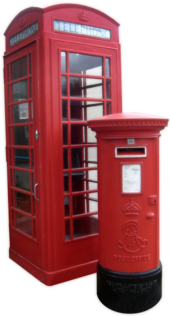
A familiar sight throughout the UK, thered telephone boxand Royal Mail redpost boxare considered British cultural icons. Designed bySir Giles Gilbertin 1924, the red telephone box features a prominentcrownrepresenting the British government. The post pillar box was introduced in the 1850s during the reign ofQueen VictoriafollowingSir Rowland Hill's postal reforms in the 1830s where thereduction in postal rateswith the invention of the postage stamp (Penny Black) made sending post an affordable means of personal communication.[180] The red telephone box has appeared in British pop culture, such as inAdele's video "Hello",the front cover ofOne Direction's albumTake Me Home,and the back cover ofDavid Bowie's albumThe Rise and Fall of Ziggy Stardust and the Spiders from Mars.[374]
The world's firstpostcardwas received byTheodore HookfromFulham,London in 1840.[375]The first pillar boxes had the distinctive Imperial cypher of Victoria Regina. Most pillar boxes produced after 1905 are made of cast iron and are cylindrical, and have served well throughout the reigns ofGeorge V,Edward VIII,George VIandElizabeth II.[376]
The sending and receiving ofgreeting cardsis an established tradition in the UK, with card sending or card display in the home being an important part of British culture.[377]
Sir Henry Coledevised the concept of sending greetings cards at Christmas time.[378]Designed byJohn Callcott Horsleyfor Cole in 1843, theChristmas cardaccounts for almost half of the volume of greeting card sales in the UK, with over 600 million cards sold annually.[377]Therobinis a common sight in gardens throughout the UK. It is relatively tame and drawn to human activities, and is frequently voted Britain's national bird in polls.[379]The robin began featuring on many Christmas cards in the mid-19th century. The association with Christmas arises from postmen in Victorian Britain who wore red jackets and were nicknamed "Robins"; the robin featured on the Christmas card is an emblem of the postman delivering the card.[380]
SendingValentine's Daycards became hugely popular in Britain in the late 18th century, a practice which has since spread to other nations.[381]The day first became associated withromantic lovewithin the circle ofGeoffrey Chaucerin the 14th century, when the tradition ofcourtly loveflourished.[382]In Chaucer'sParlement of Foules(1382) he wrote;For this was on seynt Volantynys day. When euery bryd comets there to chese his make.[382]The modern cliché Valentine's Day poem can be found in the 1784 English nursery rhymeRoses Are Red;"The rose is red, the violet's blue. 'The honey's sweet, and so are you. Thou art my love and I am thine. I drew thee to my Valentine."[383]
In 1797, a British publisher issuedThe Young Man's Valentine Writerwhich contained scores of suggested sentimentalversesfor the young lover unable to compose his own. In 1835, 60,000 Valentine cards were sent by post in the UK, despite postage being expensive.[384]A reduction in postal rates (with the 1840 invention of the postage stamp, the Penny Black) increased the practice of mailing Valentines, with 400,000 sent in 1841.[385]In the UK just under half the population spend money on gifts.[386]Other popular occasions for sending greeting cards in the UK are birthdays, Mother's Day, Easter and Father's Day.[378]
Education
[edit]Each country of the United Kingdom has a separate education system. Power over education matters in Scotland, Wales and Northern Ireland isdevolvedbut education in England is dealt with by the British government since there is nodevolved administrationfor England.
England
[edit]
Most schools came under state control in theVictorian era;a formal state school system was instituted after theSecond World War.Initially, schools were categorised asinfant schools,primary schools and secondary schools (split into more academicgrammar schoolsand more vocationalsecondary modern schools). Under the Labour governments of the 1960s and 1970s most secondary modern and grammar schools were combined to becomecomprehensive schools.England has many independent (fee-paying) schools, some founded hundreds of years ago; independent secondary schools are known aspublic schools.Eton,Harrow,ShrewsburyandRugbyare four of the best-known. The nature and peculiarities of these Public schools have frequently featured in British literature. Prior to 1999,[387]corporal punishmentwas allowed in such schools, whilst the use of corporal punishment was outlawed in state schools in 1987.[388]Most primary and secondary schools in both the private and state sectors have compulsoryschool uniforms.Allowances are almost invariably made, however, to accommodatereligious dress,including the IslamichijabandSikhbangle (kara).

Although the Minister of Education is responsible to Parliament for education, the day-to-day administration and funding of state schools is the responsibility oflocal education authorities.
England's universitiesinclude some of the highest-ranked universities in the world: theUniversity of Cambridge,Imperial College London,theUniversity of OxfordandUniversity College Londonare all ranked in the global top 10 in the 2010QS World University Rankings.TheLondon School of Economicshas been described as the world's leading social science institution for both teaching and research.[390]TheLondon Business Schoolis considered one of the world's leading business schools and in 2010 its MBA programme was ranked best in the world by theFinancial Times.[391]Academic degreesin England are usually split into classes: first class (I), upper second class (II:1), lower second class (II:2) and third (III), and unclassified (below third class).
Northern Ireland
[edit]TheNorthern Ireland Assemblyis responsible foreducation in Northern Ireland.Schools are administered by five Education and Library Boards covering different geographical areas.
Scotland
[edit]
Scotland has a long history of universal provision ofpublic educationwhich, traditionally, has emphasised breadth across a range of subjects rather than depth of education in a smaller range of subjects. The majority of schools arenon-denominational,but by law separate Roman Catholic schools, with an element of control by the Roman Catholic Church, are provided by thestate system.Qualifications at the secondary school andpost-secondary(further education) levels are provided by theScottish Qualifications Authorityand delivered through various schools, colleges and other centres. Political responsibility for education at all levels is vested in theScottish Parliamentand theScottish Executive Education and Enterprise, Transport & Lifelong Learning Departments.State schools are owned and operated by thelocal authoritieswhich act asEducation Authorities,and the compulsory phase is divided into primary school and secondary school (often calledhigh school,with the world's oldest high school being theRoyal High School,Edinburgh in 1505,[392]which colonists spread to theNew Worldowing to the high prestige enjoyed by the Scottish educational system). Schools are supported in delivering the National Guidelines and National Priorities byLearning and Teaching Scotland.
First degree courses atScottish universitiesare often a year longer than elsewhere in the UK, though sometimes students can take a more advanced entrance exam and join the courses in the second year. One unique aspect is that theancient universities of Scotlandaward aMaster of Artsdegree as the firstdegreeinhumanities.TheUniversity of Edinburghis among the top twenty universities in the world according to theQS World University Rankings2011. It is also among theAncient Universitiesof Great Britain.
Wales
[edit]
TheNational Assembly for Waleshas responsibility foreducation in Wales.A significant number of students in Wales are educated either wholly or largely through the medium of the Welsh language, and lessons in the language are compulsory for all until the age of 16. There are plans to increase the provision ofWelsh medium educationas part of the policy of promoting a fully bilingual Wales.
Outdoor education
[edit]Scoutingis the largest co-educational youth movement in the UK.[393]Scouting began in 1907 whenRobert Baden-Powell,Lieutenant General in the British Army, held thefirst Scout campatBrownsea Islandin Dorset, England.[394]Baden-Powell wrote the principles of Scouting inScouting for Boysin 1908.[395]In July 2009, adventurerBear Gryllsbecame the youngestChief Scoutever, aged 35. In 2010, scouting in the UK experienced its biggest growth since 1972, taking total membership to almost 500,000.[393]
Sociological issues
[edit]Housing
[edit]
The UK (England in particular) has a relatively highpopulation densityso housing tends to be more closely packed than in other countries. Thusterracedhouses are widespread, dating back to the aftermath of theGreat Fire of London.[396]
As the first industrialised country in the world, the UK has long been urbanised.[397]In the 20th century, suburbanisation led to a spread ofsemi-detachedand detached housing. After the Second World War, public housing was dramatically expanded to create a large number ofcouncil estates.There are many historiccountry housesandstately homesin rural areas, though only a minority of these are still used as private living accommodation.
In recent times, more detached housing has started to be built. Also, city living has boomed, with city centre populations rising rapidly. Most of this population growth has been accommodated in new apartment blocks in residential schemes in many towns and cities. Demographic changes (see below) are putting great pressure on the housing market, especially in London and theSouth East.
Living arrangements
[edit]
Historically most people in the United Kingdom lived either inconjugalextended familiesornuclear families.This reflected aneconomiclandscape where the general populace tended to have less spending power, meaning that it was more practical to stick together rather than go their individual ways. This pattern also reflectedgender roles.Men were expected to go out to work and women were expected to stay at home and look after the families.

In the 20th century theemancipation of women,the greater freedoms enjoyed by both men and women in the years following theSecond World War,greateraffluenceand easier divorce have changed gender roles and living arrangements significantly. The general trend is a rise in single people living alone, the virtual extinction of theextended family(outside certain ethnic minority communities), and thenuclear familyarguably reducing in prominence.
From the 1990s, the break-up of the traditional family unit, when combined with lowinterest ratesand other demographic changes, has created great pressure on the housing market, in particular on accommodation for "key workers"such as nurses, otheremergency serviceworkers and teachers, who are priced out of most housing, especially in theSouth East.Some research indicates that in the 21st century young people are tending to continue to live in the parental home for much longer than their predecessors.[398]
Happiness
[edit]When Brits were asked to rate their happiness yesterday on a scale of 1 to 10 in 2018, respondent's mean answer was 7.54 (ranked 'High') in 2018. Northern Irish respondents were ranked the happiest of the United Kingdom (with a mean of 7.74), followed by the English (with 7.54), then the Scots (with 7.52) and finally the Welsh (with 7.51).[399]
However, only 25% of women and girls between the ages of 7 and 21 claim to be very happy, which has fallen from 41% in 2009. They claimed that it was due to the pressure from exams and social media, which exerted undue amounts of stress on them. In that category, the oldest were the least happy: 27% of young women aged 17 to 21 claimed they were not happy, compared to 11% in 2009. This negatively influenced their confidence by 61%, health by 50%, relationships by 49% and studying by 39%. 69% of respondents in that age group claimed school exams were the chief stressor, 59% felt pressure from social media was making them less happy, and compared to 5 years ago, more claimed they had experienced unkind, threatening or negative reactions on social media. The proportion of the population who knew someone withmental health issuesrose from 62% in 2015 to 71% in 2018. Many young women and girls feel unsafe walking alone: over half aged from 13 to 21 have experienced harassment or know someone who has, and almost half feel unsafe using public transport.[400]
Feminism
[edit]The proportion of young girls considering themselves feminists has risen from 35% in 2013 to 47% in 2018. 36% of young women and girls aged 11 to 21 had spoken up about an issue that mattered to them, this rose from 28% in 2011 but only 60% felt they had been listened to. Girls have also become more interested in science, maths and technology. Girls are more likely to want to become leaders in their careers, 53% compared to 42% in 2016.Maria Millersaid, "#MeToo may have left its mark in Hollywood but for women and girls around the country their ambitions to succeed are still too often met with sexism. It's important more women and girls are now speaking out about how this behaviour undermines their confidence and mental health; but this harmful, negative behaviour has to be stopped".[400]
Naming conventions
[edit]The common naming convention throughout the United Kingdom is for everyone to have one or moregiven names(a forename, still often referred to as a "Christian name" ) usually (but not always) indicating the child's sex, and asurname( "family name" ).[401]A four-year study by theUniversity of the West of England,which concluded in 2016, analysed sources dating from the 11th to the 19th centuries to explain the origins of the surnames in theBritish Isles.[402]The study found that over 90% of the 45,602 surnames in the dictionary are native to the British Isles; the most common in the UK areSmith,Jones,Williams,Brown,Taylor,Johnson,andLee.[402]Since the 19th centurymiddle names(additional forenames) have become very common and are sometimes taken from the name of a family member.
Most surnames of British origin fall into seven categories:[403]
- Occupationse.g.Smith,Sawyer,Fuller,Brewer,Clark,Cooper,Cook,Carpenter,Bailey,Parker,Forrester,Head,Palmer,Archer,Hunt,Baker,Miller,Dyer,Walker,Woodman,Taylor,Turner,Knight,Slater,Mason,Weaver,Carter,Wright
- Personal characteristicse.g.Short,Brown,Black,Whitehead,Young,Stout,Long,White
- Geographical featurese.g.Pond,Bridge,Camp,Hill,Bush,Lake,Lee,Wood,Holmes,Forest,Underwood,Hall,Brooks,Fields,Stone,Morley,Moore,Perry
- Place namese.g.Murray,Everingham,Burton,Leighton,Hamilton,Sutton,Flint,Laughton
- EstateFor those descended from landowners, the name of their holdings, manor or estate
- Patronymics, matronymics or ancestral,often from a person's given name. e.g. from male name:Richardson,Jones(Welsh for John),Williams,Thomas,Jackson,Wilson,Thompson,Johnson,Harris,Evans,Simpson,Willis,Davies,Reynolds,Adams,Dawson,Lewis,Rogers,Murphy,Nicholson,Robinson,Powell,Ferguson,Davis,Edwards,Hudson,Roberts,Harrison,Watson,or female namesMolson(from Moll for Mary),Gilson(from Gill),Emmott(from Emma),Marriott(from Mary) or from a clan name (for those of Scottish origin, e.g.MacDonald,Forbes,Henderson,Armstrong,Grant,Cameron,Stewart,Douglas,Crawford,Campbell,Houston,Hunter) with "Mac"IrishandScottish Gaelicfor son.[404]
- Patronalfrom patronage (Hickmanmeaning Hick's man, where Hick is a pet form of the name Richard) or strong ties of religionKilpatrick(follower ofPatrick) orKilbride(follower ofBridget).
Traditionally, Christian names were those ofBiblicalfigures or recognisedsaints;however, in theGothic Revivalof theVictorian era,otherAnglo Saxonand mythical names enjoyed something of a fashion among theliterati.Since the 20th century, however, first names have been influenced by a much wider cultural base.
First names from the British Isles includeJennifer,aCornishform ofGuinevere(Welsh: Gwenhwyfar) fromArthurianromance, which gained recognition afterGeorge Bernard Shawused it for the main female character in his playThe Doctor's Dilemma(1906): Jennifer first entered the top 100 most commonly used names for baby girls in England and Wales in 1934.[405]The oldest written record of the nameJessicais inShakespeare's playThe Merchant of Venice,where it belongs to the daughter of Shylock. Jessica is the seventh most popular name for baby girls in England and Wales in 2015.[406]First appearing in 13th century England,Oliviawas popularised by Shakespeare's character in theTwelfth Night(1602).Vanessawas created byJonathan Swiftin his poemCadenus and Vanessa(1713). While it first appeared in late 16th century England,Pamelawas popularised afterSamuel Richardsonnamed it as thetitle for his 1740 novel.
See also:
- Most popular names of England and Wales
- Most popular names of Northern Ireland
- Most popular names of Scotland
- Most common surnames in England
- Most common surnames in Northern Ireland
- Most common surnames in Scotland
- Most common surnames in Wales
See also
[edit]- British humour
- Department for Culture, Media and Sport(deals with Culture for England)
- Minister for Culture and External Affairs(deals with Culture for Scotland)
- Shrove Tuesday(Pancake Day)
- April Fools' Day
- Lord Kitchener Wants You
- List of venues in the United Kingdom
- Social history of Postwar Britain (1945–1979)
- Social history of the United Kingdom (1979–present)
- Commonwealth of Nations – Culture
Notes
[edit]- ^English is established byde factousage. In Wales, theBwrdd yr Iaith Gymraegis legally tasked with ensuring that "in the conduct of public business and the administration of justice, the English andWelsh languagesshould be treated on a basis of equality ".Welsh Language Act 1993,Office of Public Sector Information,retrieved3 September2007Bòrd na Gàidhligis tasked with "securing the status of theGaeliclanguage as anofficial languageof Scotland commanding equal respect to the English language "Gaelic Language (Scotland) Act 2005,Office of Public Sector Information, archived fromthe originalon 15 March 2010,retrieved9 March2007
- ^Under theEuropean Charter for Regional or Minority Languagesthe Welsh, Scottish Gaelic,Cornish,Irish,Ulster ScotsandScots languagesare officially recognised asRegionalorMinority languagesby theUK Government(European Charter for Regional or Minority Languages,Scottish Executive, archived fromthe originalon 12 October 2008,retrieved23 August2007) See alsoLanguages of the United Kingdom.
References
[edit]- ^Little, Allan (6 June 2018)."Scotland and Britain 'cannot be mistaken for each other'".BBC News.Retrieved6 June2018.
- ^"The rise of the novel".The British Library.Archived fromthe originalon 4 August 2020.Retrieved15 June2019.
- ^Swaine, Jon (13 January 2009)Barack Obama presidency will strengthen special relationship, says Gordon BrownThe Daily Telegraph.Retrieved 3 March 2010.
- ^E. J. Kirchner and J. Sperling, Global Security Governance: Competing Perceptions of Security in the 21st Century (London: Taylor & Francis, 2007), p. 100.
- ^"Jeremy Paxman: what empire did for Britain".The Telegraph.London. 2 October 2011.Archivedfrom the original on 12 January 2022.Retrieved19 November2011.
- ^"Sport and the British".www.dmu.ac.uk.Retrieved11 November2023.
- ^"The cultural superpower: British cultural projection abroad"Archived16 September 2018 at theWayback Machine.Journal of the British Politics Society, Norway. Volume 6. No. 1. Winter 2011
- ^Sheridan, Greg (15 May 2010)."Cameron has chance to make UK great again".The Australian.Sydney.Retrieved20 May2012.
- ^"London is the world capital of the 21st century... says New York | News".Evening Standard.London. Archived fromthe originalon 25 January 2012.Retrieved10 February2012.
- ^Calder, Simon (22 December 2007)."London, capital of the world".The Independent.London.
- ^"BBC poll: Germany most popular country in the world".BBC.23 May 2013.Retrieved17 February2018.
- ^"World Service Global Poll: Negative views of Russia on the rise".BBC.4 June 2014.Retrieved17 February2018.
- ^"Who were the Celts?".Museum Wales.Retrieved16 November2023.
- ^"Our Migration Story: The Making of Britain".www.ourmigrationstory.org.uk.Retrieved16 November2023.
- ^"Roman Britain".English Heritage.Retrieved16 November2023.
- ^"Ethnic group, England and Wales - Office for National Statistics".www.ons.gov.uk.Retrieved21 November2023.
- ^BBC – Languages – United KingdomBBC
- ^"Viking words".www.bl.uk.Archived fromthe originalon 23 February 2020.Retrieved15 June2019.
- ^McArthur, Tom (2002),The Oxford Guide to World English,Oxford University Press,p. 43,ISBN9780198662488
- ^Braber, Natalie (10 January 2018)."Why does the UK have so many accents?".The Conversation.Retrieved15 June2019.
- ^"The origins of Scous".BBC.12 December 2016.
- ^Nath, Kirsten (12 October 2005).Yorkshire Dialect in 19th Century Fiction and 20 th Century Reality. A Study of Dialectal Change with the Example of Emily Bronte's Wuthering Heights and the Survey of English Dialects.GRIN Verlag.ISBN9783638427067.Retrieved15 June2019.
{{cite book}}:|website=ignored (help) - ^Alvarez, Sandra (18 March 2013)."Chaucer's Arthuriana".Medievalists.net.Retrieved29 September2024.
- ^"New Scots Makar opens Robert Burns Birthplace Museum".BBC News. Retrieved 15 June 2011
- ^Magazine, Smithsonian."The Real Robinson Crusoe".Smithsonian Magazine.Retrieved5 November2023.
- ^"Moll: The Life and Times of Moll Flanders".History Extra.Archived fromthe originalon 28 April 2019.Retrieved30 May2018.
- ^Kibbie, Ann Louise (1995). "Monstrous Generation: The Birth of Capital in Defoe's Moll Flanders and Roxana".PMLA.110(5): 1023–1034.doi:10.2307/463027.JSTOR463027.S2CID163996973.
- ^Sherburn, G., Eed.Correspondence of Alexander Pope,Oxford University Press, 1956, I, 201.
- ^abLuebering, J.E.; Quintana, Ricardo (2022)."Jonathan Swift".Britannica.
- ^Drabble, Margaret, ed. (1996). "Defoe".The Oxford Companion to English Literature.Oxford: Oxford University Press. p. 265.
- ^Lynch, Jack (2003). "Samuel Johnson's Dictionary". p. 1.
- ^Advertisement in Derby Mercury 4 April 1755, page 4 'This day is published a Dictionary of the English Language by Samuel Johnson'
- ^UKRetail Price Indexinflation figures are based on data fromClark, Gregory (2017)."The Annual RPI and Average Earnings for Britain, 1209 to Present (New Series)".MeasuringWorth.Retrieved7 May2024.
- ^"Elizabeth (Steele), Lady Trevor".National Portrait Gallery, London.
- ^SeeLyrical Ballads(1 ed.). London: J. & A. Arch. 1798.Retrieved13 November2014.via archive.org
- ^"Survey reveals 50 books that every child should read by 16".The Telegraph. (March 2015). Retrieved 16 July 2015. "Roald Dahl is still king of children's literature according to a survey for World Book Day."
- ^"5 First World War poets".History Extra.Retrieved15 June2019.
- ^Bell, Crystal (27 July 2012)."London Olympics: Voldemort, Mary Poppins Have An Epic Duel".The Huffington post.Retrieved14 April2017.
- ^"The Big Read – Top 100 Books".BBC. Retrieved 16 July 2015.
- ^"Reading is alive and well in Britain".YouGov. 28 March 2018.
- ^"World's 54 Largest Publishers, 2017",Publishers Weekly,US, 25 August 2017
- ^The Royal Academy of Dramatic Art (RADA)Archived7 August 2011 at theWayback Machine.Retrieved 16 March 2011.
- ^"Agatha Christie's: The Mousetrap".St. Martin's Theatre. Archived fromthe originalon 26 June 2012.Retrieved8 March2015.
Here you will find all the information you need about the longest running show, of any kind, in the world.
- ^"Bristol Old Vic Theatre marks 250th anniversary".BBC.30 May 2016.
- ^Sondheim and Lloyd-Webber: the new musicalThe New York Times.. referred to Andrew Lloyd Webber as "the most commercially successful composer in history"
- ^100 Greatest Artists Of All Time: The Beatles (No.1)Rolling Stone.Retrieved 19 March 2011.
- ^M. Heaney, "The Earliest Reference to the Morris Dance?",Folk Music Journal,vol. 8, no. 4 (2004), 513–515
- ^"Louis Le Prince, who shot the world's first film in Leeds".BBC. 24 August 2016.
- ^"Martin Scorsese on world's first colour film discovery".BBC. Retrieved 21 August 2016
- ^Commercial Television: A Guide to the constitution and working of the new serviceThe Times (19 August 1955)
- ^Byrne, Ciar (2 May 2006)."Ridley Scott's Hovis advert is voted all-time favourite".The Independent.Retrieved3 February2011.
- ^abc"Tracking 30 years of TV's most watched programmes".BBC. Retrieved 20 January 2015
- ^"Peter Cook the funniest".The Age.Australia. 3 January 2005.
- ^"GTA 5: a Great British export".The Telegraph.17 September 2015.Archivedfrom the original on 12 January 2022.
- ^"British Sitcom Guide – Bottom".Archived fromthe originalon 3 February 2014.Retrieved15 March2017.
- ^Szalai, Georg (24 October 2011)."Mattel to Acquire 'Thomas & Friends' Maker HIT Entertainment for $680 Million".The Hollywood Reporter.
- ^Peel, John (1993). Thunderbirds, Stingray, Captain Scarlet: The Authorised Programme Guide. p. 240. London, UK:
- ^"Public service content: first report of session 2007–08, Vol. 2: Oral and written evidence"
- ^"Leveson Inquiry: British press freedom is a model for the world, editor tells inquiry".The Telegraph.20 October 2017. Archived fromthe originalon 7 October 2011.
- ^Loxley, Simon (2006).Type: the secret history of letters.I. B. Tauris & Co. Ltd. pp. 130–131.ISBN1-84511-028-5.
- ^Lord Beaverbrook,Politicians and the War, 1914–1916(1928) 1:93.
- ^"The History of Magazines".Magazines.com. 16 September 2016.
- ^"National Portrait Gallery – Set – Vanity Fair cartoons".npg.org.uk.
- ^abMatthew O Grenby (2013). "Little Goody Two-Shoes and Other Stories: Originally Published by John Newbery". p. vii. Palgrave Macmillan
- ^Waters, Florence (26 August 2010)."Penguin's pioneering publisher – who never read books".The Daily Telegraph.Archivedfrom the original on 12 January 2022.Retrieved17 February2014.
- ^Daniel Hahn (2015). "The Oxford Companion to Children's Literature". p. 479. Oxford University Press
- ^"Guinness Book History 1950 – Present".spyhunter007.com.
- ^"Fifty Shades of Grey author EL James now worth £37m".The Guardian.2 April 2017.
- ^"Statute of Anne".Copyrighthistory.com.Retrieved1 January2015.
- ^Ronan, Deazley (2006).Rethinking copyright: history, theory, language.Edward Elgar Publishing. p. 13.ISBN978-1-84542-282-0.
- ^McKenzie, John,Art and Empire,britishempire.co.uk,retrieved24 October2008
- ^"Satire, sewers and statesmen: why James Gillray was king of the cartoon".The Guardian. 16 June 2015.
- ^Museum Selection – Blake, Turner, ConstableArchived10 September 2012 atarchive.todayTate Britain. Retrieved 3 July 2011
- ^"World's best-known protest symbol turns 50".BBC News.London. 20 March 2008.Retrieved25 May2008.
- ^"1861: James Clerk Maxwell's greatest year".King's College London. 3 January 2017.
- ^R.W. Patten. "Tatworth Candle Auction."Folklore81, No. 2 (Summer 1970), 132–135
- ^Sherwin, Adam(13 November 2013)."When Lucian met Francis: Relationship that spawned most expensive painting ever sold".The Independent.London.Retrieved13 November2014.
- ^"Historic Figures – Lord Horatio Kitchener (1850–1916)".BBC.Retrieved 31 March 2011
- ^Hughes, Stuart (4 February 2009)."The Greatest Motivational Poster Ever?".BBC News.
- ^Sweeting, Adam (18 April 2013)."Storm Thorgerson dies aged 69: 'the best album designer in the world'".The Guardian.London.Retrieved20 April2013.
- ^Fiona Pryor (8 February 2007)On the trail of artist BanksyBBC News
- ^Jury, Louise (6 November 2016)."Concorde beats Tube map to become Britain's favourite design".The Independent.London.
- ^abMorgan, Morien (January 1972). "A new shape in the sky".Aeronautical Journal.76(733): 1–18.doi:10.1017/S0001924000042226.S2CID115588927.
- ^"Dame Zaha Hadid's Brit Awards statuette design unveiled".BBC.1 December 2016.
- ^Matthew Collin, John Godfrey (2010). "Altered State: The Story of Ecstasy Culture and Acid House" p.258. Retrieved 18 February 2012
- ^abForeman, Susan (2005). London: a musical gazetteer. Yale University Press
- ^Margaret Scanlan (2006). "Culture and Customs of Ireland". p. 163. Greenwood Publishing Group
- ^abHyslop, Leah (11 June 2015)."Punch and Judy around the world".The Daily Telegraph.London. The Telegraph.Archivedfrom the original on 12 January 2022.
- ^"Mr Punch celebrates 350 years of puppet anarchy".BBC News.BBC. 11 June 2015.
- ^abc"The circus comes to the Circus".BBC News. Retrieved 13 December 2014
- ^20 Years of Laughter,p.14. Turner Publishing Company, 2006
- ^ab"About us"Archived20 May 2015 at theWayback Machine,Notting Hill Carnival '13, London Notting Hill Enterprises Trust.
- ^abcDavid Christopher (2002). "British Culture: An Introduction". p. 74. Routledge,
- ^"It's behind you: To understand the British—and have fun—go and see a Christmas pantomime".The Economist. Retrieved 2 January 2015
- ^Billington, Michael."Aladdin:Old Vic, London ",The Guardian,20 December 2004.
- ^"Brighton Pride 'more important than ever'".BBC.10 November 2016.
- ^"History of Hastings Old Town".visit1066country.com.
- ^abMcCabe, John (2004).The Comedy World of Stan Laurel.Robson. p. 143.
- ^Burton, Alan (2000).Pimple, pranks & pratfalls: British film comedy before 1930.Flicks Books. p. 51.
- ^J. P. Gallagher (1971). "Fred Karno: master of mirth and tears". p. 165. Hale.
- ^Castles in Great BritainHeritage Britain. Retrieved 26 June 2011
- ^Great Castles of Britain & Ireland.p.43. New Holland Publishers, 2009
- ^"History".Dean and Chapter of Westminster Abbey.Retrieved19 April2008.
- ^Westminster Abbey.org.Retrieved 18 February 2011.
- ^Alec Clifton-Taylor, The Cathedrals of England (Thames & Hudson, 1969)
- ^Number 10: History and TourOfficial site of the Prime Minister's Office.Retrieved 3 March 2011.
- ^British History in depth: Christopher Wren and St Paul's CathedralBBC.Retrieved 18 February 2011.
- ^Stanier, Peter (2000).Stone Quarry Landscapes: The Industrial Archaeology of Quarrying.Stroud:Tempus Press. pp. 100–109.ISBN978-0-7524-1751-6.OCLC47830911.
- ^Knebworth: The Stately Home of Rock.Retrieved 18 February 2011.
- ^abcd"The expert selection: British seaside piers".No. 1 August 2014. Financial Times. 15 June 2015. Archived fromthe originalon 10 December 2022.
- ^John L. Flynn (2005). "War of the Worlds: From Wells to Spielberg". p.5
- ^ab"Queen of the curve' Zaha Hadid dies aged 65 from heart attack".The Guardian. 29 November 2016.
- ^Eden Project gives area £111m boostThe Independent.Retrieved 26 March 2011.
- ^Summerscale, Kate (30 April 2016)."Penny dreadfuls: the Victorian equivalent of video games".The Guardian.Retrieved6 December2018.
- ^Lisa A. Nevárez (2013). The Vampire Goes to College: Essays on Teaching with the Undead ". p. 125. McFarland
- ^Birch, Dinah (24 September 2009).The Oxford Companion to English Literature.Oxford University Press.
- ^abArmstrong, Stephen."Was Pixar's Inside Out inspired by The Beano?"The Telegraph.27 July 2015
- ^Sabin, Roger,Comics, Comix & Graphic Novels.London: Phaidon Press, 2014.ISBN9780714839936(pgs. 49, 131)
- ^"Official Commando pressrelease for issue 4000: This Means War!".Where Eagles Dare.Archived fromthe originalon 5 October 2011.
- ^Naversen, Ron (2015). "The (Super) Hero's Masquerade". In Bell, Deborah (ed.).Masquerade: Essays on Tradition and Innovation Worldwide.McFarland. pp. 217ff.ISBN978-0-7864-7646-6.
- ^abcRobb, Brian J. (2014).A Brief History of Superheroes: From Superman to the Avengers, the Evolution of Comic Book Legends.Hatchet UK.
- ^Sanderson, Peter (29 May 2013)."1986: The British Invasion, Part 3: Neil Gaiman & Swamp Thing".Sequart Organization.Retrieved28 September2014.
- ^Please, Sir, I Want Some Moore / How Alan Moore transformed American comics,by Douglas Wolk inSlate,December 2003
- ^Barber, Nicholas."Watchmen: The moment comic books grew up".Retrieved9 August2016.
- ^"The Writers of Hellblazer: Interviews with Jamie Delano and Garth Ennis".Tabula Rasa.Retrieved27 July2014.
- ^Pollard, A.J. (2004).Imagining Robin Hood.Routledge, 2004
- ^Holt, J. C. (1982). "Robin Hood". p. 170. Thames & Hudson
- ^Wood, Michael,"King Arthur, 'Once and Future King'",BBC,bbc.co.uk,retrieved16 September2009
- ^Elms, Alan C. (1977). "The Three Bears": Four Interpretations ". p. 257
- ^Briggs, Katharine (2004).A Dictionary of British Folk-tales in the English Language.Routledge
- ^abcA general history of the robberies & murders of the most notorious pirates.Charles Johnson. Introduction and commentary toA General History of the PyratesbyDavid Cordingly.p. viii. Conway Maritime Press (2002).
- ^Angus Konstam (2008).Piracy: The Complete History.p.313. Osprey Publishing. Retrieved 11 October 2011
- ^Bonanos, Christopher (5 June 2007)."Did pirates really say" arrrr "?".Slate.Retrieved18 December2008.
- ^Defoe, Daniel (1726).The four years voyages of capt. George Roberts. Written by himself.p. 89.
- ^Botting, p. 48, Konstam, The History of Pirates, p. 98
- ^"The guardians of the Tower".The Tower of London. Archived fromthe originalon 27 February 2016.Retrieved17 May2017.
- ^Graeme Donald. "Sticklers, Sideburns & Bikinis: The Military Origins of Everyday Words and Phrases". p.147. Osprey Publishing, 2008
- ^"Aftermath: Commemoration". gunpowderplot.parliament.uk.
- ^"V for Vendetta masks: Who's behind them?".BBC News. Retrieved 1 April 2013
- ^Arnold, Bettina (31 October 2001), "Bettina Arnold – Halloween Lecture: Halloween Customs in the Celtic World",HalloweenInauguralCelebration,University of Wisconsin–Milwaukee:Center for Celtic Studies
- ^Simpson, John; Weiner, Edmund (1989),Oxford English Dictionary(second ed.), London: Oxford University Press
- ^O'Driscoll, Robert (ed.) (1981) The Celtic Consciousness New York, BrazillerISBN978-0-8076-1136-4pp.197–216: Ross, Anne "Material Culture, Myth and Folk Memory"; pp.217–242: Danaher, Kevin "Irish Folk Tradition and the Celtic Calendar"
- ^abRobert Chambers. "The life and works of Robert Burns, Volume 1". Lippincott, Grambo & co., 1854
- ^Frank Leslie's popular monthly: Volume 40 (1895) p.540
- ^Rogers, Nicholas. (2002) "Festive Rights:Halloween in the British Isles". Halloween: From Pagan Ritual to Party Night. p.48. Oxford University Press
- ^"A very Derry Halloween: a carnival of frights, fireworks and parade".The Guardian.Retrieved25 October2018.
- ^"Halloween and Commemorations of the Dead". p.12. Infobase Publishing, 2009
- ^Apple dookers make record attemptBBC News.Retrieved 18 February 2011.
- ^Halloween fire calls 'every 90 seconds'Archived2 November 2010 at theWayback MachineUTV News.Retrieved 22 November 2010.
- ^Rogers, Nicholas. (2002). "Coming Over: Halloween in North America" Halloween: From Pagan Ritual to Party Night. pp.49–77. New York: Oxford University Press.
- ^"Scholars seek to rescue image of John Dee, last royal wizard".The Guardian.18 November 2016.
- ^Spook spotters turn out to see Anne Boleyn's ghost ".ITV. Retrieved 28 February 2018
- ^abcBuckland, Raymond(2002) [1986], "Lesson One: The History and Philosophy of Witchcraft",Buckland's Complete Book of Witchcraft(Second edition, revised & expanded ed.),Llewellyn Publications
- ^Hanegraaff, Wouter (2013).Western Esotericism: A Guide for the Perplexed.London: Bloomsbury Press. p. 41.
- ^Bogdan, Henrik; Starr, Martin P. (2012). "Introduction". In Bogdan, Henrik; Starr, Martin P. (eds.).Aleister Crowley and Western Esotericism.Oxford University Press. p. 7.
- ^"Hadrian's Wall: A horde of ancient treasures make for a compelling new Cumbrian exhibition". The Independent. 8 November 2016
- ^Penny Guide to Stirling, Stirling Castle, Wallace Monument, Bannockburn, Etc.R.S. Shearer. 1895. p. 20.Retrieved5 April2017.
- ^Museum in London,BritishMuseum.org,retrieved5 September2009
- ^Rupke, N. (1994).Richard Owen: A Victorian Naturalist.New Haven: Yale University Press.
- ^New Titanic Belfast complex opens.BBC News. Retrieved 29 April 2012
- ^"The History of Madame Tussauds"Archived13 October 2013 at theWayback Machine.Madame Tussauds.com.
- ^Youngs, Ian (31 October 2002),"The art of Turner protests",BBC News,news.bbc.co.uk,retrieved10 August2009
- ^A new stage for art in WalesArchived15 May 2012 at theWayback MachineNational Museum Wales.
- ^"British Library",Encyclopædia Britannica,britannica.com,retrieved5 September2009
- ^Rampant Scotland National Library of Scotland
- ^National Library of WalesNLW. Retrieved 4 October 2011
- ^ab"Blue Plaques".English Heritage.Retrieved28 January2024.
- ^"Blue plaque marks Dahl sweet shop".BBC. Retrieved 24 December 2014
- ^"Managing Science: Methodology and Organization of Research". P.96. Springer 2010
- ^Coyne, Jerry A. (2009).Why Evolution is True.Viking. pp.8–11.ISBN978-0-670-02053-9.
- ^Harman, Peter Michael (1998).The natural philosophy of James Clerk Maxwell.Cambridge, England: Cambridge University Press. p. 6.ISBN0-521-00585-X.
- ^Chisholm, Hugh,ed. (1911)..Encyclopædia Britannica(11th ed.). Cambridge University Press.
- ^"Sir Richard Owen: The man who invented the dinosaur".BBC.18 February 2017.
- ^Sobel, Dava(1995).Longitude: The True Story of a Lone Genius Who Solved the Greatest Scientific Problem of His Time.New York: Penguin
- ^Katherine C. Grier(2008) "Pets in America: A History". p. 53. University of North Carolina Press
- ^"The birth of the weather forecast".BBC News.Retrieved30 April2015.
- ^ab"From Charles Mackintosh's waterproof to Dolly the sheep: 43 innovations Scotland has given the world".The independent.30 December 2016.
- ^Windelspecht, Michael. "Groundbreaking Scientific Experiments, Inventions, and Discoveries of the 19th Century", xxii, Greenwood Publishing Group, 2003
- ^Hubbard, Geoffrey (1965)Cooke and Wheatstone and the Invention of the Electric Telegraph,Routledge & Kegan Paul, London p. 78
- ^ab"Rowland Hill's Postal Reforms".British Postal Museum. Retrieved 2 October 2017
- ^György Buday, George Buday (1992).The history of the Christmas card.p.8. Omnigraphics, 1992
- ^Burke, Michael T. (29 September 2008).Nanotechnology: The Business.CRC Press.p.17.ISBN9781420053999.
- ^"Oyster card celebrates 150th Tube anniversary".BBC News.10 December 2012.Retrieved5 April2016.
- ^"Flying Scotsman steams to head of world's most famous trains list".The Telegraph.7 April 2017.Archivedfrom the original on 12 January 2022.
- ^100 great British heroesBBC News
- ^Katherine Eufemia Farrer (2011). "Correspondence of Josiah Wedgwood". Cambridge University Press, 2011
- ^"The man who invented Tarmac".BBC.24 December 2016.
- ^Kipling, Rudyard (2005).Collected Verse of Rudyard Kipling.Kessinger. p. 305.ISBN1-4179-0750-9.
- ^"1978: First 'test tube baby' born".BBC. 25 July 1978.Retrieved13 June2009.
- ^"Hawking's briefer history of time".news.bbc.co.uk. 15 October 2001.Retrieved10 May2016.
- ^abWatson, Greig (24 February 2014)."World War One: The tank's secret Lincoln origins".BBC News.Retrieved1 April2015.
- ^"Apollo 11 mission 50 years on: The Cambridge scientist who helped put man on the moon".Cambridge Independent.Retrieved21 July2022.
- ^ab"On This Day: Comet inaugurates the jet age."BBC News,2 May 1952. Retrieved 2 September 2021.
- ^abWolf, Mark J. P. (16 August 2012).Encyclopedia of Video Games: The Culture, Technology, and Art of Gaming.Greenwood Publishing Group.pp. 3–7.ISBN978-0-313-37936-9.
- ^Old Naval CollegeArchived26 June 2007 at theWayback Machine
- ^abc"Why the Industrial Revolution Happened Here".BBC.11 January 2017.
- ^Kiely, Ray (November 2011). "Industrialization and Development: A Comparative Analysis". UGL Press Limited: 25–26.
- ^"They Broke It".New York Times.9 January 2009.
- ^Houghton Mifflin Company (2003).The Houghton Mifflin Dictionary of Biography.Houghton Mifflin Harcourt. p. 317.ISBN9780618252107.
- ^"When Celebrity Endorsers Go Bad".The Washington Post.Retrieved2 March2022.
British actress Lillie Langtry became the world's first celebrity endorser when her likeness appeared on packages of Pears Soap.
- ^Ronald Shillingford (2010). "The History of the World's Greatest- Entrepreneurs: Biographies of Success". p.64-69
- ^"Pryce-Jones: Pioneer of the Mail Order Industry".BBC.Retrieved2 March2019.
- ^"Rolls-Royce history"Archived5 September 2015 at theWayback Machine.Rolls-Royce. Retrieved 6 October 0216
- ^Classic Car Review 1964, articolo di Sean Curtis
- ^"The humble Mini leaves supercars trailing to be named Britain's best-ever motor".Mirror. 6 November 2016.
- ^Cannon, John, ed. (2nd edn., 2009).A Dictionary of British History.Oxford University Press. p. 144.ISBN978-0-19-955037-1.
- ^"Religion in the United Kingdom".Retrieved 12 April 2011.
- ^"London's Jewish Museum reopens after major facelift",USA Today
- ^abDurston, Chris, "Lords of Misrule: The Puritan War on Christmas 1642–60",History Today,December 1985,35(12) pp. 7 – 14.
- ^Old, Hughes Oliphant (2002).Worship: Reformed According to Scripture.Westminster John Knox Press. p. 29.ISBN9780664225797.
- ^Carl Philipp Emanuel Nothaft (October 2011). "From Sukkot to Saturnalia: The Attack on Christmas in Sixteenth-Century Chronological Scholarship".Journal of the History of Ideas.72(4). University of Pennsylvania Press: 504–505.
- ^Sandys, William (1852).Christmastide: its history, festivities and carols.London: John Russell Smith. pp. 119–120.
- ^Miall, Anthony & Peter (1978).The Victorian Christmas Book.Dent. p. 7.ISBN0-460-12039-5.
- ^Woodforde, James (1978).The Diary of a Country Parson 1758–1802.Oxford University Press.ISBN978-0-19-281241-4.
- ^Les Standiford. The Man Who Invented Christmas: How Charles Dickens's A Christmas Carol Rescued His Career and Revived Our Holiday Spirits, Crown, 2008.
- ^abJoe L. Wheeler.Christmas in my heart,Volume 10. p.97. Review and Herald Pub Assoc, 2001.ISBN0-8280-1622-4
- ^Ronald HuttonStations of the Sun: The Ritual Year in England.1996. Oxford: Oxford University Press.ISBN0-19-285448-8.
- ^Forbes, Bruce David (1 October 2008).Christmas: A Candid History.University of California Press. p. 62.
What Dickensdidadvocate in his story was "the spirit of Christmas." Sociologist James Barnett has described it as Dickens's "Carol Philosophy," which "combined religious and secular attitudes toward to celebration into a humanitarian pattern. It excoriated individual selfishness and extolled the virtues of brotherhood, kindness, and generosity at Christmas... Dickens preached that at Christmas men should forget self and think of others, especially the poor and the unfortunate." The message was one that both religious and secular people could endorse.
- ^Richard Michael Kelly (ed.) (2003), A Christmas Carol. pp.9,12 Broadview Literary Texts, New York: Broadview PressISBN1-55111-476-3
- ^Robertson Cochrane. Wordplay: origins, meanings, and usage of the English language. p.126. University of Toronto Press, 1996
- ^Ronald HuttonStations of the Sun: The Ritual Year in England.1996. Oxford: Oxford University Press. p. 113.
- ^The girlhood of Queen Victoria: a selection from Her Majesty's diaries. p.61. Longmans, Green & co., 1912. University of Wisconsin
- ^Lejeune, Marie Claire. Compendium of symbolic and ritual plants in Europe, p.550. University of Michigan
- ^2001 British Census.Archived17 July 2007 at theWayback Machine.
- ^YouGov poll for Daily Telegraph.Retrieved 12 April 2011.
- ^Bank holidays and British Summer Time.Retrieved 12 April 2011.
- ^"YMCA and YMCA England".YMCA. 17 March 2017. Archived fromthe originalon 17 March 2017.
- ^"Christianity: Salvation Army"BBC.Retrieved 12 April 2011.
- ^For historical context see R.K. Webb,Modern England: from the 18th century to the present(1968)onlinea university textbook pitched to an American audience.
- ^"Rowdy, silly and loud, but PMQs is central to our democracy".The Guardian.23 March 2018.
- ^"Official UK Parliament web page on parliamentary sovereignty".UK Parliament. Archived fromthe originalon 17 July 2009.
- ^Anthony Wright (1994). "Citizens and subjects: an essay on British politics". Routledge, 1994
- ^A V Dicey (1897). "Introduction to the Study of the Law of the Constitution".
- ^"What is the chance of being called for jury service?".BBC.17 March 2017.
- ^"Emmeline Pankhurst –Time 100 People of the Century".Time.14 June 1999. Archived fromthe originalon 6 March 2008.
- ^ab"Democracy Live: Black Rod".BBC. Retrieved 6 August 2008
- ^"An Englishman's home is his castle".Phrases.org.uk.Retrieved6 December2018.
- ^"Sir William Blackstone".Britannica.Retrieved29 April2015.
- ^"John Stuart Mill and the 1866 petition".UK Parliament.
- ^John S. Dempsey, Linda S. Forst (2011). "An Introduction to Policing". p.7. Retrieved 11 October 2011
- ^Rhodes, Nick (2003).William Cowper: Selected Poems,p. 84. Routledge, 2003
- ^"Wedgwood medallionArchived8 July 2009 at theWayback Machine".Spartacus
- ^Lovejoy, Paul E. (2000).Transformations in Slavery: A History of Slavery in Africa(2nd ed.). New York: Cambridge University Press. p. 290.
- ^"Anti-Slavery International".UNESCO. Retrieved 15 October 2010
- ^Murder (Abolition of Death Penalty) Act 1965,section 4
- ^"The Pride of Britain Awards – Lifetime Achievement, Peter Benenson, Founder of Amnesty International"Archived7 September 2012 atarchive.today.Prideofbritain.com. Retrieved 15 October 2011
- ^"Honours committees: Directgov – Government, citizens and rights".Direct.gov.uk.Retrieved30 July2012.
- ^Mick Jagger "entry, Contemporary Musicians, Volume 53. Thomson Gale, 2005.
- ^"No. 56797".The London Gazette(Supplement). 31 December 2002. p. 2.
- ^"Queen knights Gladiator director".BBC News.8 July 2003.Retrieved6 March2010.
- ^"Virgin tycoon is knighted".BBC. 3 January 2016.
- ^Kastan, David Scott (2006). The Oxford Encyclopedia of British Literature. 1. Oxford University Press. p. 467.
- ^abKelly, Jon (21 December 2011)."Will British people ever think in metric?".BBC.Retrieved3 October2016.
the persistent British preference for imperial over metric is particularly noteworthy
- ^abcd"Metric or imperial: what measures do Britons use? | YouGov".yougov.co.uk.Retrieved20 November2022.
- ^Christine Hopkins, Ann Pope, Sandy Pepperell (2013).Understanding Primary Mathematics.p. 195. Routledge.
- ^Speed limit signs(UK) Department for Transport. Retrieved 14 September 2011
- ^abA chronological history of the modern metric system (to 2008).metricationmatters.com.Retrieved 20 November 2022.
- ^"EU gives up on 'metric Britain'".BBC News.11 September 2007.Retrieved4 May2015.
- ^Chaurasia, BD; Mathur, BB (1976). "Eyedness".Acta Anatomica.96(2): 301–5.doi:10.1159/000144681.PMID970109.
- ^Country, Black (26 November 2009)."All aboard the road to safety".Black Country Bugle.Archived fromthe originalon 20 August 2014.Retrieved19 August2014.
- ^"Roundabout Magic".BBC News. 2 November 2004.Retrieved13 May2007.
- ^UKTV,British cuisine,uktv.co.uk, archived fromthe originalon 9 September 2019,retrieved23 May2008
- ^abcSpencer, Colin (2003),British Food: An Extraordinary Thousand Years of History,Columbia University Press,ISBN978-0-231-13110-0
- ^"Is the Ulster fry the best cooked breakfast in the UK?".BBC.Retrieved1 November2018.
- ^ab"The unlikely origin of fish and chips".BBC News. 6 October 2016.
- ^Webb, Andrew (2011).Food Britannia.Random House. p. 397.
- ^"How to make a perfect cuppa: put milk in first".The Guardian.Retrieved 31 December 2014
- ^ab"Chocolate digestive is nation's favourite dunking biscuit".The Daily Telegraph.2 May 2009
- ^Donald F. Lach (2010). "Asia in the Making of Europe, Volume II: A Century of Wonder. Book 3: The Scholarly Disciplines, Volume 2". p. 442. University of Chicago Press
- ^Day, Ivan."Wafer Making".Historic Food. Archived fromthe originalon 23 July 2021.Retrieved18 January2016.
- ^Sandwiches, History of Sandwiches
- ^"The Man Who Discovered Oxygen and Gave the World Soda Water".New York Times.Retrieved 10 January 2015
- ^"Spread over centuries".The Age.No. 19 August 2003. Melbourne. 8 June 2015.
- ^"The great Victoria sandwich".The Telegraph.Retrieved 26 February 2018
- ^Charles Hindley (2011).A History of the Cries of London: Ancient and Modern.p. 218. Cambridge University Press
- ^"Oldest branding (packaging)".Guinness World Records.
- ^"Aberdeen Angus set to be UK's most popular beef breed".Farming UK.Retrieved5 November2021.
- ^ab"The imminent death of the Cavendish banana and why it affects us all".BBC. 24 January 2016.
- ^Ciaran Brady (2000).Encyclopedia of Ireland: an A–Z guide to its people, places, history, and culture.p. 11. Oxford University Press,
- ^"A Brief History of British Pub Signs".Retrieved2 November2023.
- ^"QI: some quite interesting facts about pubs".The Daily Telegraph.10 December 2016.Archivedfrom the original on 12 January 2022.
- ^"Whiskey History – The history of whiskey / whisky".Archived fromthe originalon 7 July 2011.Retrieved19 September2010.
- ^Broomfield, Andrea (2007).Food and cooking in Victorian England: a history.pp. 149–150. Greenwood Publishing Group, 2007
- ^Emett, Charlie (2003).Walking the Wolds.Cicerone Press Limited, 1993
- ^The pact: the inside story of the Lib–Lab government, 1977–8.p. 156.Quartet Books,
- ^Peter Kimpton.Tom Smith's Christmas crackers: an illustrated history.Tempus, 2005.
- ^"How the UK fell in love with Chinese food".BBC. 8 November 2016.
- ^J. A. G. Roberts (2004).China to Chinatown: Chinese Food in the West.Reaktion Books. pp. 175–181.ISBN9781861892270.
- ^Berry, Steve & Norman, Phil (14 July 2014)."Crisps buoyed Britain in its darkest hour".The Telegraph.London.Archivedfrom the original on 12 January 2022.Retrieved15 March2015.
- ^"Potato Crisps – A History".BBC.7 December 2006.Retrieved22 March2017.
- ^"100 years of food and flavour innovation".UK Flavour Association.Retrieved10 July2021.
1952. The Nobel Prize for Chemistry was awarded to British scientists, Richard Synge and Archer Martin, for the invention of partition chromatogrphy, which laid the foundations of gas chromatography.
- ^"Joe 'Spud' Murphy: The Man Who Gave Potato Chips Flavor".Huffington Post.20 April 2012.
- ^"Channel 4 documentary tells dramatic story of how Corby's huge crisp factory changed the world of snacks - and how it exploded".Northampton Chronicle.Retrieved21 July2022.
This is when Smith's hit back with their own revolutionary flavour — salt and vinegar, inspired by the country's love for fish & chips.
- ^"From salt and vinegar crisps to the offside rule: 12 gifts the North East gave the world".Evening Chronicle.Retrieved21 July2022.
- ^"How did Quakers conquer the British sweet shop?".BBC.30 November 2015.
- ^Mintz, Sidney (2015).The Oxford Companion to Sugar and Sweets.Oxford University Press. p. 157.
- ^"Top 10 selling chocolate bars in the UK".Wales Online. Retrieved 29 December 2014
- ^Thring, Oliver (24 August 2010)."Consider the 99 Flake".The Guardian.London.Retrieved15 November2010.
- ^"Adele cancels final two Wembley shows".BBC. Retrieved 2 July 2017
- ^"Opening ceremony of the games of the XXX Olympiad".Olympic.org. Retrieved 30 November 2013
- ^"Unparalleled Sporting History".Reuters. Retrieved 30 November 2013
- ^Britain's Most Popular Sports – MORI Sports TrackerIpsos MORIRetrieved 2 May 2011
- ^Rudd, Alyson (7 April 2008)."The father of football deserves much more".Times Online.London. Archived fromthe originalon 4 June 2011.Retrieved15 January2015.
- ^Rawcliffe, Jonathan (25 June 2015)."Pelé joins Sheffield celebrations".BBC News.BBC.
- ^"The first international football match".BBC.Retrieved23 September2007.
- ^"Hurst the hero for England in the home of football".FIFA.com. Retrieved 15 January 2015
- ^"History and time are key to power of football, says Premier League chief".The Times. Retrieved 30 November 2013
- ^UEFA Champions League anthemUEFA.com.Retrieved 13 March 2011.
- ^Chaucer, Geoffrey."The Knight's Tale".Canterbury Tales.Project Gutenberg.
- ^Chris Roberts, Heavy Words Lightly Thrown: The Reason Behind Rhyme, Thorndike Press, 2006 (ISBN0-7862-8517-6)
- ^Caudwell, J.C. (2011). "'Does your boyfriend know you're here?' The spatiality of homophobia in men's football culture in the UK ".Leisure Studies.30(2): 123–138.doi:10.1080/02614367.2010.541481.S2CID144386213.
- ^Anthony Bateman (2008). "Sporting Sounds: Relationships Between Sport and Music". p. 186. Routledge
- ^Brian Harrison, Seeking a Role: The United Kingdom 1951–1970 (2009) p 386
- ^Keay (1994)op citpage 839. "In 1834 theRoyal and Ancient Golf Clubdeclared St. Andrews 'the Alma Mater of golf' ".
- ^Cochrane, Alistair (ed)Science and Golf IV: proceedings of the World Scientific Congress of Golf.Page 849. Routledge
- ^Forrest L. Richardson (2002). "Routing the Golf Course: The Art & Science That Forms the Golf Journey". p. 46. John Wiley & Sons
- ^Links plays into the record booksBBC. Retrieved 28 September 2011
- ^Historical Rules of Golf"The first rules of golf compiled by the Gentlemen Golfers ofLeith".
- ^The Open Championship – More Scottish than BritishArchived2 October 2012 at theWayback MachinePGA Tour. Retrieved 28 September 2011
- ^Northern Ireland, world golf capitalBelfast Telegraph.Retrieved 3 November 2014.
- ^Fry, Peter (July 2000). Samuel Ryder: The Man Behind the Ryder Cup. Wright Press.
- ^"Six ways the town of Rugby helped change the world".BBC. Retrieved 29 January 2015
- ^Godwin, Terry; Rhys, Chris (1981).The Guinness Book of Rugby Facts & Feats.p.10. Enfield: Guinness Superlatives Ltd
- ^"At 113 Years and Counting, Slazenger Maintains the Longest Sponsorship in Sports".S&E Sponsorship Group. 4 November 2015. Archived fromthe originalon 17 June 2016.
- ^History of TennisArchived22 March 2010 at theWayback MachineInternational Tennis Federation.Retrieved 28 July 2008.
- ^Major Walter Clopton WingfieldArchived6 September 2011 at theWayback MachineInternational Tennis Hall of Fame. Retrieved 28 September 2011
- ^"125 years of Wimbledon: From birth of lawn tennis to modern marvels".CNN. Retrieved 28 September 2011
- ^Fred Perry (Britain) * Completed the clean sweep in 1935 at the French OpenReuters
- ^Encyclopædia Britannica (2006).ŷQueensbury Rules,Britannica
- ^Rowland Bowen, 1970. Cricket: A History of its Growth and Development, Eyre & Spottiswoode.
- ^James, C L R (1963).Beyond A Boundary.p.236-237. Hutchinson
- ^Specogna, Marino (2005). "Become a Winner Claiming Thoroughbred Race Horses". iUniverse, 2005. Retrieved 12 September 2011
- ^Reeves, Richard Stone (1997), Crown jewels of thoroughbred racing: original paintings (Illustrated ed.), p. 134. Eclipse Press
- ^"Red Rum is UK's best-known horse".BBC. Retrieved 18 March 2016
- ^abcColea, Jason (2016).Golden Kicks: The Shoes that Changed Sport.Bloomsbury Publishing. pp. 14–16.
- ^"1984: British ice couple score Olympic gold".BBC.Retrieved25 May2010.
- ^James R. Hines (2011). Historical Dictionary of Figure Skating ". p. 102. Scarecrow Press
- ^"Major League Baseball Told: Your Sport Is British, Not American".The Daily Telegraph.London. 11 September 2008. Archived fromthe originalon 16 October 2008.Retrieved3 February2009.
- ^Rounders (English game)Britannica Online Encyclopedia
- ^"An Austrian hick in London: Arnie's early years".The Daily Telegraph.23 March 2017.Archivedfrom the original on 12 January 2022.
- ^"Father of the modern Olympics".BBC.22 September 2017.
- ^"Sports Personality of the Year: overseas winners".BBC.December 2007.Archivedfrom the original on 15 January 2009.Retrieved30 December2008.
- ^Beveridge, William (November 1942)."Social Insurance and Allied Services"(PDF).HM Stationery Office.Retrieved3 March2013.
- ^"The NHS in England – About the NHS – NHS core principles".Nhs.uk. 23 March 2009.Retrieved11 July2010.
- ^Adams, Ryan (27 July 2012)."Danny Boyle's intro on Olympics programme".Awards Daily. Archived fromthe originalon 6 February 2013.Retrieved27 November2016.
- ^Joan Quixley (1974) [First published 1859]. Introduction.Notes on Nursing: What it is and what it is not.By Nightingale, Florence. Blackie & Son Ltd.
- ^"Florence Nightingale: the medical superstar".Daily Express.12 May 2016.
- ^"Bulldog Description".The Kennel Club. Retrieved 14 December 2012'
- ^"UK: pet ownership 2018".Statista.Retrieved16 October2019.
- ^"UK: number of pets 2009–2018".Statista.Retrieved16 October2019.
- ^"Households 'buy 3.2 million pets in lockdown'".BBC.12 March 2021.Retrieved27 June2022.
- ^"Dog Rescue Pages – UK dog rescue centres and welfare organisations".Archived fromthe originalon 2 March 2012.Retrieved18 March2016.
- ^Geyer, Georgie Anne.When Cats Reigned Like Kings: On the Trail of the Sacred Cats.Transaction Publishers. p. 219.
- ^"Facts and Figures"Archived16 January 2013 at theWayback Machine.The Kennel Club. Retrieved 14 December 2012'
- ^M.A. Newsome, 'The Scottish Tartans Museum':The Scottish Tartans MuseumArchived10 February 2006 at theWayback Machine
- ^abKatie Wales (2006).Northern English: a cultural and social history.p. 26. Cambridge University Press
- ^Marketing ". p. 9. Haymarket Press, 1973
- ^"If you want to get ahead, get a flat cap".Telegraph. 18 November 2016.
- ^"The color purple: How an accidental discovery changed fashion forever".CNN. 15 March 2018.
- ^"Trench Coats in Demand"(PDF).The New York Times.29 August 1917.
- ^Casburn, Melissa M.,A Concise History of the British Mod Movement
- ^Kelly, Ian (17 September 2005),The man who invented the suit,London:The Times Online,retrieved1 February2008[dead link]
- ^"The Finest Neckties".Forbes. 26 November 2016. Archived fromthe originalon 12 June 2004.
- ^Otnes, Cele and Pleck, Elizabeth (2003). Cinderella Dreams: The Allure of the Lavish Wedding, p.31. University of California Press
- ^Milligan, Lauren (28 April 2011)Royal RulesVogue. Retrieved 27 June 2011
- ^Johnson, Maureen. "Design of Lady Diana's wedding dress revealed".The Press-Courier.Oxnard CA. Associated Press. p. 11.
- ^"British Fashion Council website".Archived fromthe originalon 8 July 2011.Retrieved10 March2010.
- ^"The Woman We Loved".Newsweek. 17 June 2015.
- ^Ros Horton, Sally Simmons, 2007. "Women Who Changed the World".
- ^Barry Miles, 2009. The British Invasion: The Music, the Times, the Era ". Sterling Publishing Company, Inc., 2009
- ^John Storey (2010). "Culture and Power in Cultural Studies: The Politics of Signification". p. 60. Edinburgh University Press
- ^Jacqueline C. Kent (2003). "Business Builders in Fashion – Charles Frederick Worth – The Father of Haute Couture". The Oliver Press, Inc., 2003
- ^Bartram, Graham."British flags".The Flag Institute.Retrieved2 May2007.
- ^"Britain's classic red telephone boxes get a makeover".CNN. 9 April 2017.
- ^"Oldest postcard sells for £31,750".BBC News. Retrieved 2 February 2015
- ^"History of the British Postbox".Bath Postal Museum. Archived fromthe originalon 24 February 2021.Retrieved19 November2009.
- ^abFacts And Figures – GCA: The Greeting Card AssociationArchived29 December 2013 at theWayback Machine.Retrieved 12 June 2011.
- ^abCoughlan, Sean (12 October 2006)."Card sharps".BBC News.Retrieved12 June2011.
- ^"Robin wins vote for UK's national bird".The Guardian.10 June 2015.Retrieved13 June2016.
- ^"BBC Science & Nature:Animals".bbc.co.uk.Retrieved3 January2008.
- ^The History of Valentine's Day CardsEmotionscards.com. Retrieved 22 February 2010.
- ^abOruch, Jack B., "St. Valentine, Chaucer, and Spring in February".Speculum,56(1981): 534–65.
- ^Gammer Gurton's Garland(London, 1784) in I. Opie and P. Opie,The Oxford Dictionary of Nursery Rhymes(Oxford University Press, 1951, 2nd ed., 1997), p. 375.
- ^"Valentine cards reveal Britain's relationship history".Manchester Metropolitan University, Retrieved 8 February 2014
- ^Vincent, David.Literacy and Popular Culture: England 1750–1914.Cambridge University Press. pp. 44, 45.
- ^Valentine's Day worth £1.3 Billion to UK RetailersArchived18 January 2012 at theWayback MachineBritish Retail Consortium.Retrieved 12 June 2011.
- ^"School Standards and Framework Act 1998".www.legislation.gov.uk.
- ^"Education (No. 2) Act 1986".www.legislation.gov.uk.
- ^Burns, John F. "Oxford Union girds for far-right debate Protesters vow 'anti- fascist' rally",International Herald Tribune,27 November 2007. Retrieved 20 January 2009.
- ^"The Sunday Times Good University Guide 2007 – Profile for London School of Economics".The Times.
- ^"FT Global MBA Rankings"Archived29 August 2011 at theWayback Machine.Financial Times
- ^James J. Trotter,The Royal High School, Edinburgh(London: Sir Isaac Pitman & Sons, 1911), p. 186.
- ^abScouting sees biggest membership surge in 40 years.Retrieved 3 March 2011.
- ^Scout island focus of celebrationBBC News.Retrieved 3 March 2011.
- ^"What would Baden-Powell do?".BBC News. Retrieved 3 March 2011.
- ^Nigel R. Jones (2005). "Architecture of England, Scotland, and Wales". Greenwood Publishing Group, 2005
- ^"Human geography of the UK: an introduction". Routledge, 2001
- ^"The Kippers who won't leave home".BBC News.17 November 2003.
- ^"Estimates of life satisfaction, worthwhile, happiness and anxiety in the UK (January to December 2012 to 2018)".
- ^abUK survey finds sharp decline in happiness of young women and girlsThe Guardian
- ^"The British Surnames website".Retrieved 19 March 2011.
- ^ab"Most common surnames in Britain and Ireland revealed".BBC. 17 November 2016.
- ^"There Are 7 Types of English Surnames — Which One Is Yours?".Ancestry.co.uk. Retrieved 21 February 2015
- ^Katherine M. Spadaro, Katie Graham (2001)Colloquial Scottish Gaelic: the complete course for beginnersp.16. Routledge, 2001
- ^Room, Adrian.Cassell's Dictionary of First Names.Sterling Publishing(2002),p. 332.ISBN0-304-36226-3.
- ^"Baby Names in England and Wales: 2015".British Baby names.com.
External links
[edit]- Culture
- Television
- Radio






